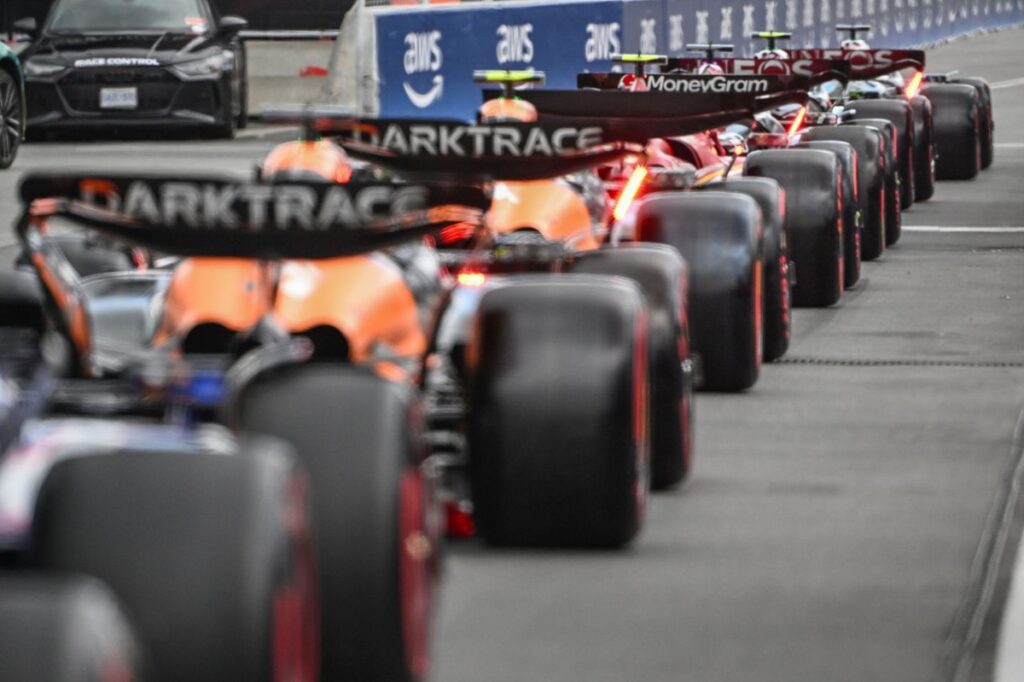Red Bull Racing RB20 detail
Photo by: Giorgio Piola
A close-up of the Red Bull RB20’s rear end, featuring a downward sloping surface at the tail end of the engine cover. It’s also apparent how the semi-detached tip section sits ahead of the upper flap line and reaches out over the mainplane to expose more of the endplate cutout.
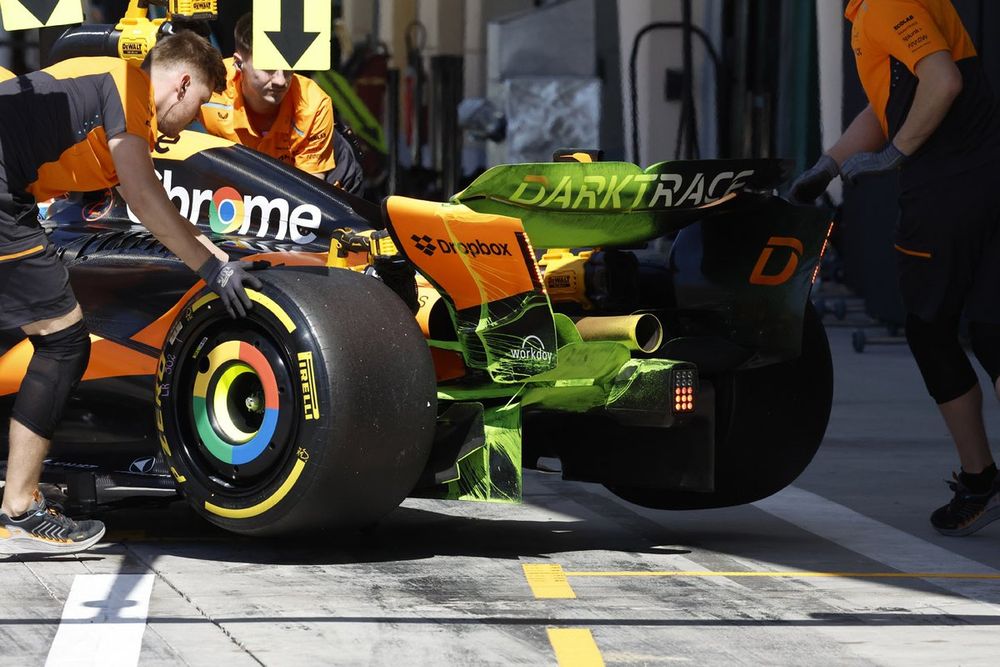
McLaren MCL38 detail
Photo by: Uncredited
The McLaren MCL38 with flo-viz paint on the rear wing, beam wing and diffuser, as the team looks to get visual confirmation that they’re performing as anticipated.
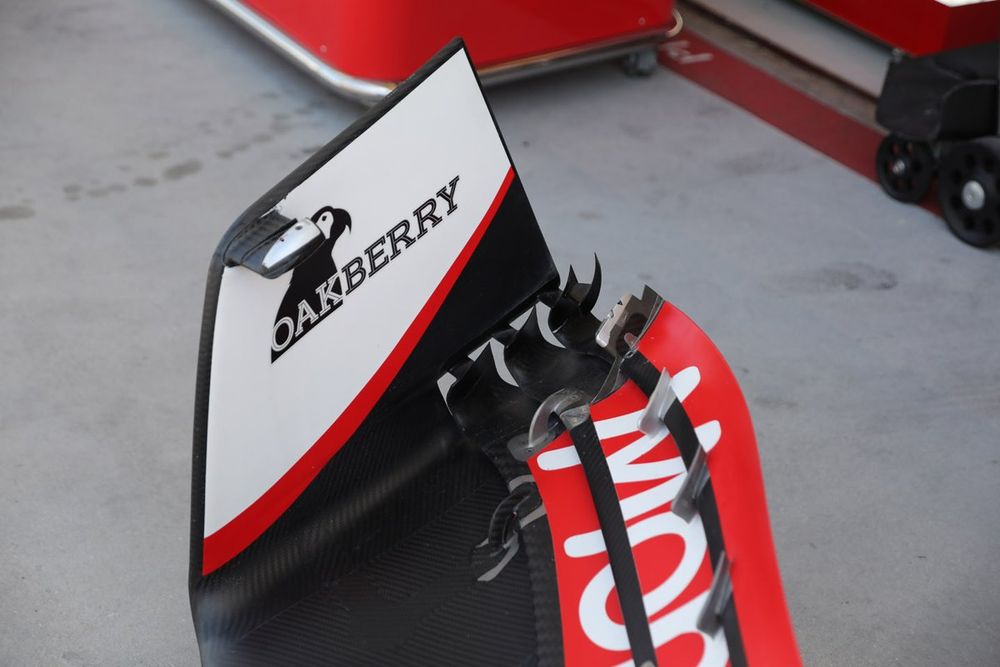
Haas VF-24 detail
Photo by: Giorgio Piola
A good angle of the Haas VF-24’s front wing, showing the winglet-like slot gap separator brackets mounted between the two upper flaps, the semi-detached and twisted flap tips and the outwardly angled winglet mounted above all assist with outwash.
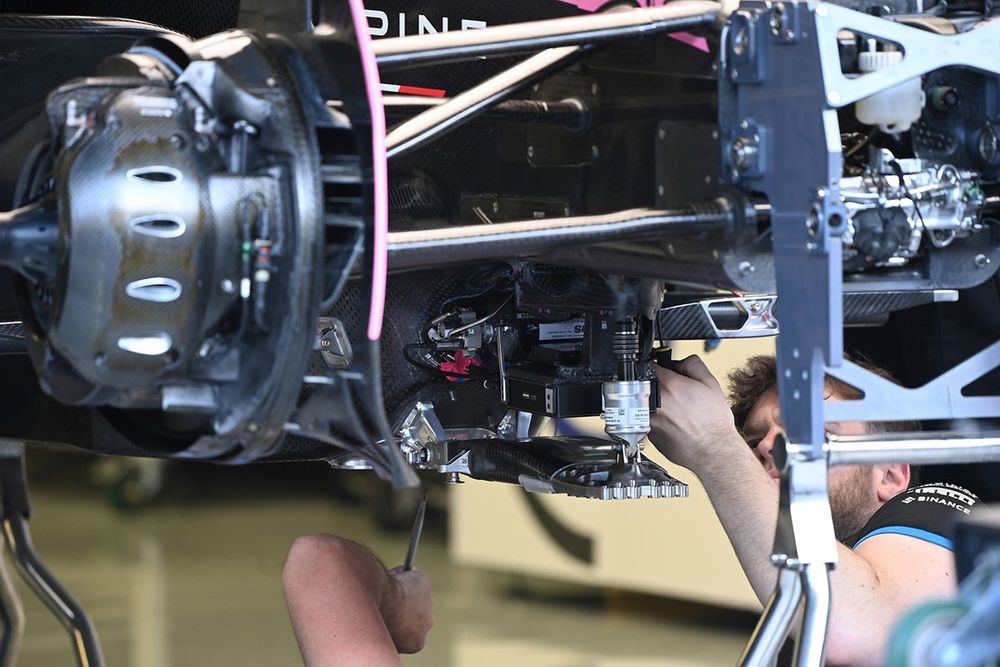
Alpine A524 detail
Photo by: Uncredited
A look at the bib’s construction and the sprung mechanism mounted between it and the chassis on the Alpine A524, while some of the other ancillaries are also packed in the region.
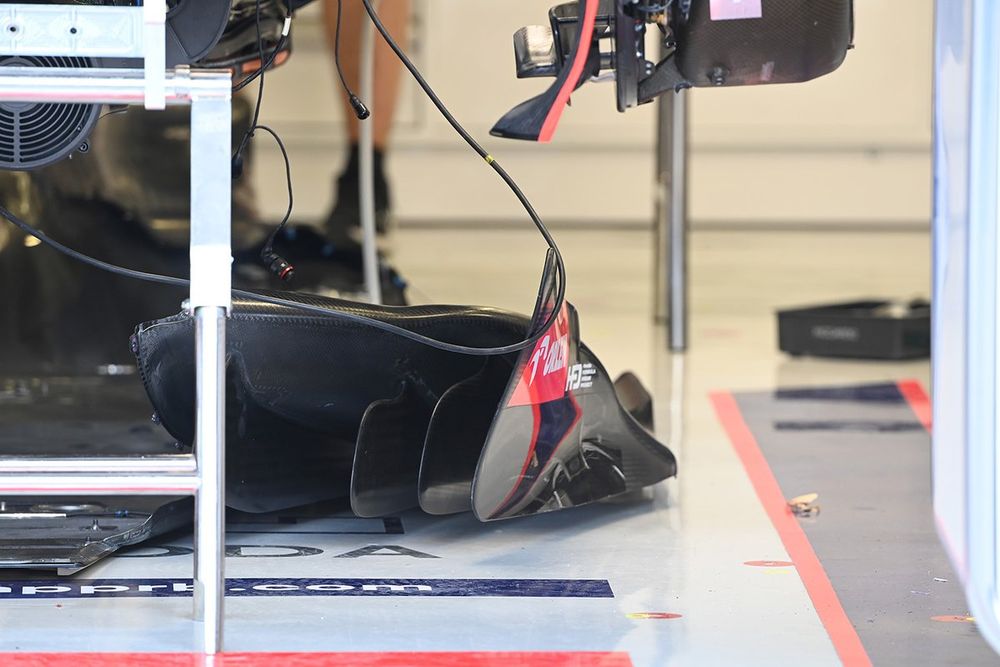
VCARB RB01 detail
Photo by: Uncredited
A look at the floor’s leading edge on the VCARB01, noting the spacing of the fences, with one of the three interior fences positioned inboard, while the other two are more paired up with the outer fence.
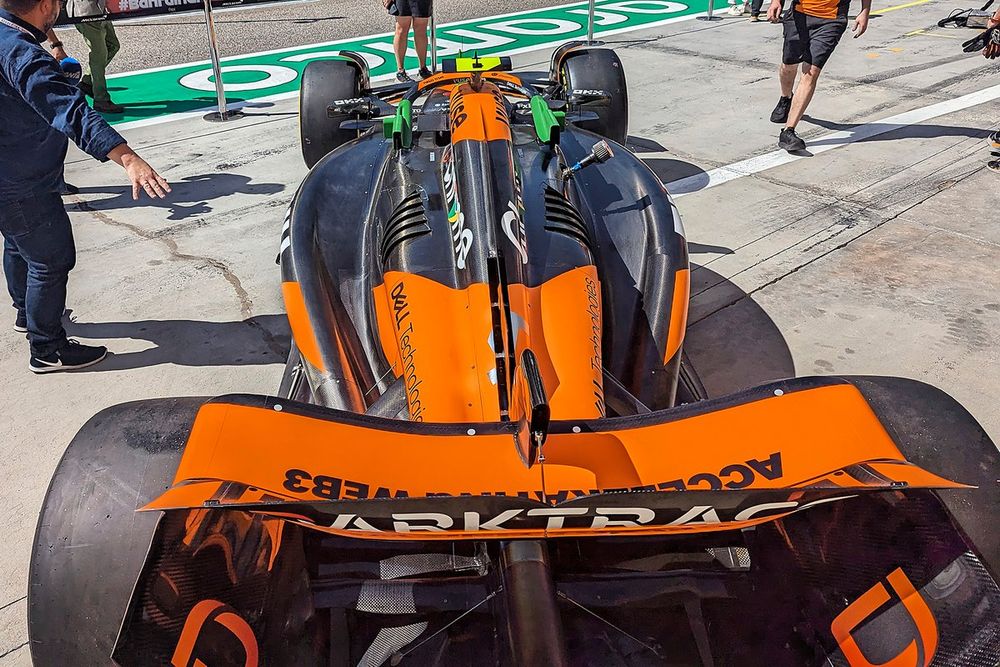
McLaren MCL38 detail
Photo by: Filip Cleeren
An unusual view of the McLaren MCL38 over the rear wing shows the sidepods and the gullies that run down their length.
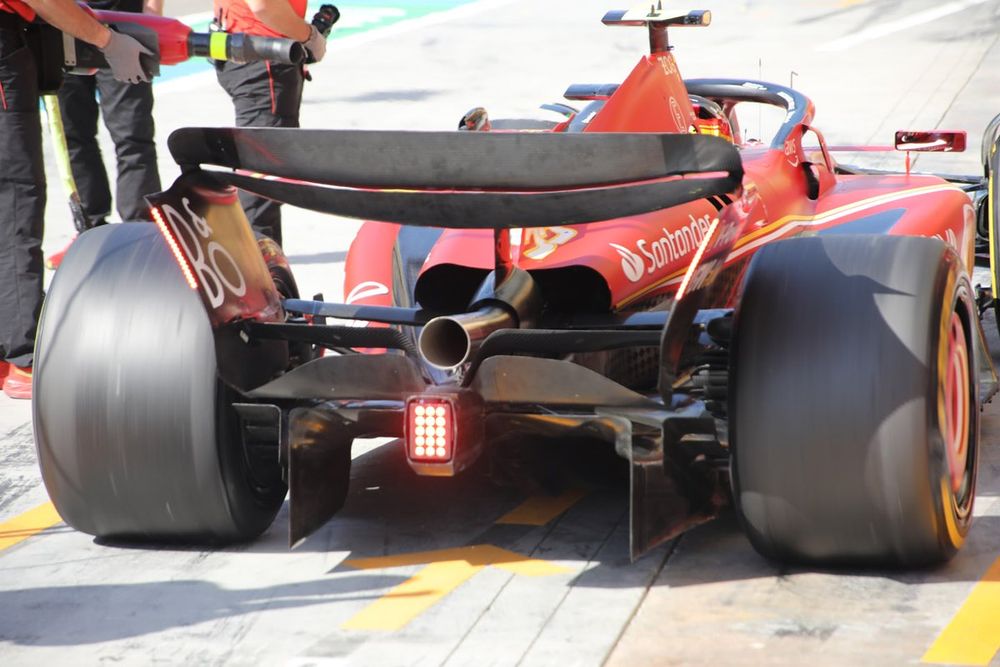
Ferrari SF-24 detail
Photo by: Giorgio Piola
An overview of the Ferrari SF-24’s rear end in Bahrain, with a bi-plane style beam wing arrangement, medium downforce spoon-shaped rear wing and a decent view of the contouring of the diffuser’s ceiling.
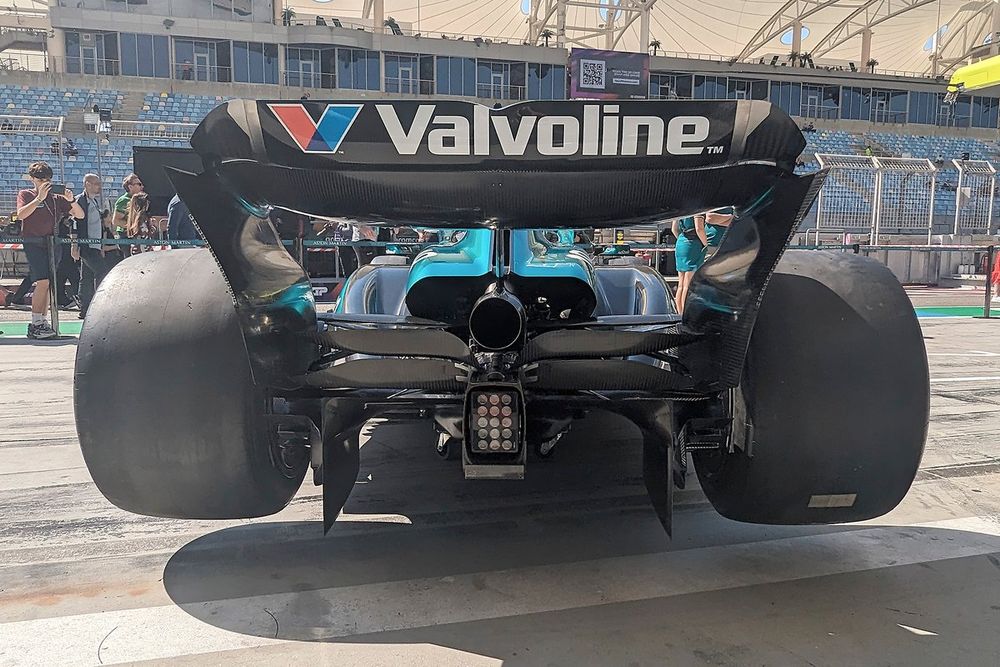
Aston Martin AMR24 rear detail
Photo by: Filip Cleeren
A similarly decent view of the Aston Martin AMR24’s rear end, including the double element beam wing and centreline cooling, which includes a cutout along the engine cover’s spine.
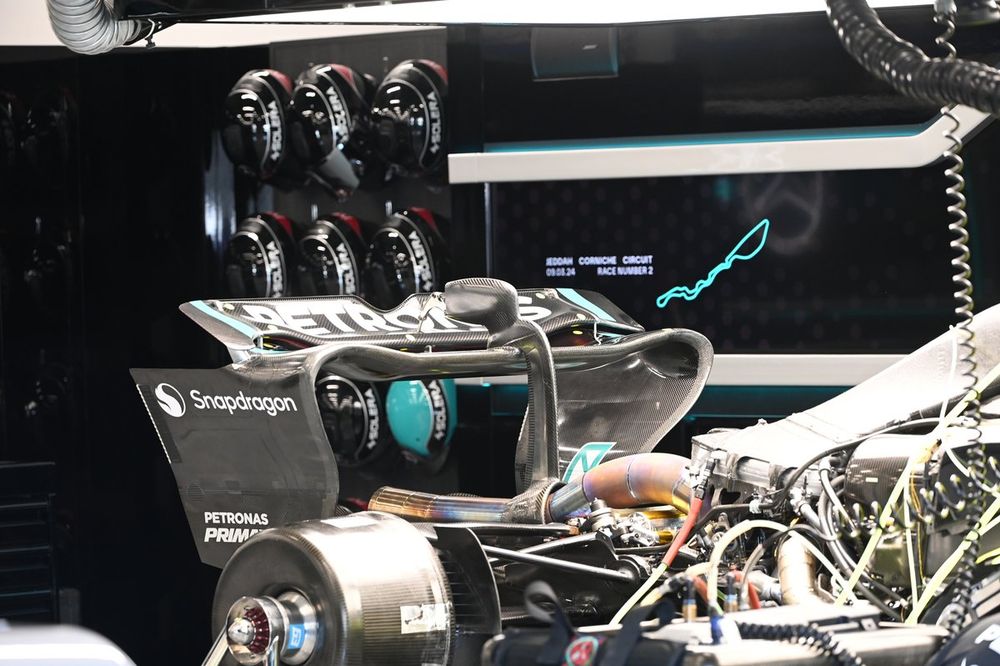
Mercedes W15 technical detail
Photo by: Uncredited
A low downforce rear wing for Mercedes in Saudi Arabia, with a large notch cut out in the centre of the upper flap, a more relaxed flap angle, a mainplane that takes up much less of the allowable box region and a semi-detached tip section that reaches forward over the mainplane section of the endplate.
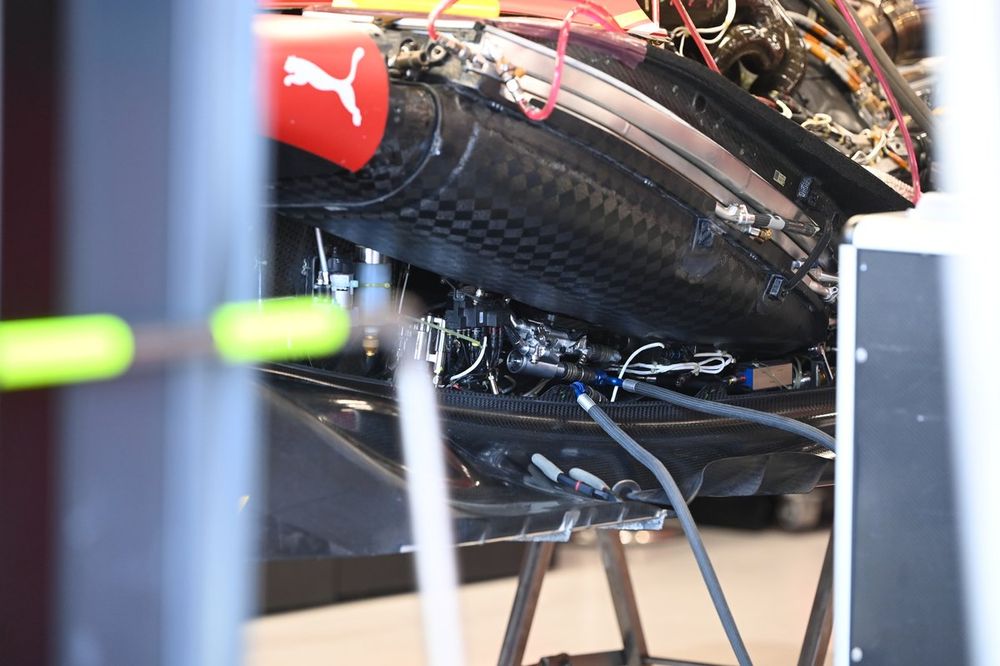
Ferrari SF-24 technical detail
Photo by: Uncredited
A peek underneath the Ferrari SF-24’s sidepod bodywork reveals the location of some of the electronics, hydraulics and coolers housed within.
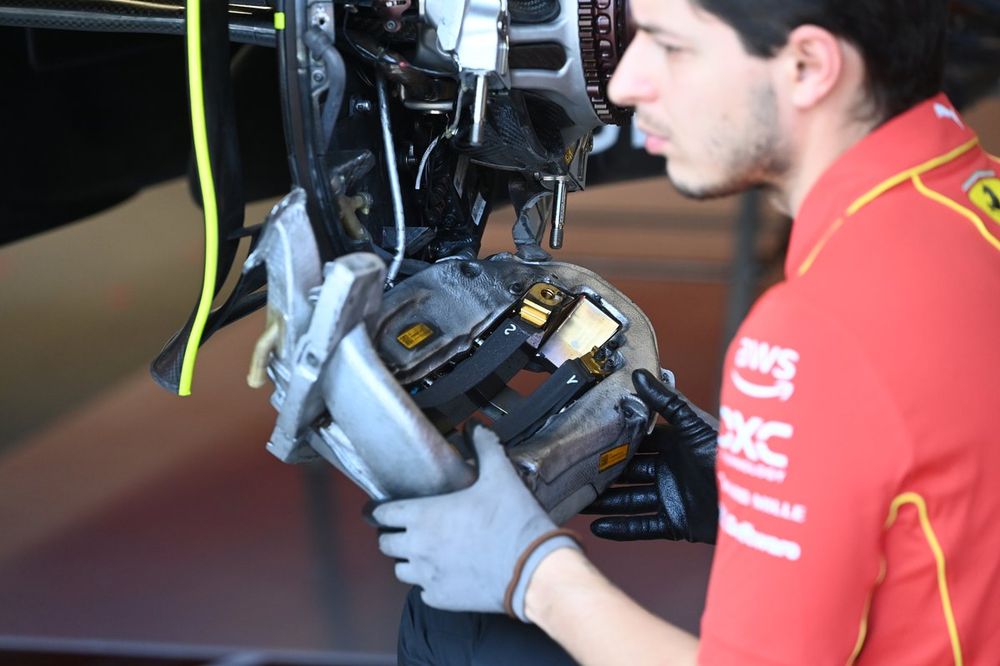
Ferrari SF-24 technical detail
Photo by: Uncredited
A Ferrari mechanic prepares to install the front brake calliper, which already has the cooling fairing attached.
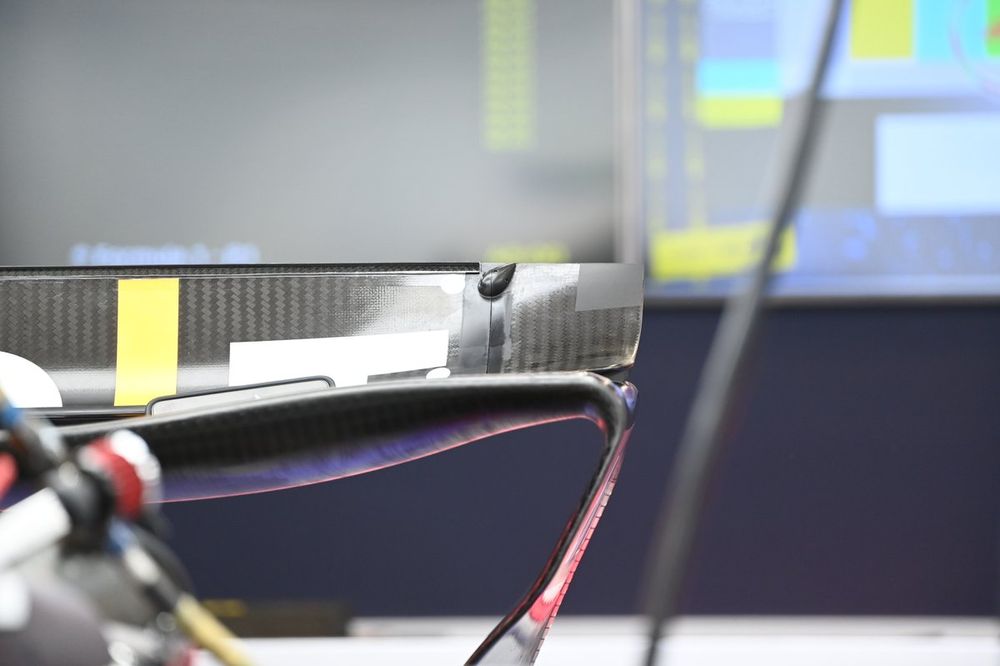
Red Bull Racing RB20 technical detail
Photo by: Uncredited
A close-up of the corner of the rear wing on the Red Bull RB20, with its semi-detached, squared-off tip section and teardrop-shaped flap pivot. This is split to allow the flap to rotate when DRS is active but offers a different aerodynamic response than a barrel-style flap pivot when in the closed position.
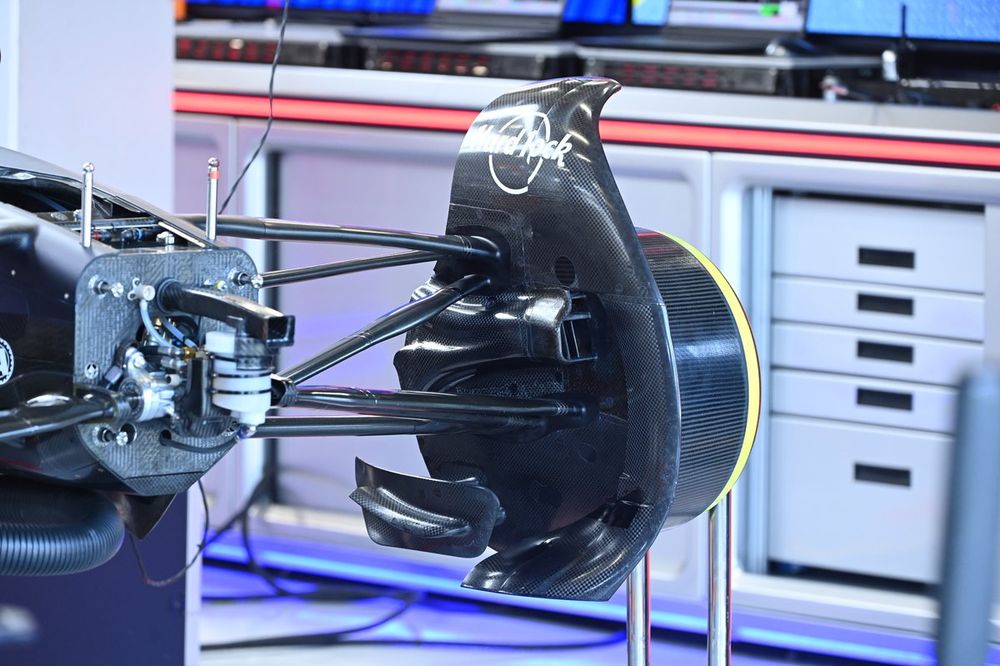
Red Bull Racing RB20 front brake drum detail
Photo by: Uncredited
A look at the extremely sculpted brake duct inlet and outlet on the Red Bull RB20, with aerodynamic consideration applied to both the internal and external features of both.
Also, note the V-shaped profile of the underside of the chassis and the driver cooling ducting that’s protruding out from the bulkhead in order to mate internally with the nose segment.
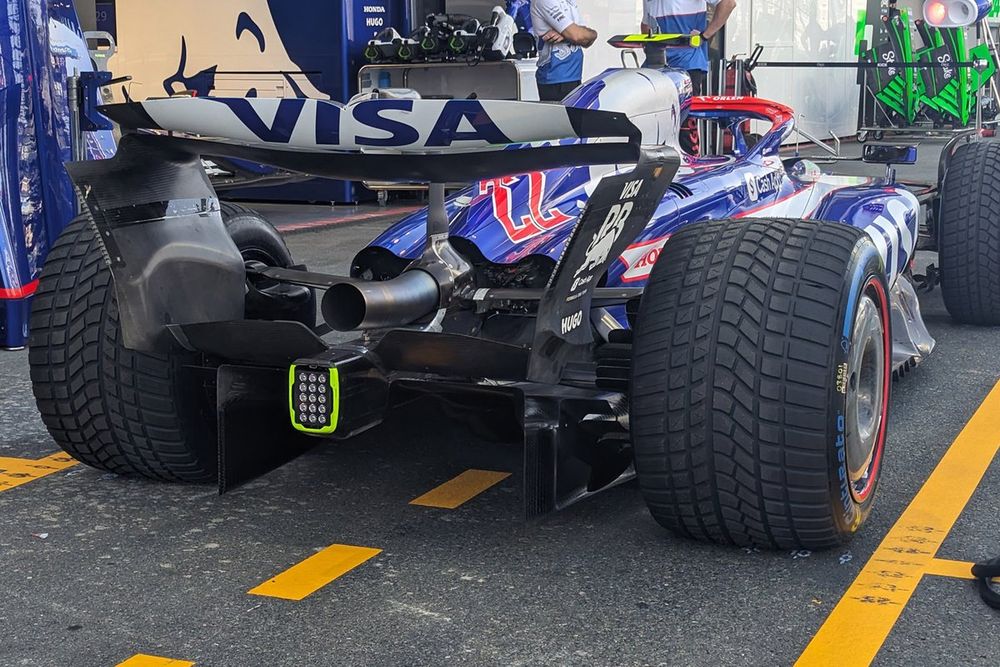
RB F1 Team VCARB 01 detail
Photo by: Filip Cleeren
In Saudi Arabia the VCARB01 with a large single-element beam wing and a reduced capacity spoon-shaped rear wing. Also note the stepped and cutout lower rear edge of the brake duct winglet and the deep, upwashing swage line incorporated into the rear wing endplate.
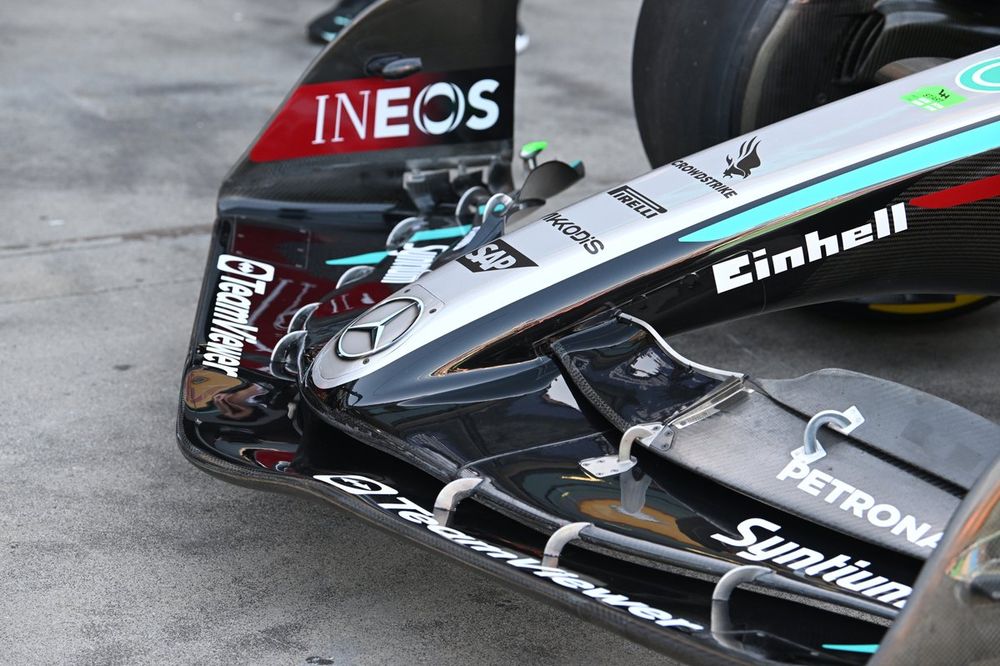
Mercedes W15 front wind detail
Photo by: Uncredited
Mercedes’s original front wing design for 2024 featured a slender inboard flap section to maintain legality and offer a different set of design parameters for the other sections of the wing around it.
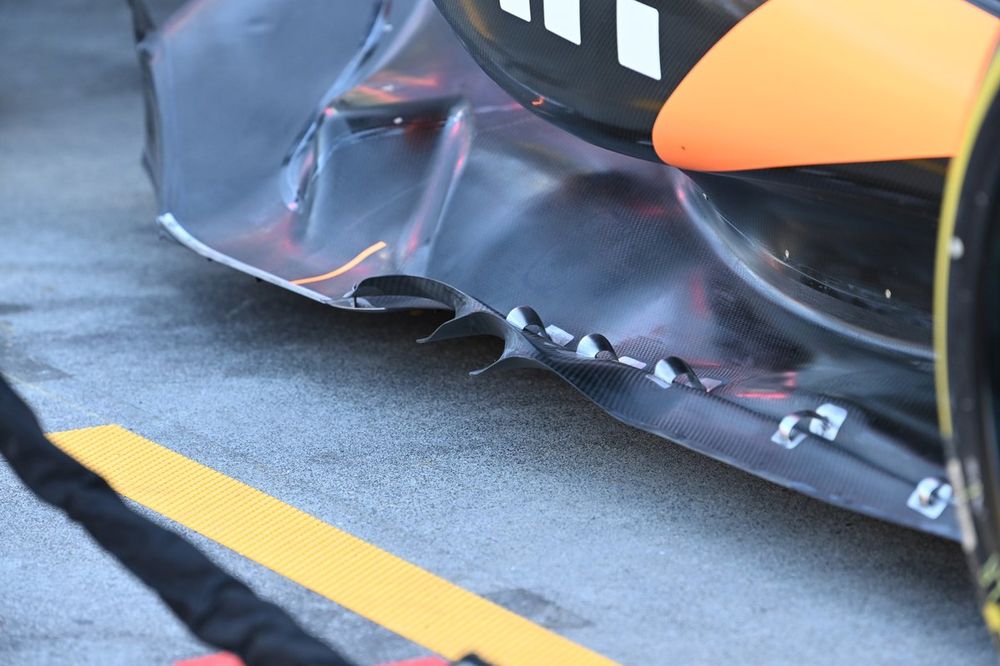
McLaren MCL38 detail
Photo by: Uncredited
This shot gives an interesting vantage point of the forward, upwardly angled and twisted geometry of the edge wing, which has two strakes embedded within the surface to aid in extraction.
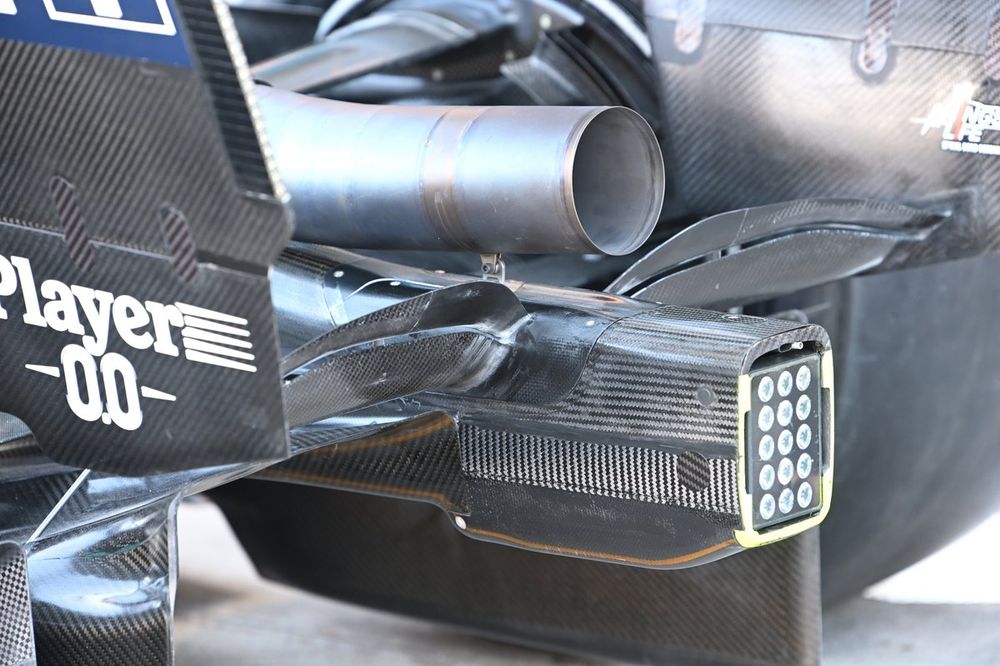
Red Bull Racing RB20 detail
Photo by: Uncredited
A conventionally stacked beam wing arrangement at the rear of the Red Bull RB20, albeit with a short chord on both elements. Also note the breather pipe is routed through the crash structure, with the outlet sitting in the void above the rain light.
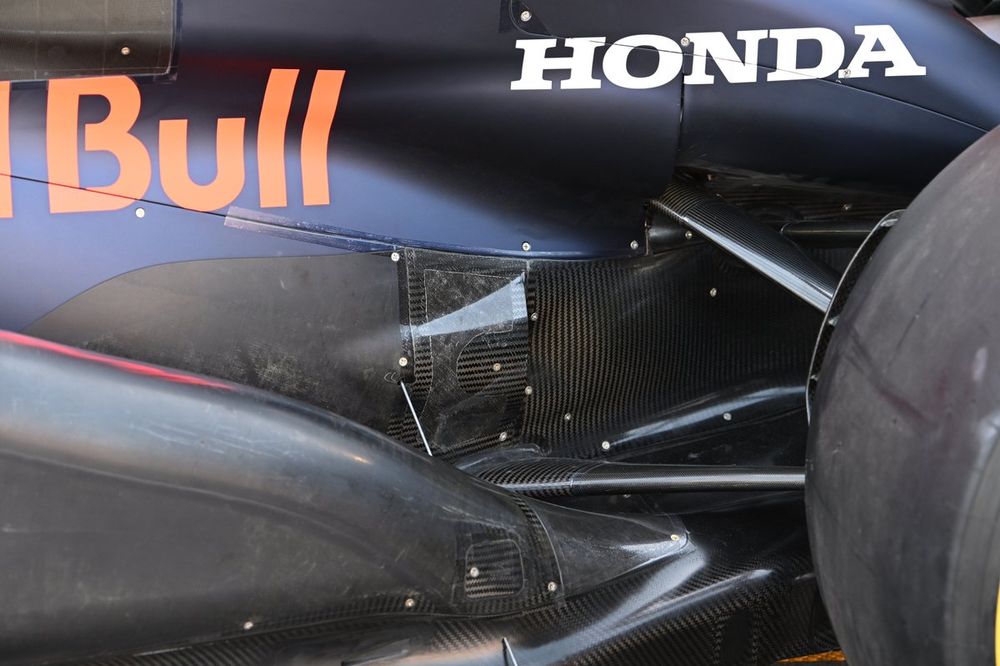
Red Bull Racing RB20 detail
Photo by: Uncredited
A smaller, additional, cooling outlet could be found around the lead arm of the rear suspension’s lower wishbone on the Red Bull RB20.
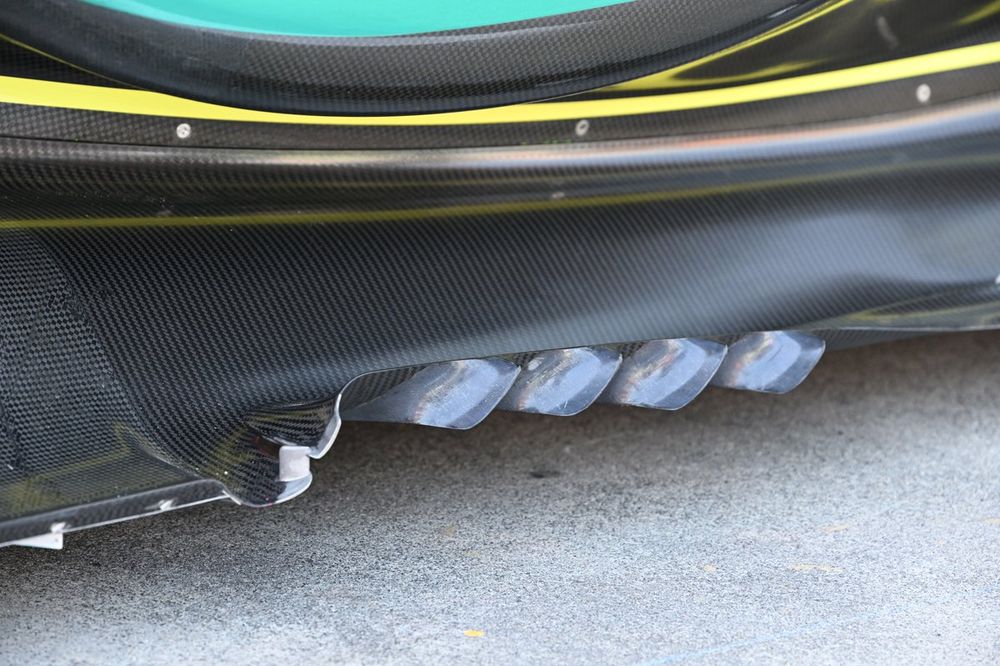
Aston Martin AMR24 detail
Photo by: Uncredited
The forward curled profile on the Aston Martin AMR24’s floor edge is complimented by four angled strakes to improve extraction.
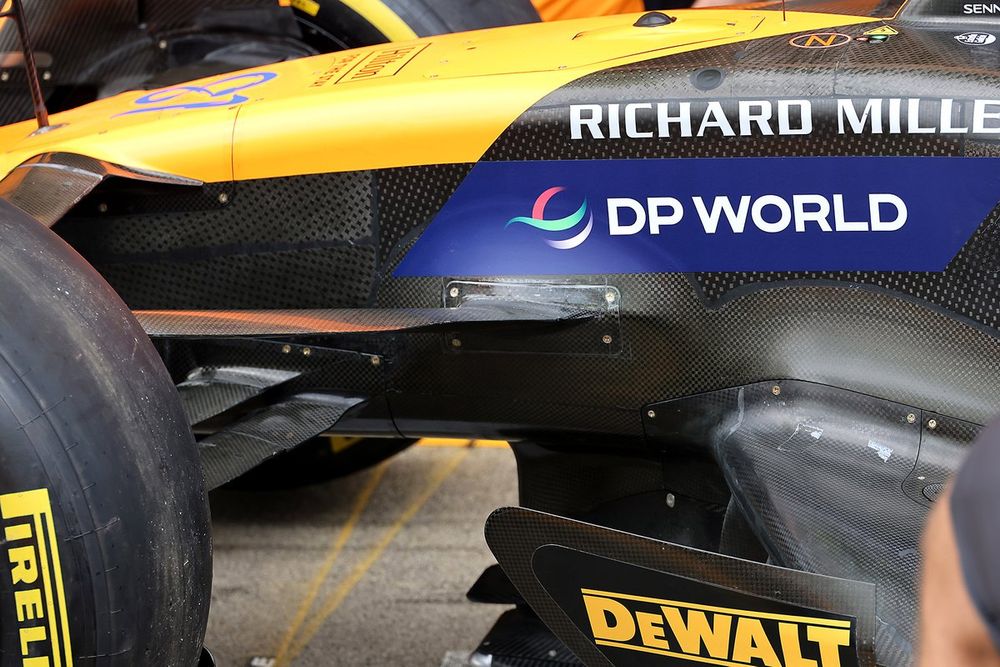
McLaren MCL38 technical detail
Photo by: Giorgio Piola
The low and rearward mounted rear leg of the upper wishbone on the McLaren MCL38’s front suspension is done for aerodynamic purposes.
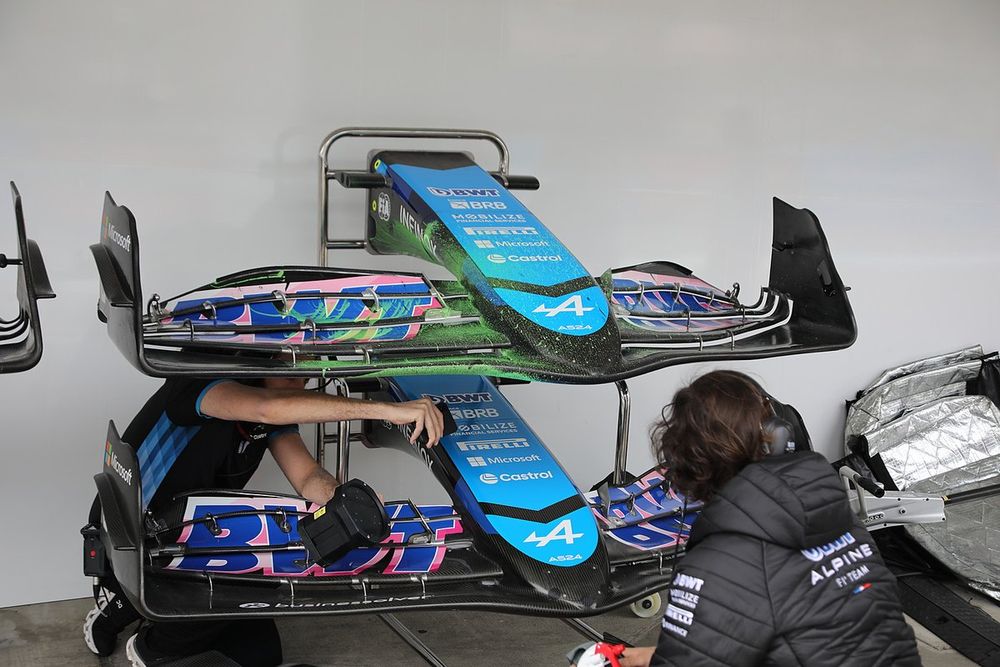
Alpine A524 technical detail
Photo by: Giorgio Piola
An Alpine mechanic takes photos of the underside of the nose and front wing that’s been out on track with the surface sprayed with flo-viz paint.
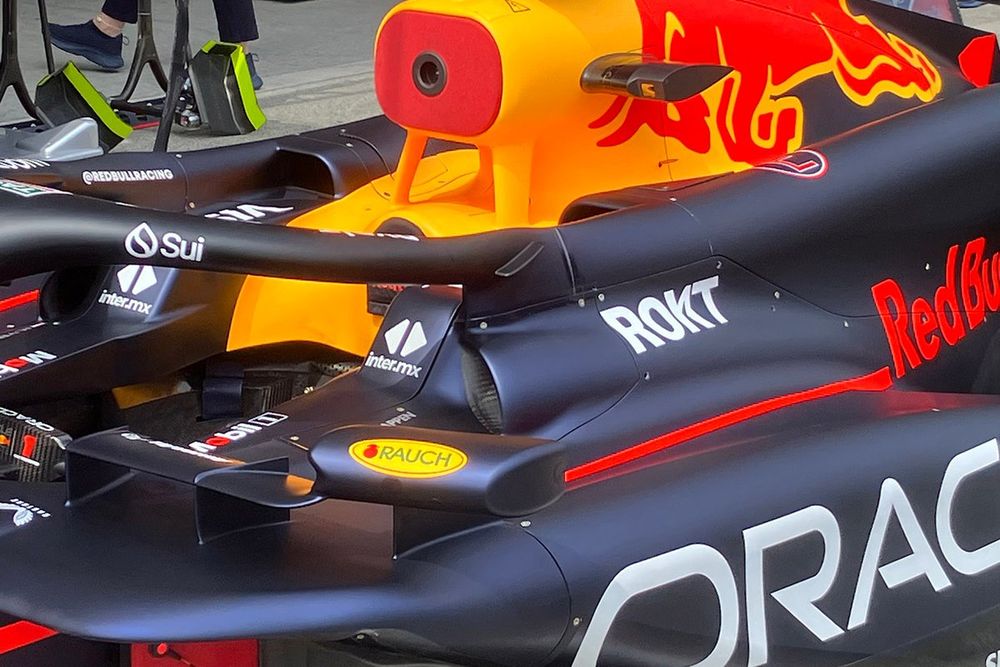
Red Bull Racing RB20 technical detail
Photo by: Jon Noble
A close-up of the two inlets on either side of the halo’s rear leg, one on top of the sidepod and the other behind the driver’s head and alongside the airbox.
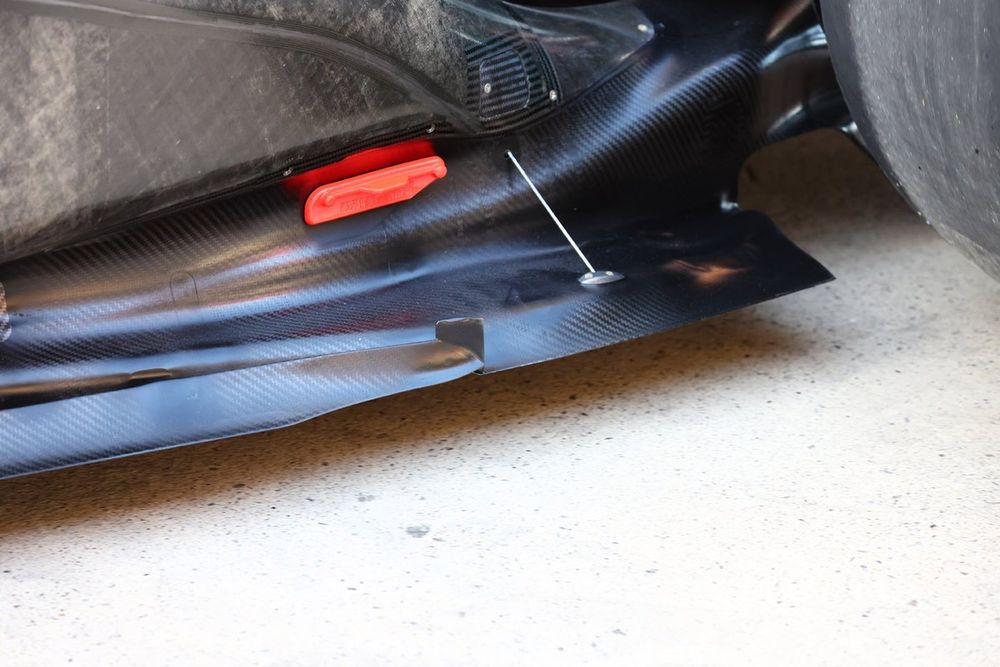
Red Bull Racing RB20 technical detail
Photo by: Giorgio Piola
A close-up of the vertical tab on the rear corner of the Red Bull RB20’s edge wing.
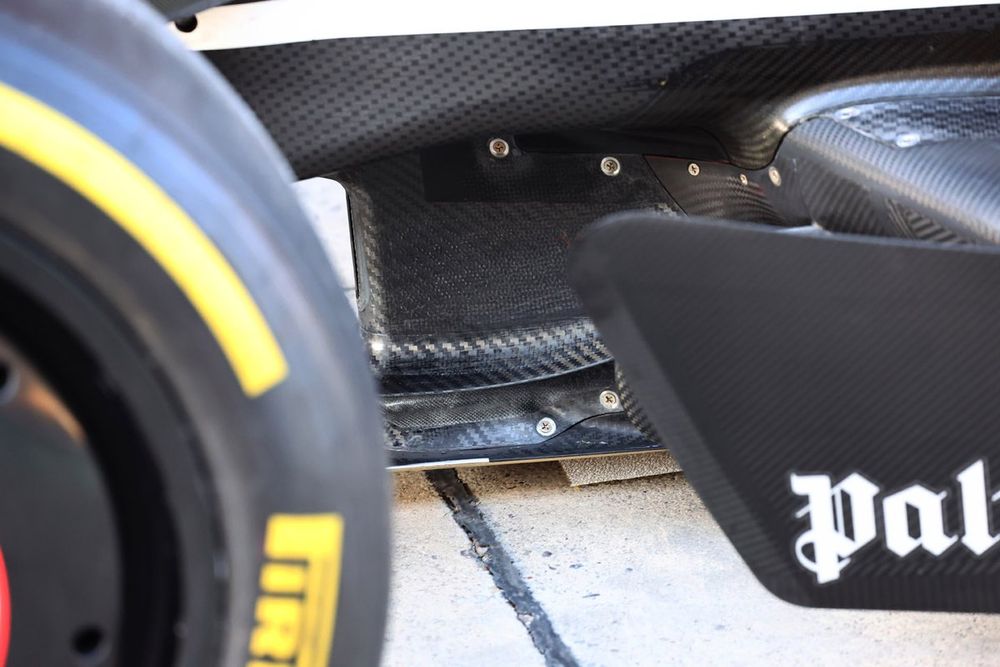
Haas VF-24 technical detail
Photo by: Giorgio Piola
The bib winglet can be spotted in the background of this image on the Haas VF-24, a feature that most of the grid now had in one format or another.
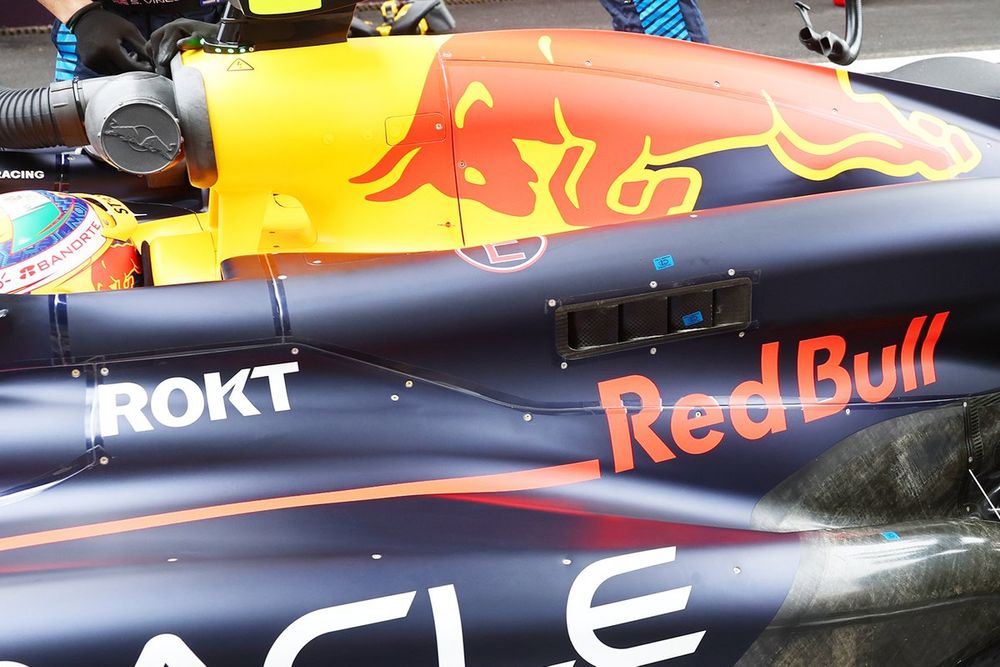
Red Bull Racing RB20 technical detail
Photo by: Giorgio Piola
Red Bull began to tidy up the appearance of the louvred panel on the side of the RB20’s engine cover as the season progressed, having had more of an ad-hoc arrangement in the opening rounds.
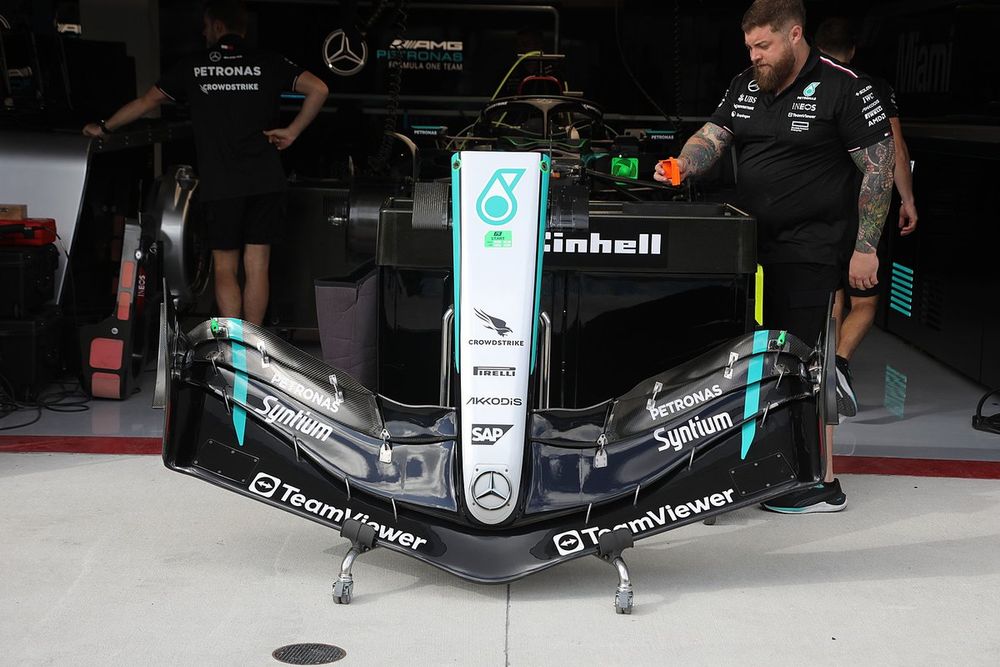
Mercedes F1 W15 front wing detail
Photo by: Giorgio Piola
A top-down overview of the Mercedes W15’s front wing shows how the strip-like inboard upper element allows the rest of the flap to taper down aggressively toward the flap pivot.
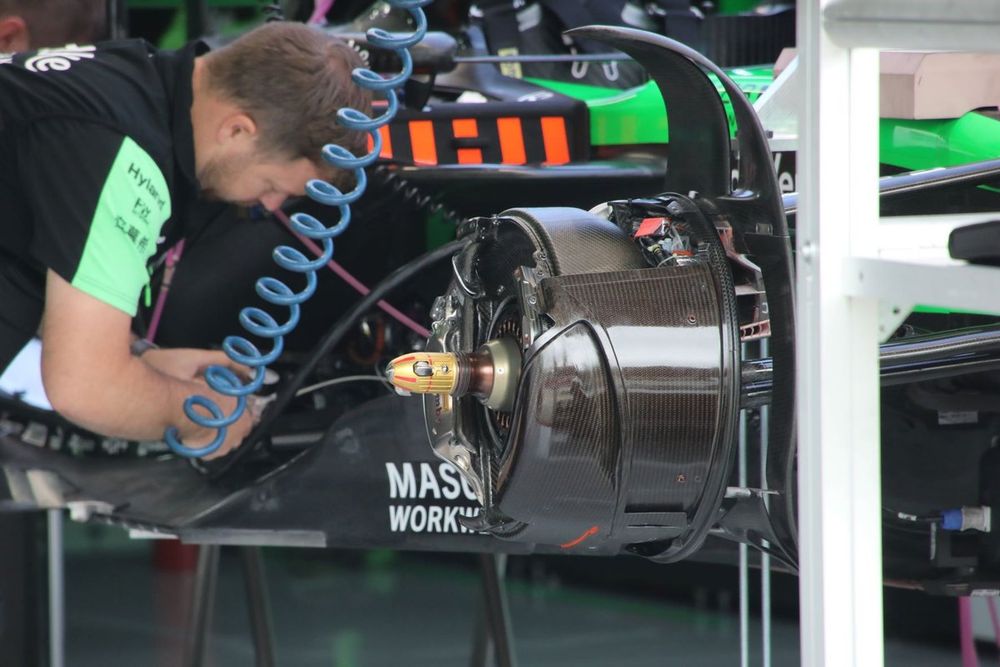
Kick Sauber C44 technical detail
Photo by: Giorgio Piola
A look at some of the lower layers within the nest of elements that make up the brake duct on the Sauber C44 and help to cool the various components and alter the thermal interaction between them and the wheel rim.
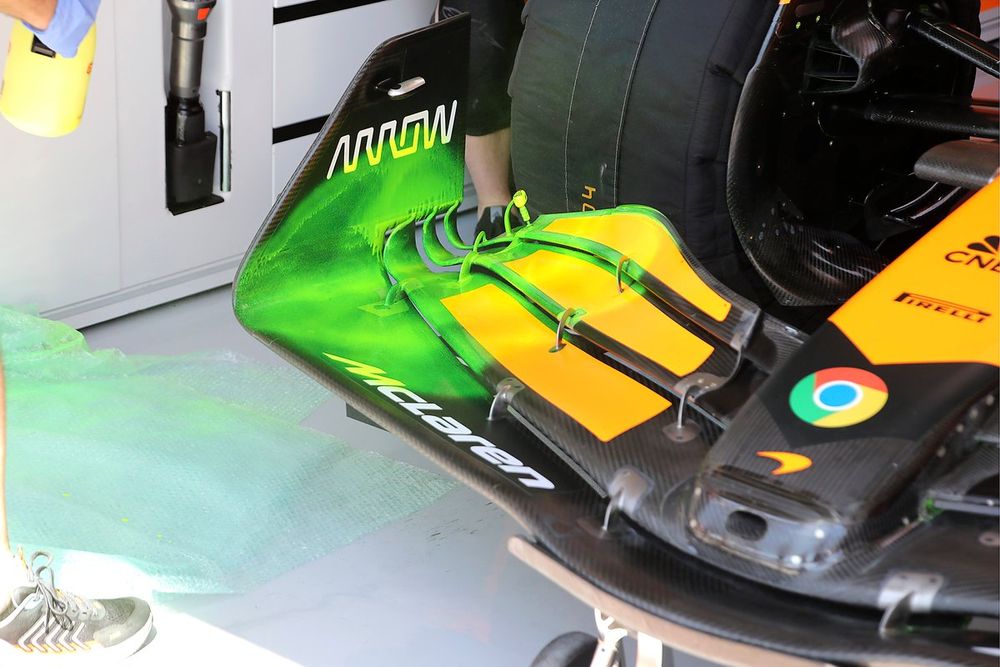
McLaren MCL38 front wing detail
Photo by: Giorgio Piola
The McLaren MCL38’s front wing has flo-viz paint applied to the outermost corner so that upon its return to the garage the team can capture visual confirmation that it’s performing as expected.
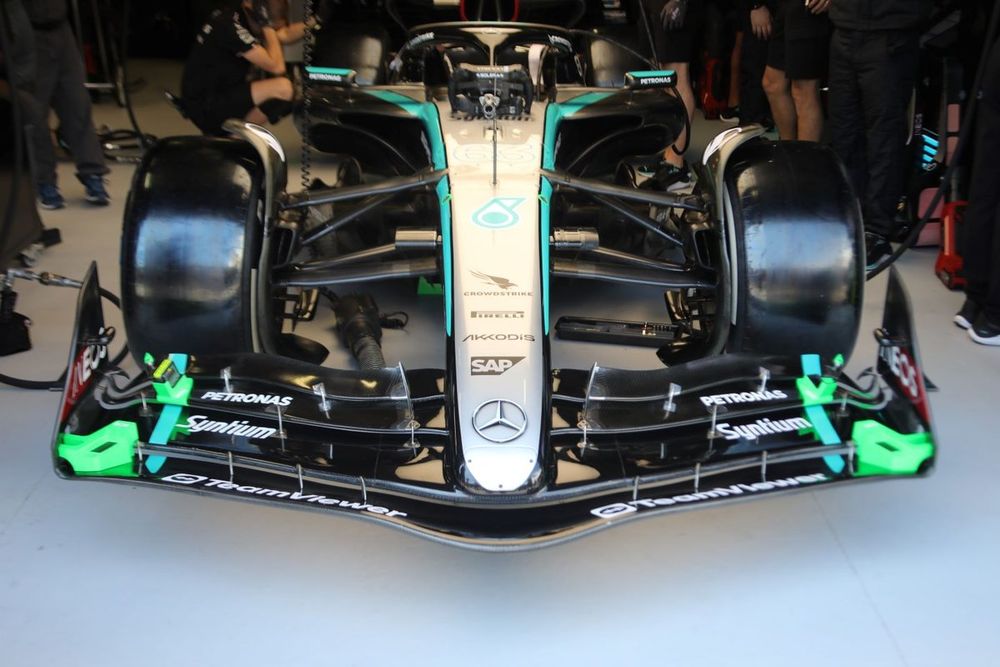
Mercedes W15 technical detail
Photo by: Giorgio Piola
Mercedes introduced a new front wing specification at the Monaco Grand Prix, with the slender upper flap at the inboard end of the wing returned to a more conventional chord height, while the entire span of the upper flaps was adjusted accordingly.
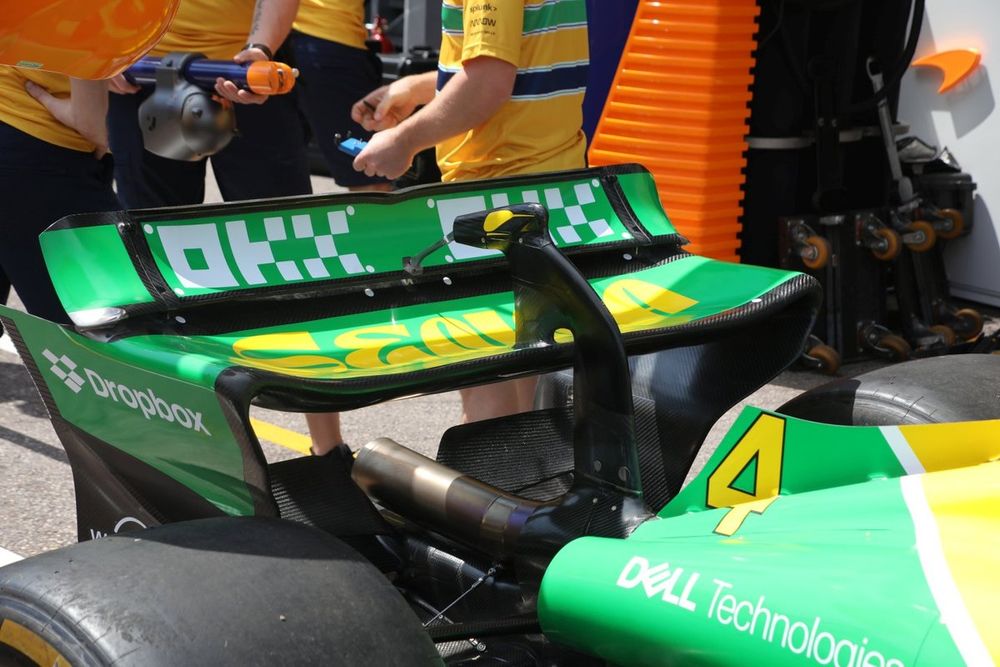
McLaren MCL38 technical detail
Photo by: Giorgio Piola
McLaren’s high-downforce rear wing arrangement for the Monaco Grand Prix featured elements that took up more space within the allowable box region across the entire span of the assembly than any of their other designs.
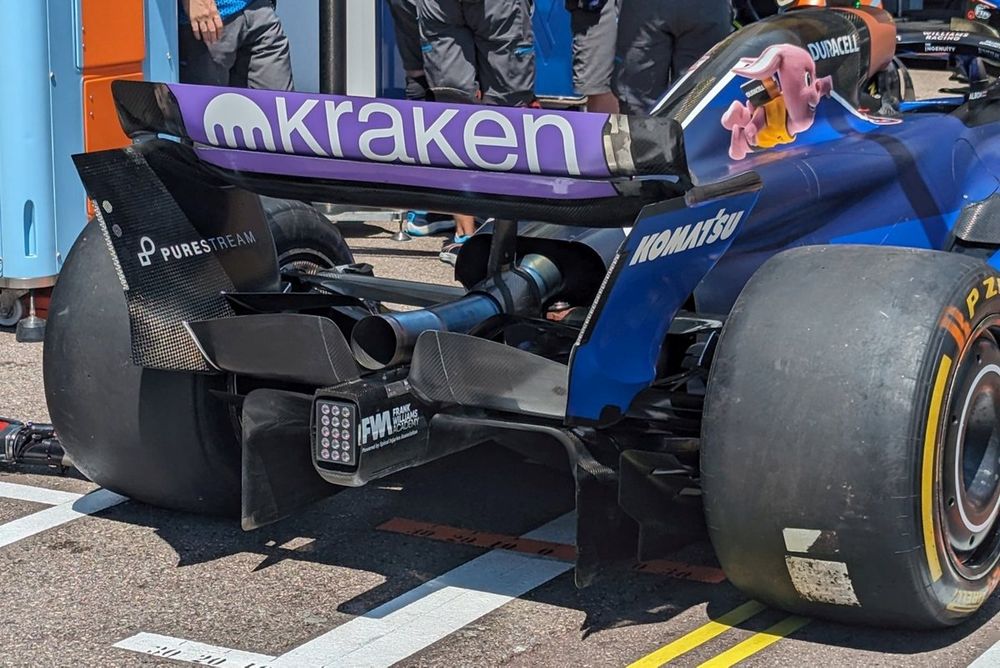
Williams FW46 technical detail
Photo by: Filip Cleeren
The high-downforce arrangement at the rear of the Williams FW46 for Monaco included a bi-plane style beam wing arrangement with an extraordinarily large lower element.
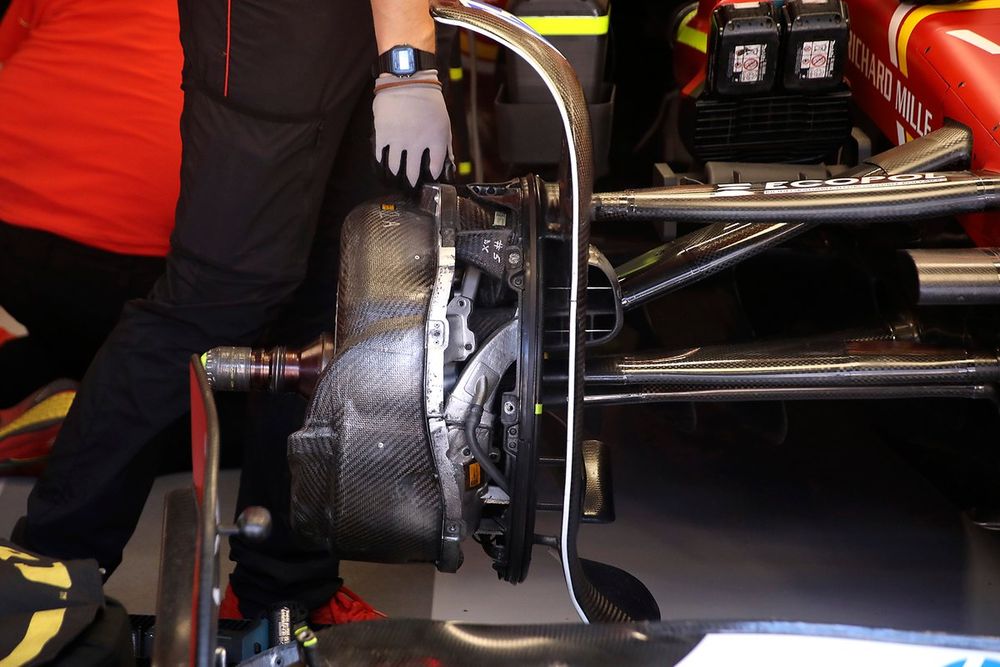
Ferrari SF-24 technical detail
Photo by: Giorgio Piola
A shot of the internal brake disc and calliper fairing at the front of the Ferrari SF-24.

Red Bull Racing RB20 technical detail
Photo by: Giorgio Piola
Flo-viz paint on the rear wing, beam wing and diffuser of the Red Bull RB20, as the team looks for visual confirmation that their performance is as expected.
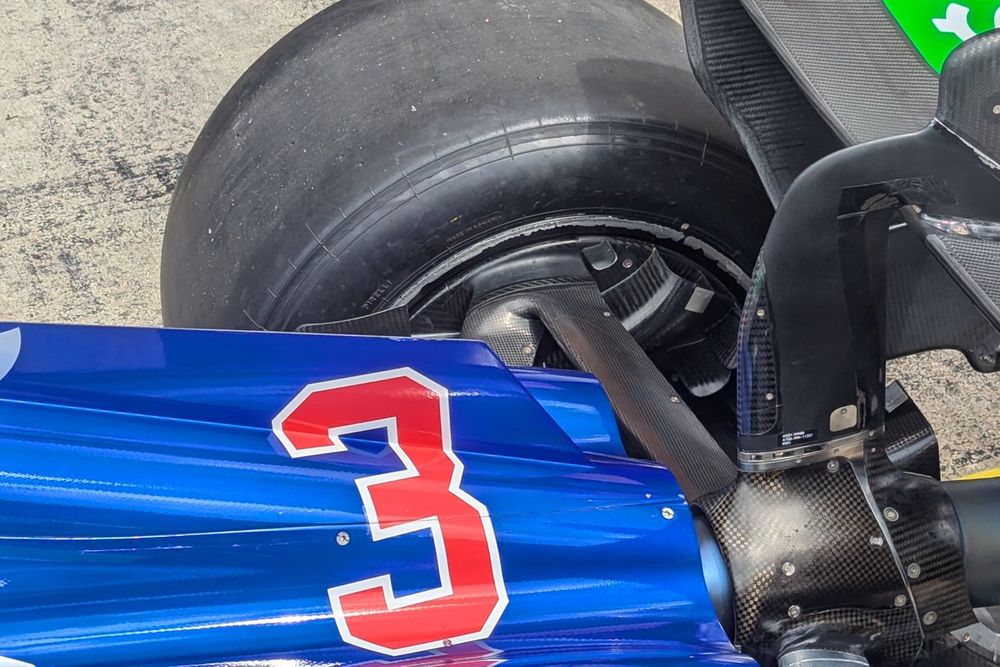
RB F1 Team VCARB 01 technical detail
Photo by: Filip Cleeren
Considerable effort is made by the teams, RB in this instance, to design the brake duct furniture and rear suspension fairings in order to work in unison and extract the maximum amount of performance.
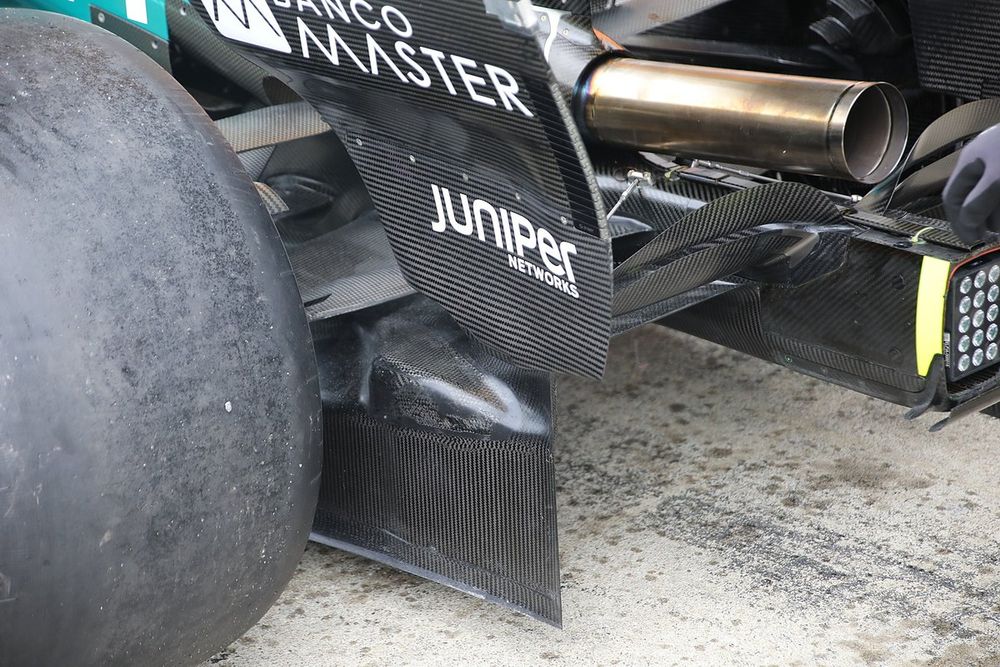
Aston Martin AMR24 rear detail
Photo by: Giorgio Piola
A close-up of the rear end of the Aston Martin AMR24, including the outboard step in the diffuser, the twin-element winglet arrangement on the back of the crash structure and the flat breather pipework on top.
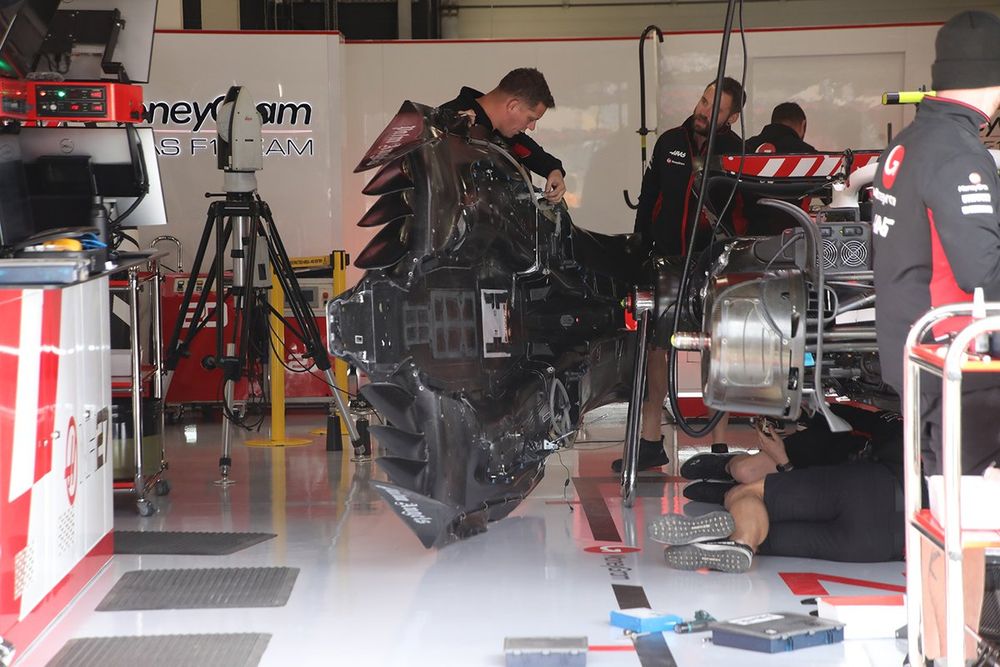
Haas VF-24 detail
Photo by: Giorgio Piola
An interesting view of the Haas VF-24’s floor, including the leading edge and floor fence geometry, as the mechanic works on the securing brackets.
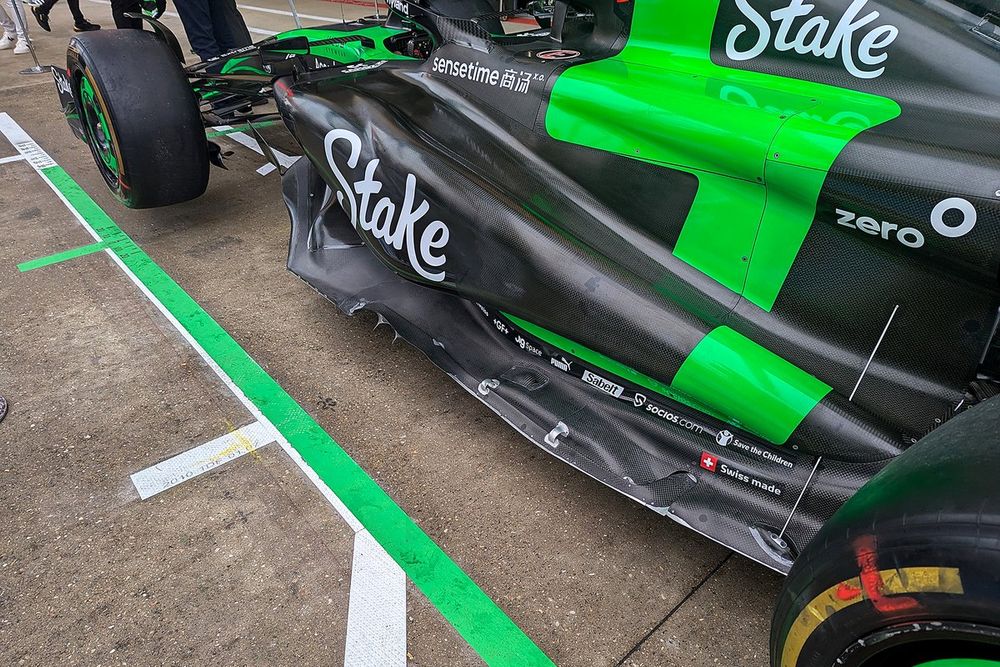
Kick Sauber C44 technical detail
Photo by: Filip Cleeren
A three-quarter view of the Sauber C42 gives a good impression of how the sidepod bodywork is sculpted and the detailed work done on the floor’s edge.
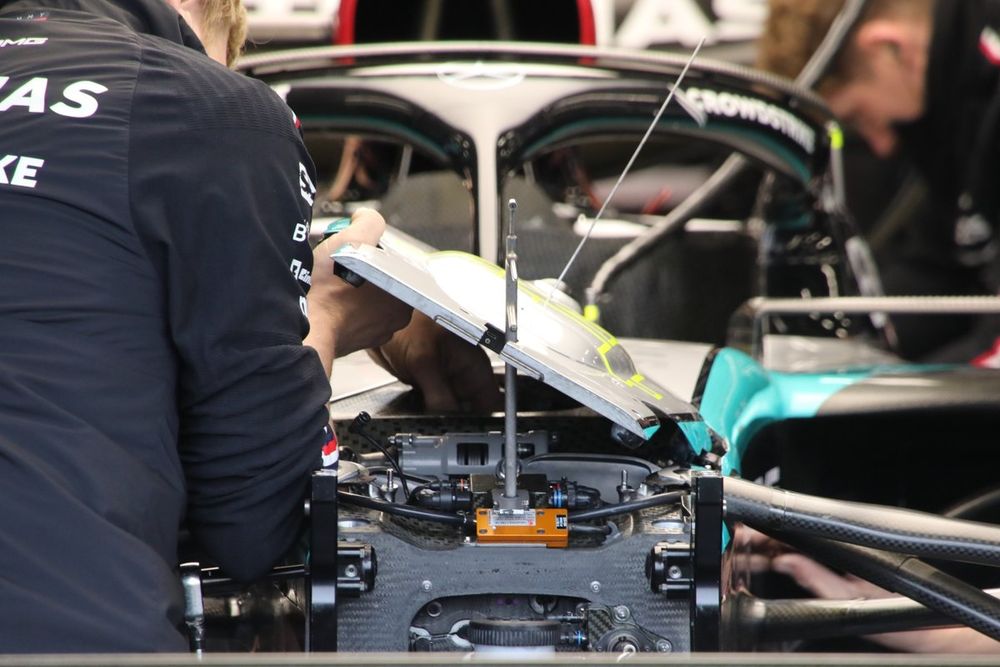
Mercedes W15 technical detail
Photo by: Giorgio Piola
A Mercedes mechanic lifts the vanity panel to work on the inboard suspension elements housed beneath.
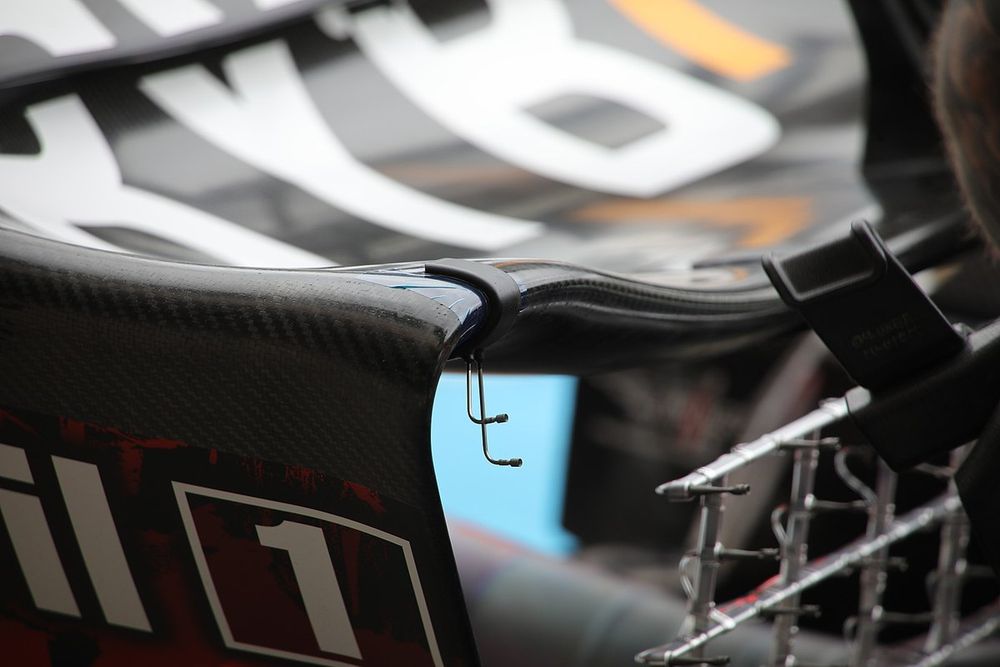
Red Bull Racing RB20 technical detail
Photo by: Giorgio Piola
The Red Bull RB20 is fitted with a kiel probe rake ahead of the rear wing, while a small two-probe array is hung in the endplate and mainplane juncture to help gather data on how the airflow behaves around the assembly.
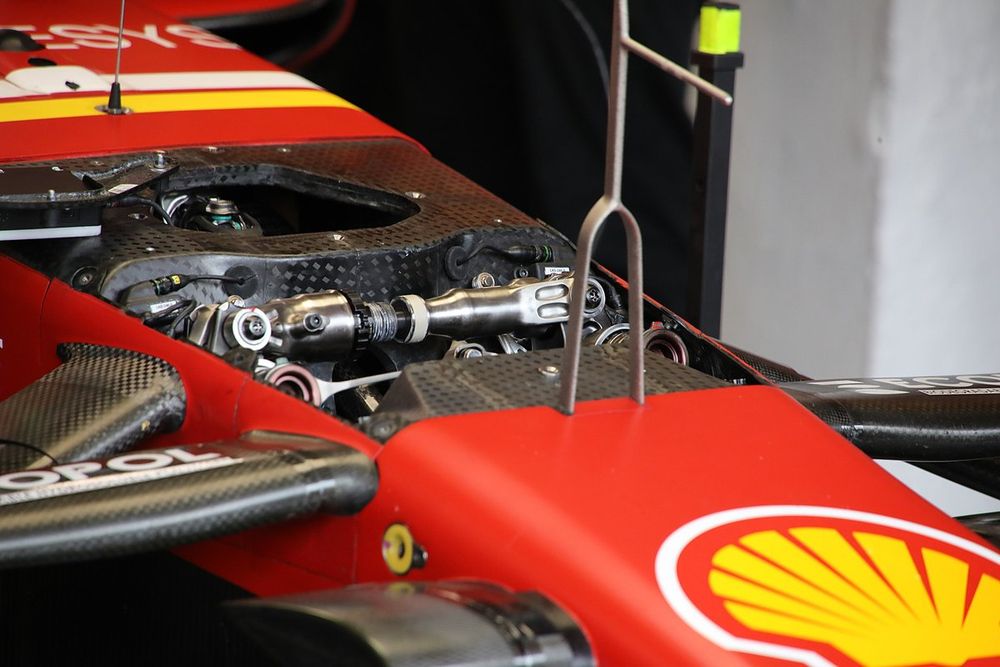
Ferrari SF-24 technical detail
Photo by: Giorgio Piola
A close-up of some of the inboard front suspension components on the Ferrari SF-24, including the heave damper.
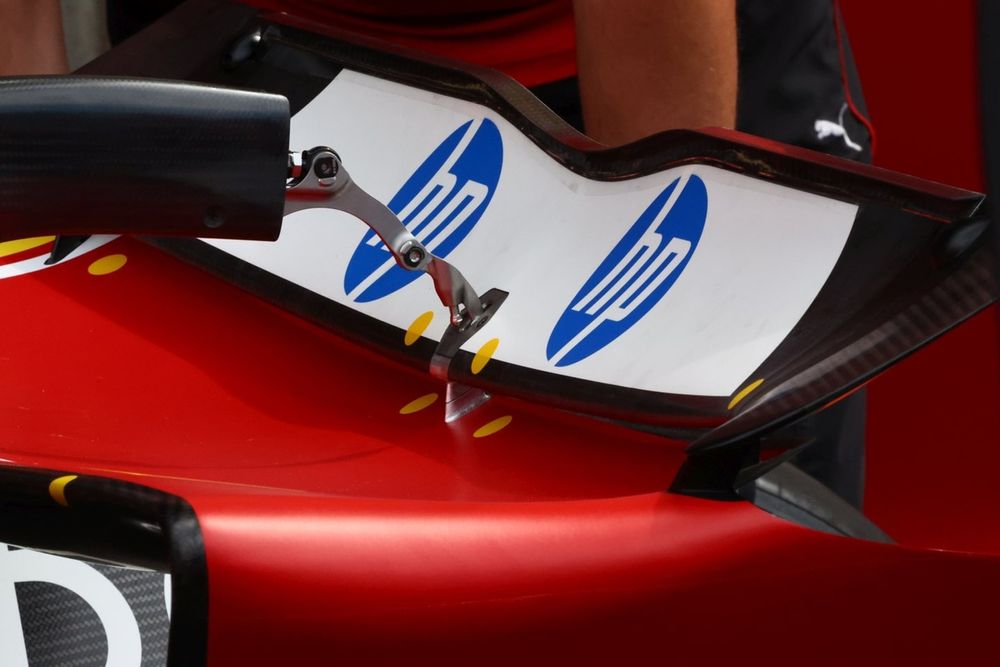
Ferrari SF-24 technical detail
Photo by: Giorgio Piola
A close-up of the rear wing’s upper flap on the Ferrari SF-24 at the Hungarian Grand Prix, which includes a large Gurney flap on the trailing edge of the upper flap to increase downforce and improve balance.
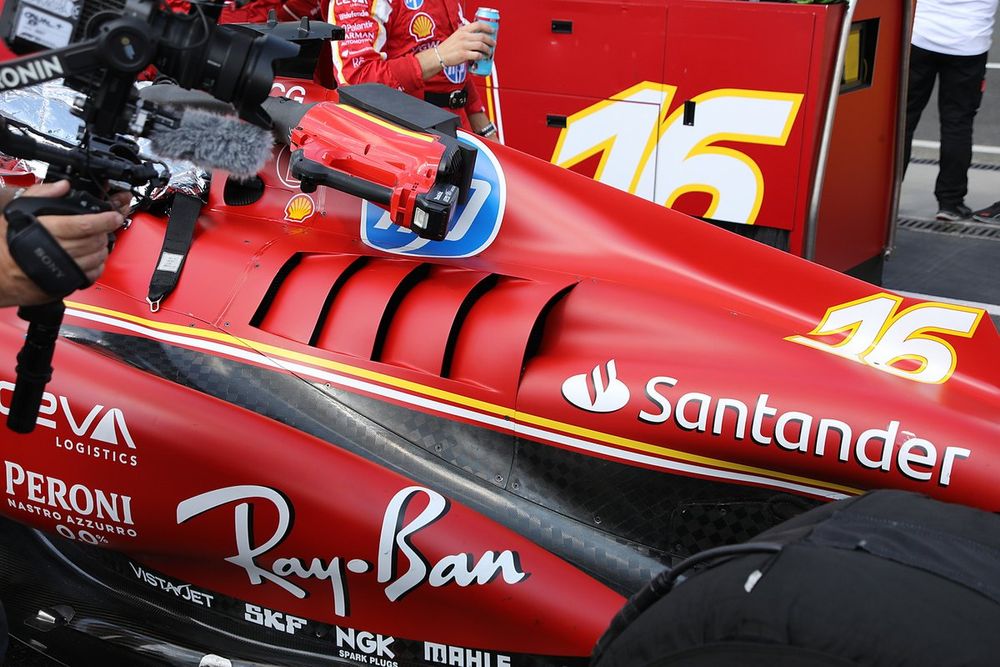
Ferrari SF-24 technical detail
Photo by: Giorgio Piola
Additional cooling for the power unit and its ancillaries is taken care of with an enlarged louvred panel on the Ferrari SF-24 at the Hungarian Grand Prix.
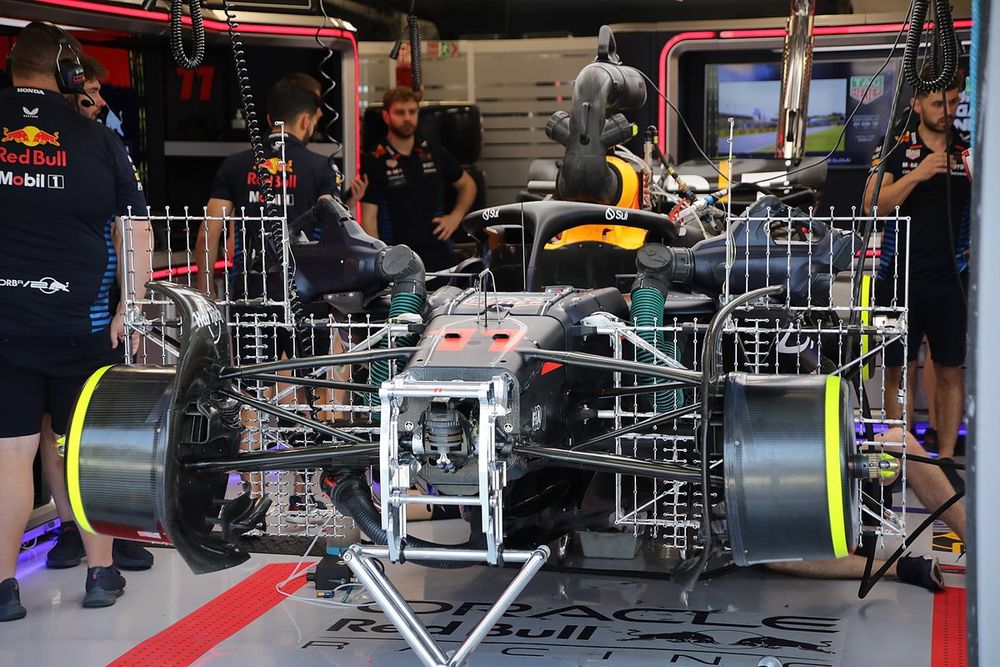
Red Bull Racing RB20 technical detail
Photo by: Giorgio Piola
Red Bull with a large kiel probe rake mounted behind the front wheels on the RB20 as it looks to capture data that can be used to correlate between the real-world environment and its simulation tools.
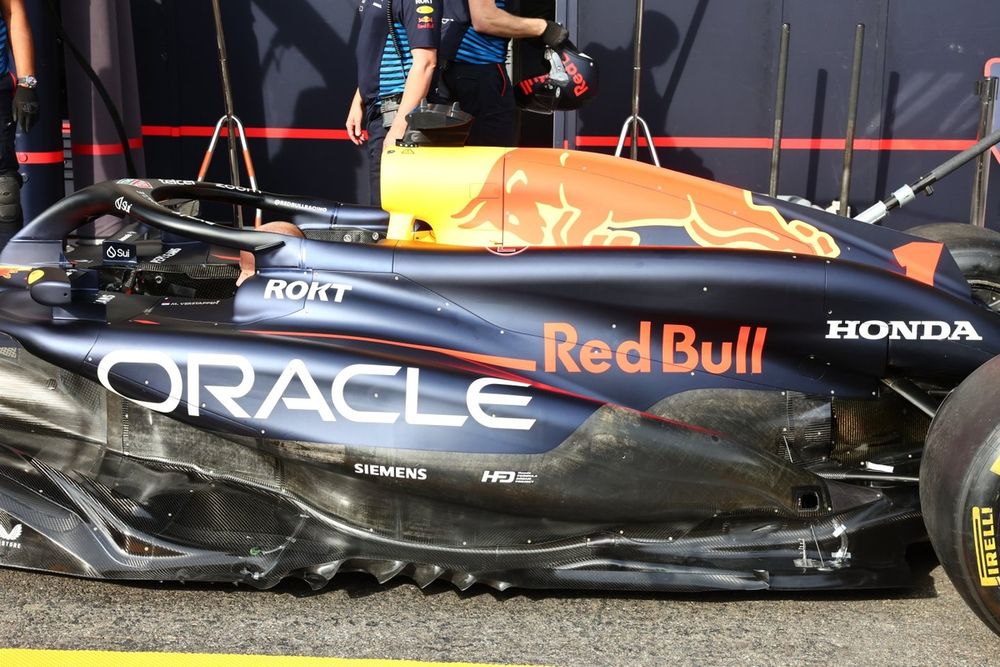
Red Bull Racing RB20 technical detail
Photo by: Giorgio Piola
Side view of the Red Bull RB20 showing the design of the floor, sidepods and engine cover
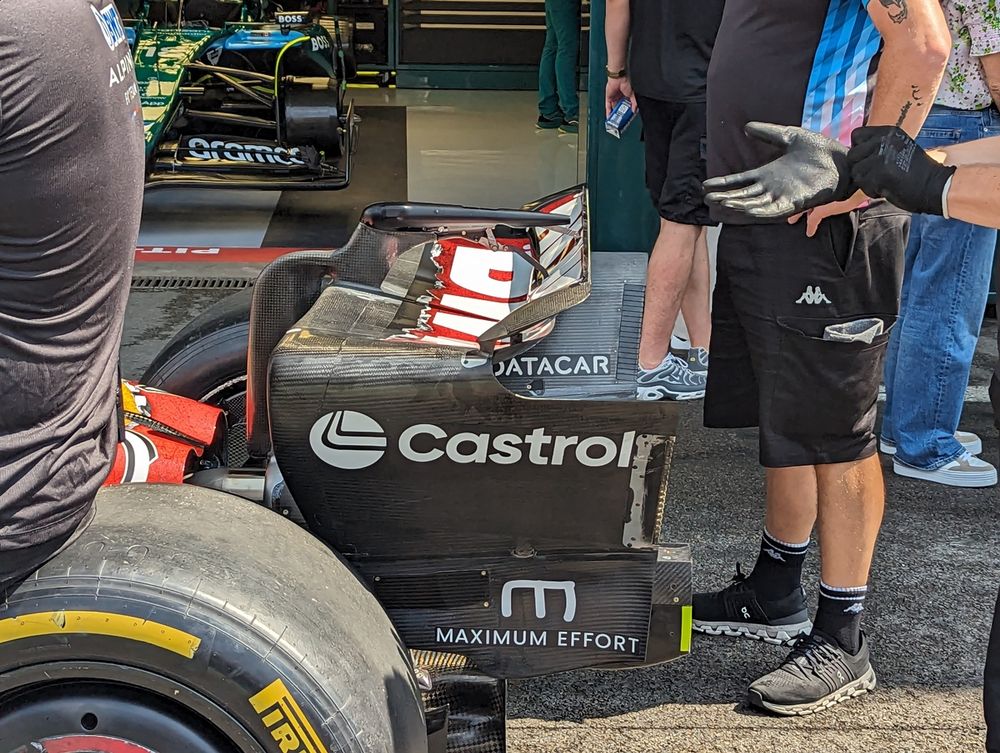
Alpine A524 technical detail
Photo by: Jake Boxall-Legge
A side view of the Alpine A524’s rear wing at the Belgian Grand Prix shows how large the upper rear endplate cutout is and how much the tip section reaches forward over it as a consequence.
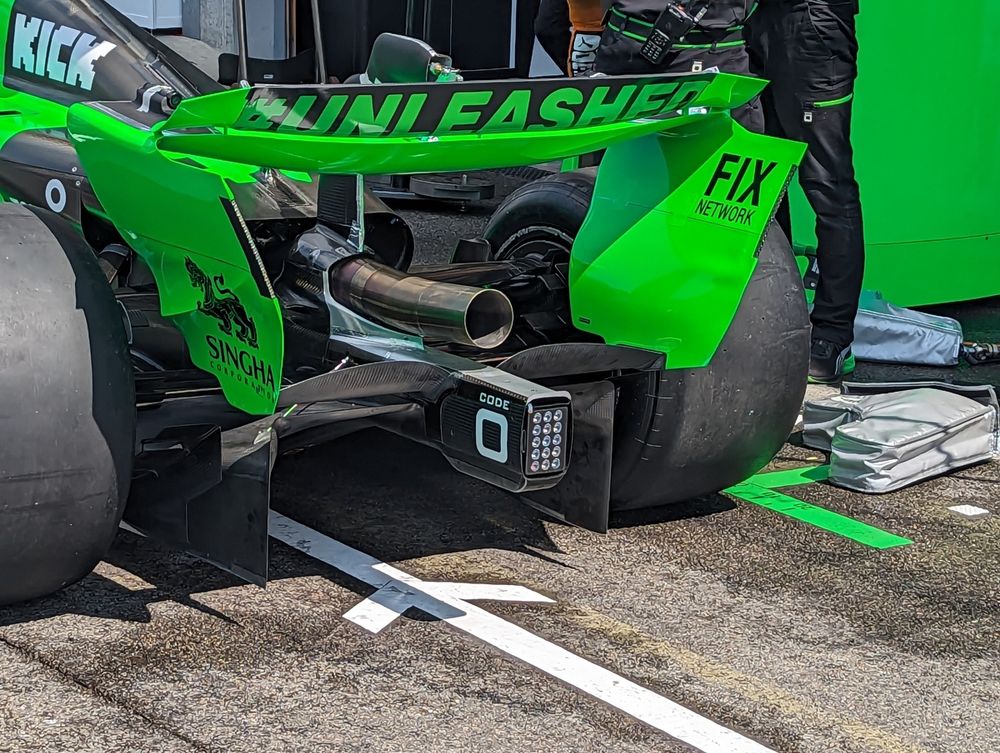
Sauber C44 technical detail
Photo by: Jake Boxall-Legge
A rearward shot of the Sauber C42 at the Belgian Grand Prix, showing the diffuser, lower downforce rear wing and single-element beam wing.
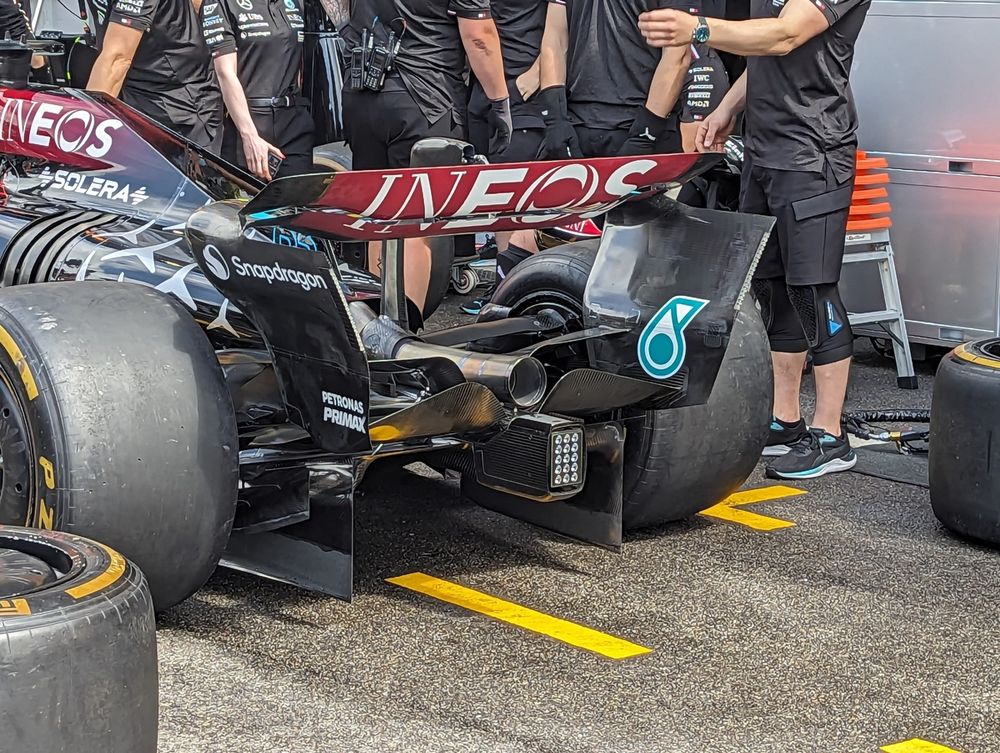
Mercedes W15 technical detail
Photo by: Jake Boxall-Legge
A similar photo of the Mercedes W15 shows the different approach taken by the two teams for the Belgian Grand Prix, with a relatively higher downforce rear wing and bi-plane style beam wing arrangement employed.
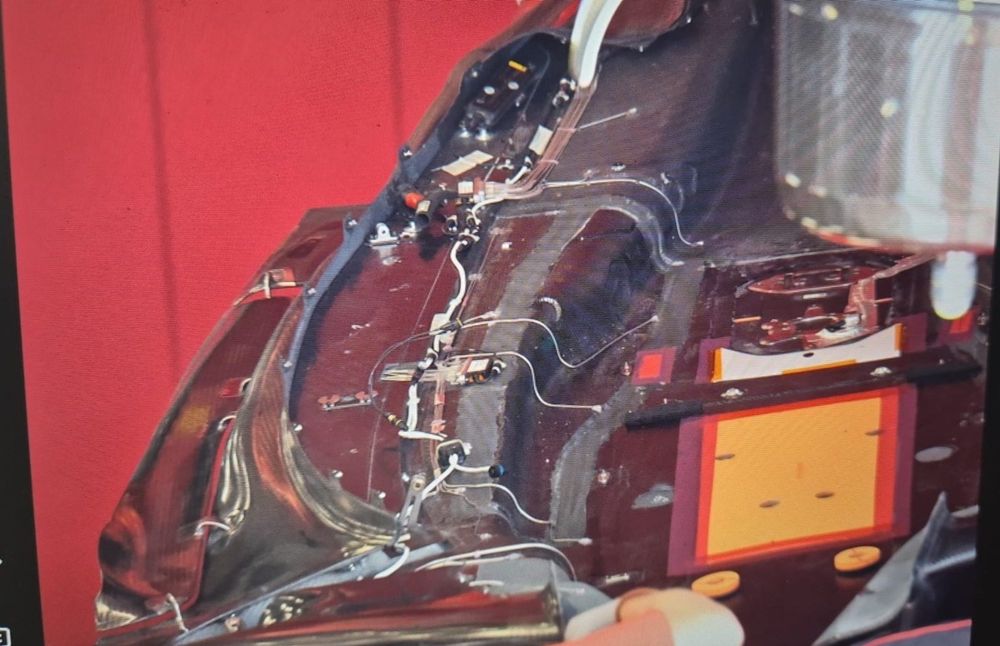
Ferrari SF-24 floor detail
Photo by: Giorgio Piola
A rare glimpse at the inner construction of the Ferrari SF-24’s floor and some of the sensors mounted to it.
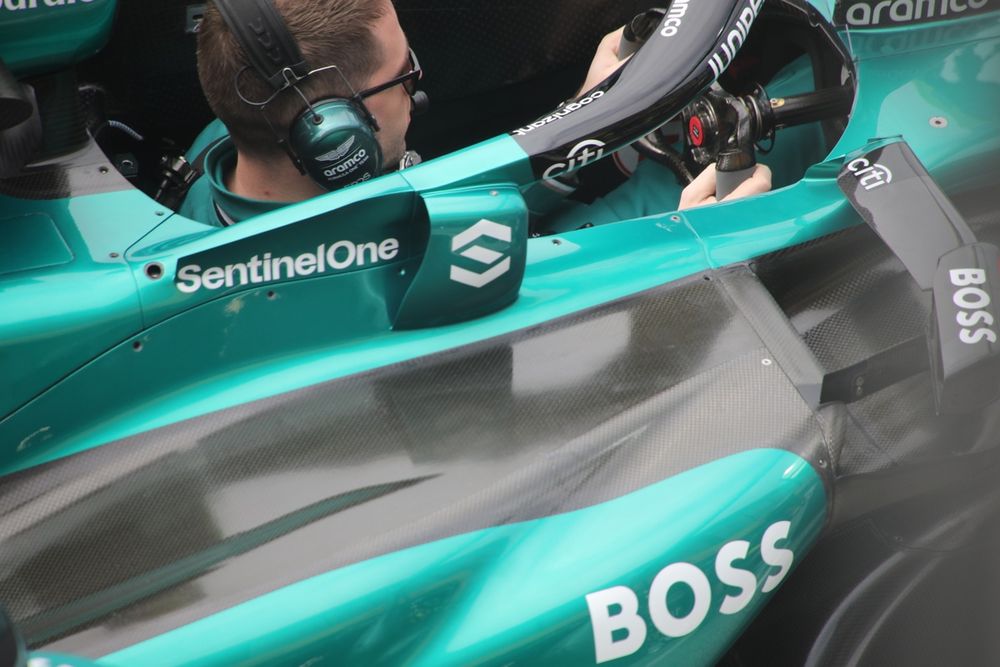
Aston Martin AMR24 technical detail
Photo by: Giorgio Piola
Looking down on the looped halo winglet on the Aston Martin AMR24 as the team does some pitstop practice.
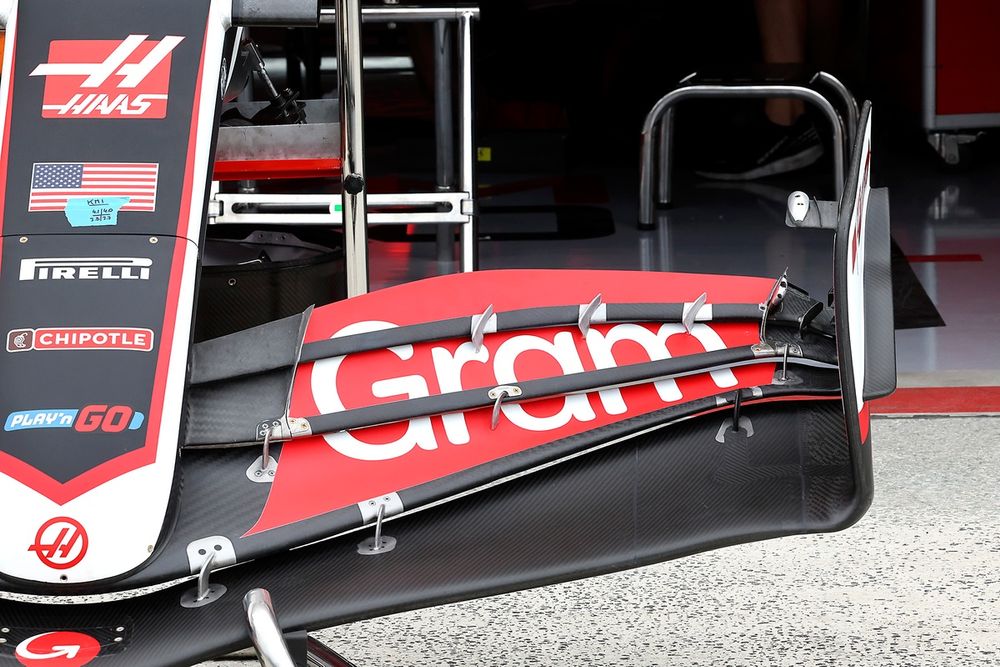
Haas VF-24 front wind detail
Photo by: Giorgio Piola
A top-down overview of the Haas VF-24’s front wing, which shows how the designers have prioritised a wider mainplane element and three narrower flaps in the outboard portion of the wing, to aid in generating outwash.
Also note the winglet stack mounted in the rear corner of the endplate, which also helps with outwash.
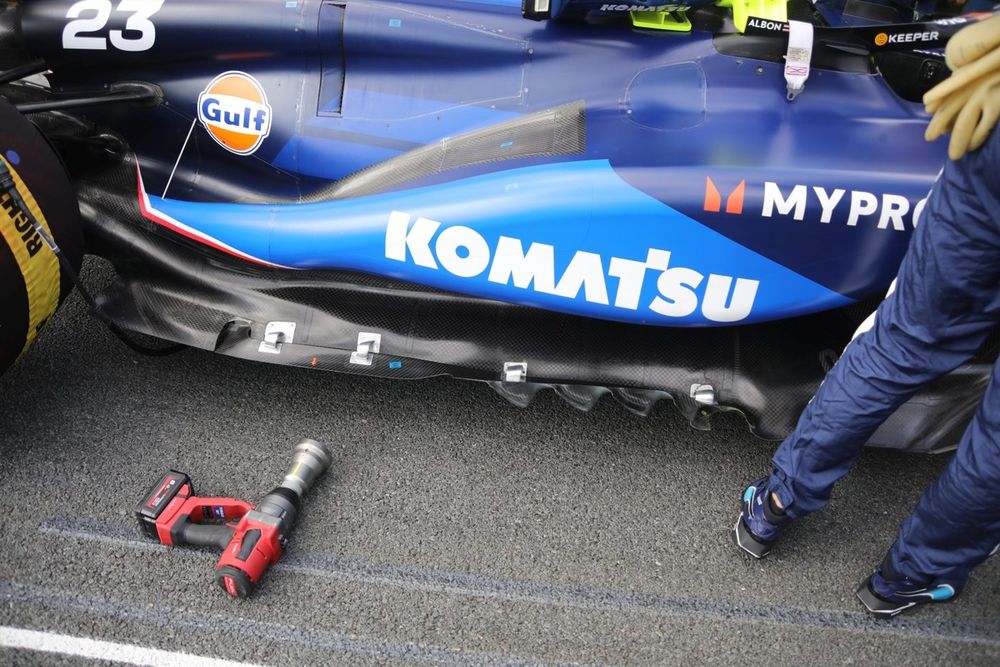
Williams Racing FW46 floor detail
Photo by: Giorgio Piola
An overview of the Williams FW46’s edge wing, the forward section of which features a tiered winglet arrangement, whereby the edge wing sits above a cutout in the floor.
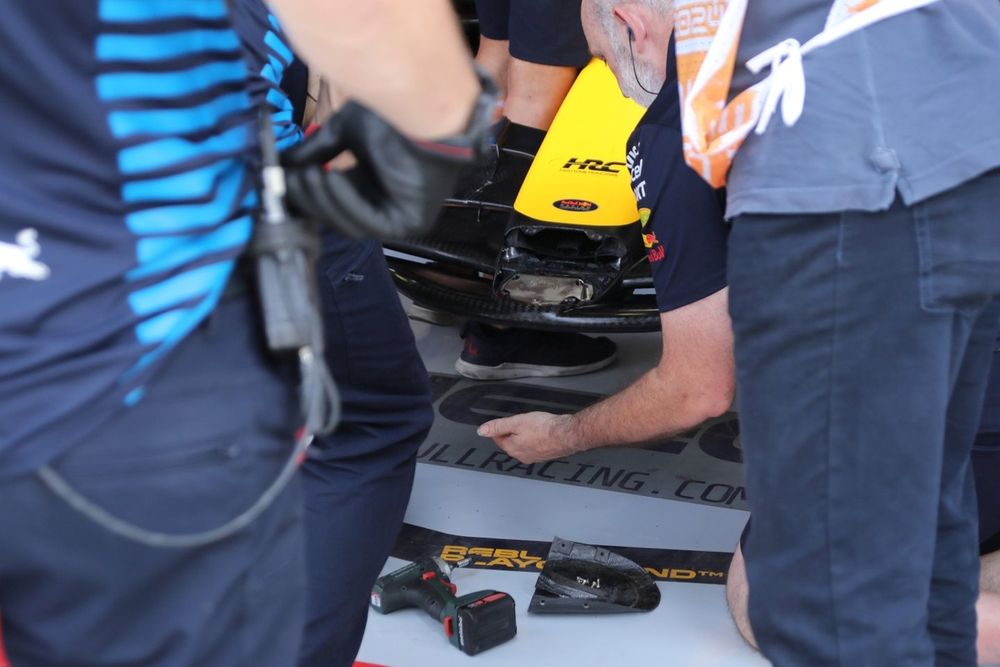
McLaren MCL38 technical detail
Photo by: Giorgio Piola
A look inside the nose tip of the Red Bull RB20 reveals the block of ballast placed as far forward as possible within the tip, while the internal ducting for driver cooling is also visible.
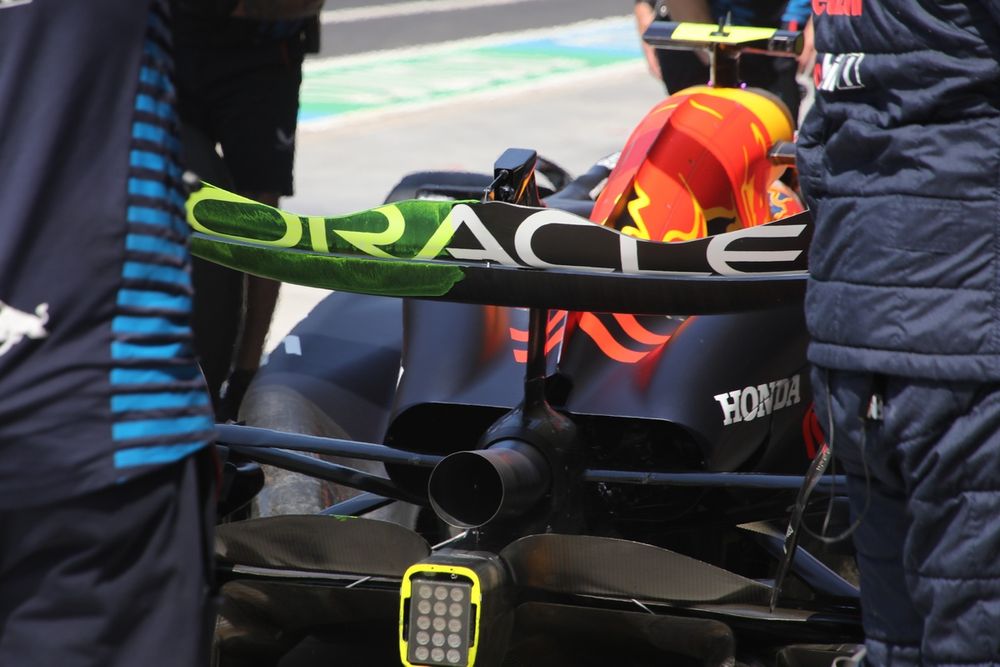
Red Bull Racing RB20 technical detail
Photo by: Giorgio Piola
Red Bull painted flo-viz on its rear wing assembly to make sure it was working as anticipated with the team having trimmed some crescent-shaped gaps into the upper flap’s trailing edge.
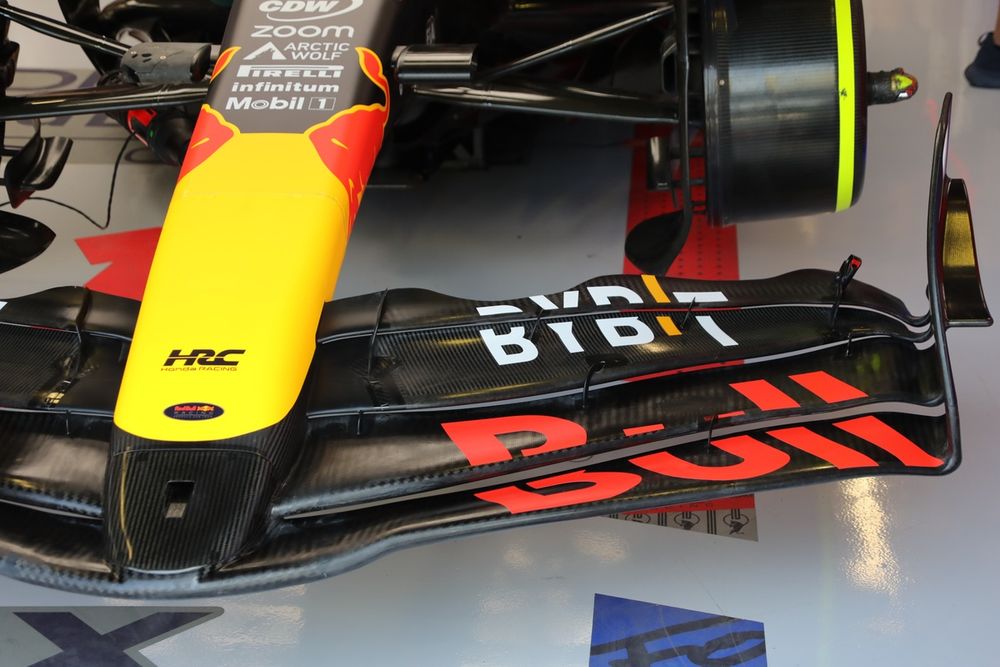
Red Bull Racing RB20 technical detail
Photo by: Giorgio Piola
The front wing was also given a similar treatment to help balance the car from front to rear.
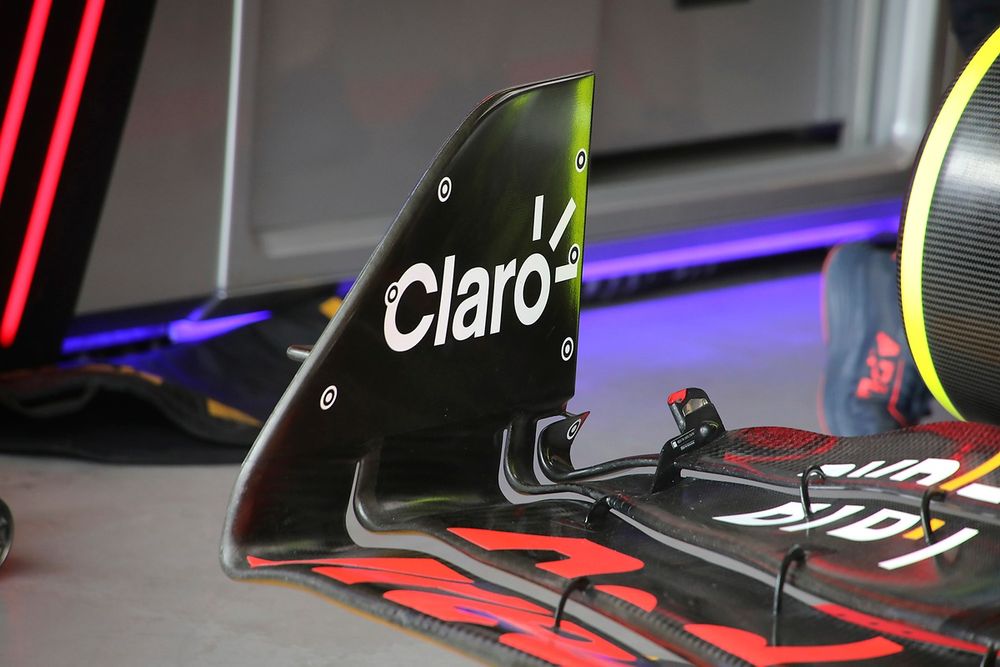
Red Bull Racing RB20 front wind detail
Photo by: Giorgio Piola
A close-up of the front wing endplate and outer corner detail on the Red Bull RB20. Also note the circular reference dots placed around the assembly which are monitored by a camera fitted to the nose, the footage of which is used to check for flexion.
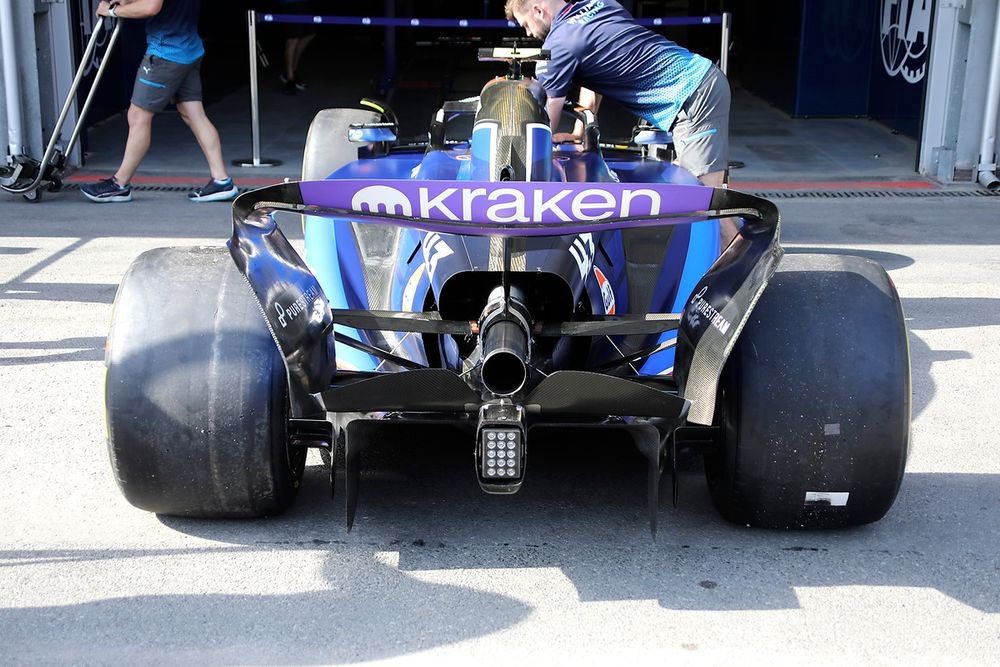
Williams FW46 technical detail
Photo by: Giorgio Piola
A great shot of the rear of the Williams FW46, including the diffuser, single element beam wing and low downforce rear wing package installed for the challenges posed by the Baku street circuit.
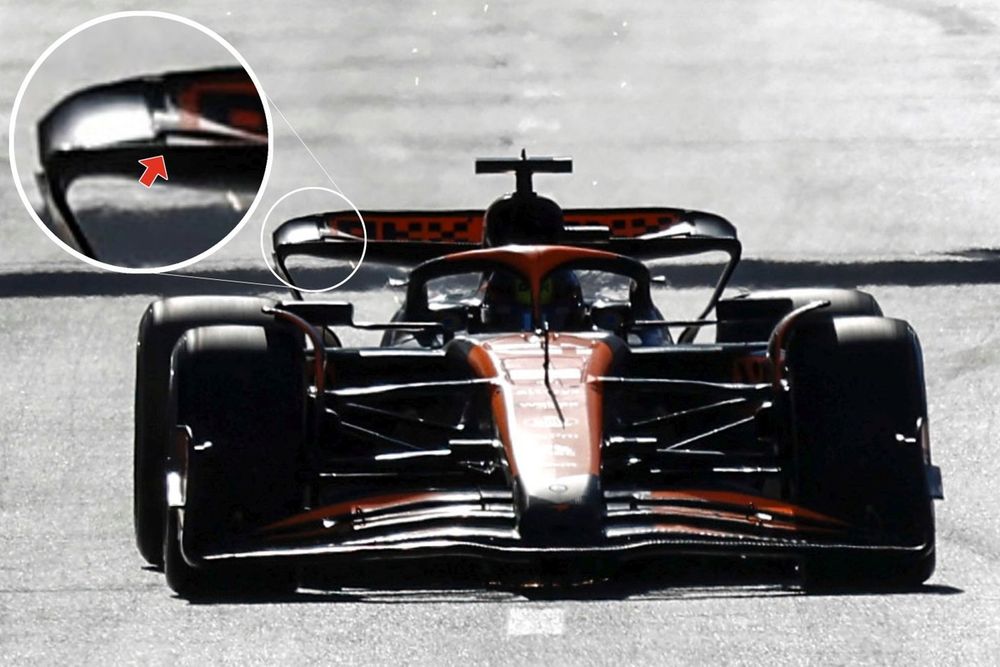
McLaren MCL38 rear wing detail
Photo by: Uncredited
McLaren’s rear wing courted controversy at the Azerbaijan Grand Prix, as the forward corners of the upper flap could be seen to be opening the gap between them and the mainplane on the straights, which would help to boost their straight-line speed.
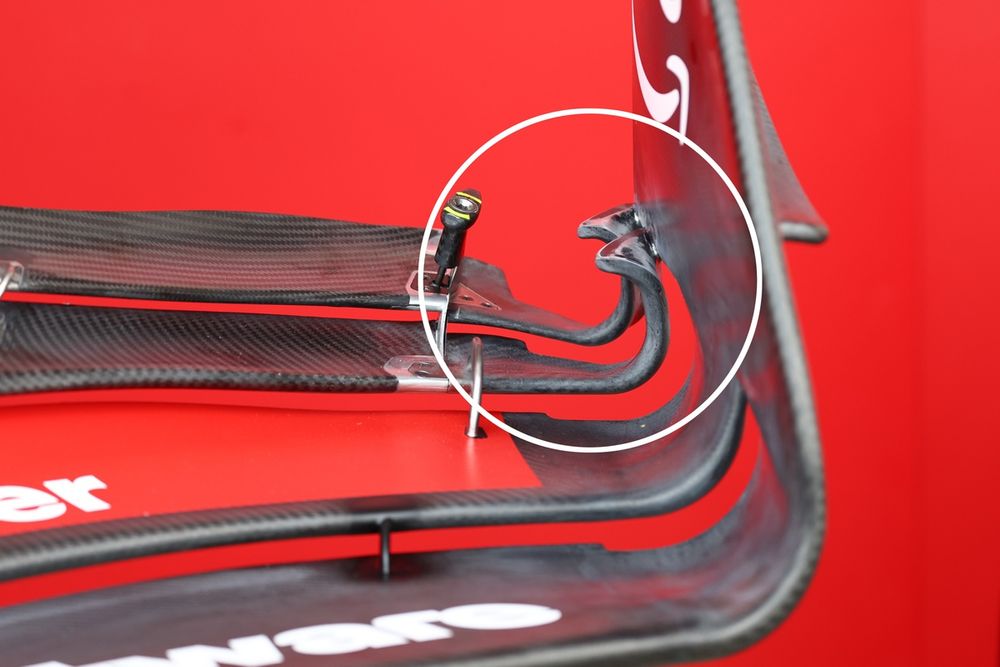
Ferrari SF-24 new front wing detail
Photo by: Giorgio Piola
Ferrari updated its front wing for the Singapore Grand Prix, altering the upper flap elements across their span but also increasing the twist profile of the tip section (circled).
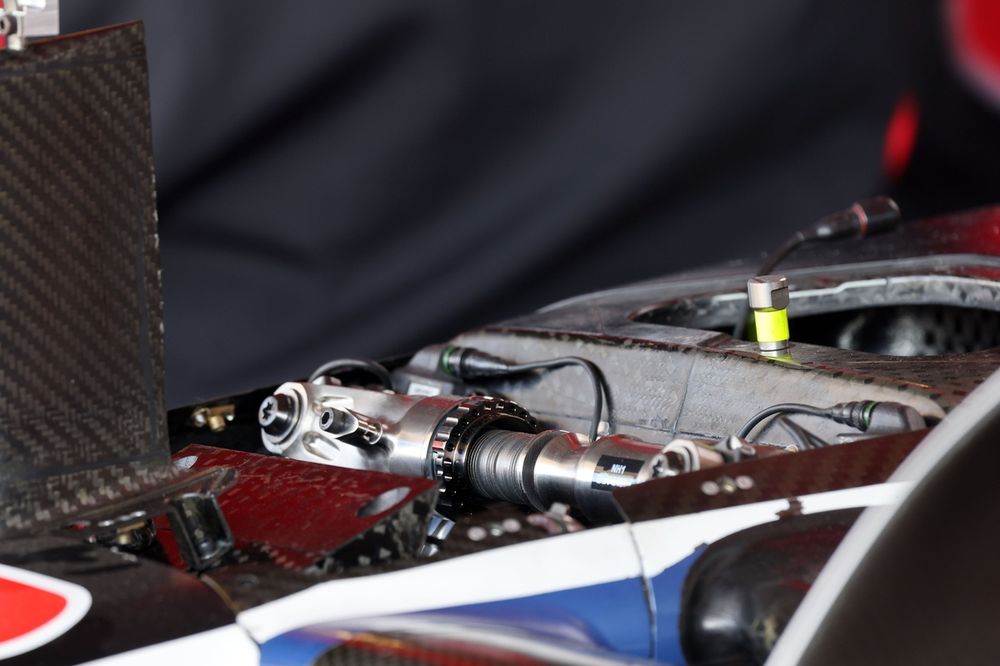
Haas VF-24 detail
Photo by: Andreas Beil
A close-up of the heave damper used on the Haas VF-24’s front suspension arrangement.
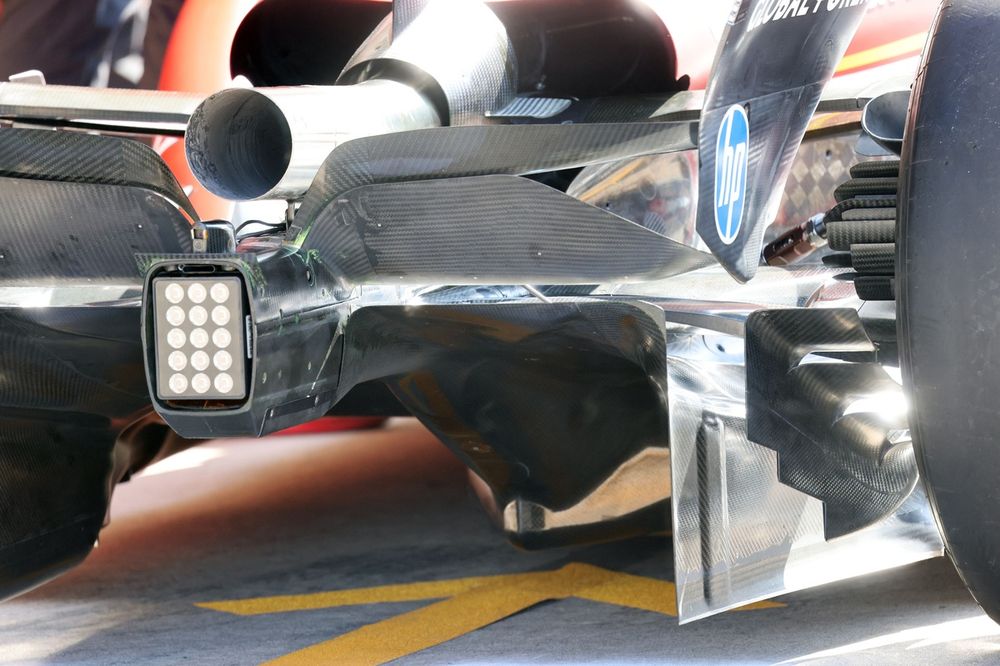
Ferrari SF-24 detail
Photo by: Andreas Beil
A look at the rear end of the Ferrari SF-24 has plenty of details to uncover, including the small winglets mounted on the rear wing pillar, the complex upper winglet stack on the rear brake duct, the stepped lower edge on the lower brake duct winglet, the contouring on the ceiling of the diffuser and the lower wedge-shaped section at its base.
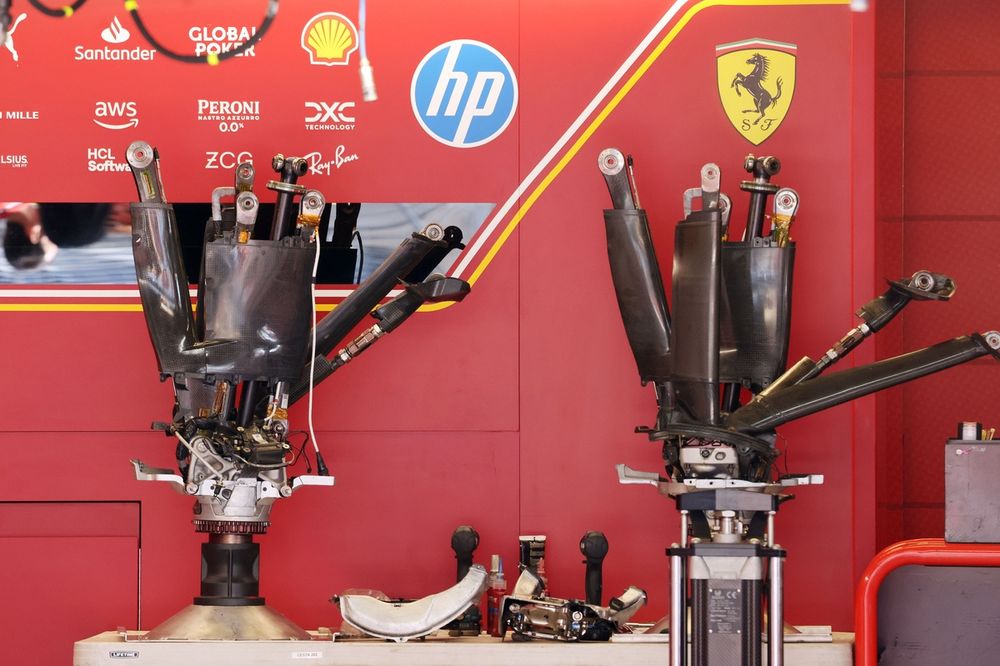
Ferrari SF-24 detail
Photo by: Andreas Beil
The Ferrari SF-24’s rear suspension being worked on away from the car gives a fantastic view of the fairings used to cover the actual suspension elements and how they will influence the airflow that passes around them.
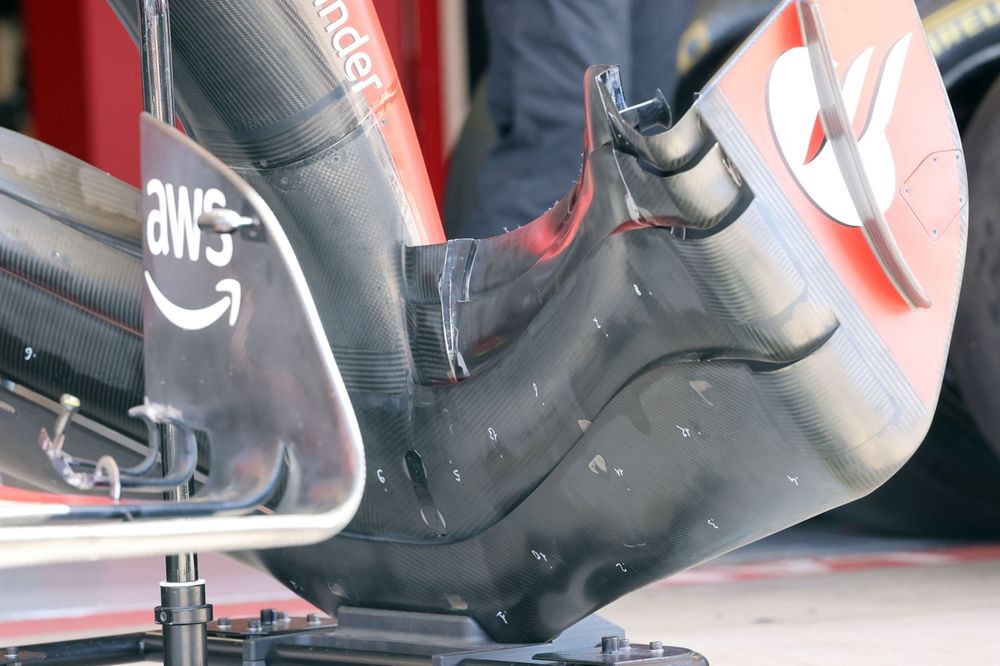
Ferrari SF-24 detail
Photo by: Andreas Beil
An unusual shot of the Ferrari SF-24’s front wing shows how much curvature there is across the span of the wing.
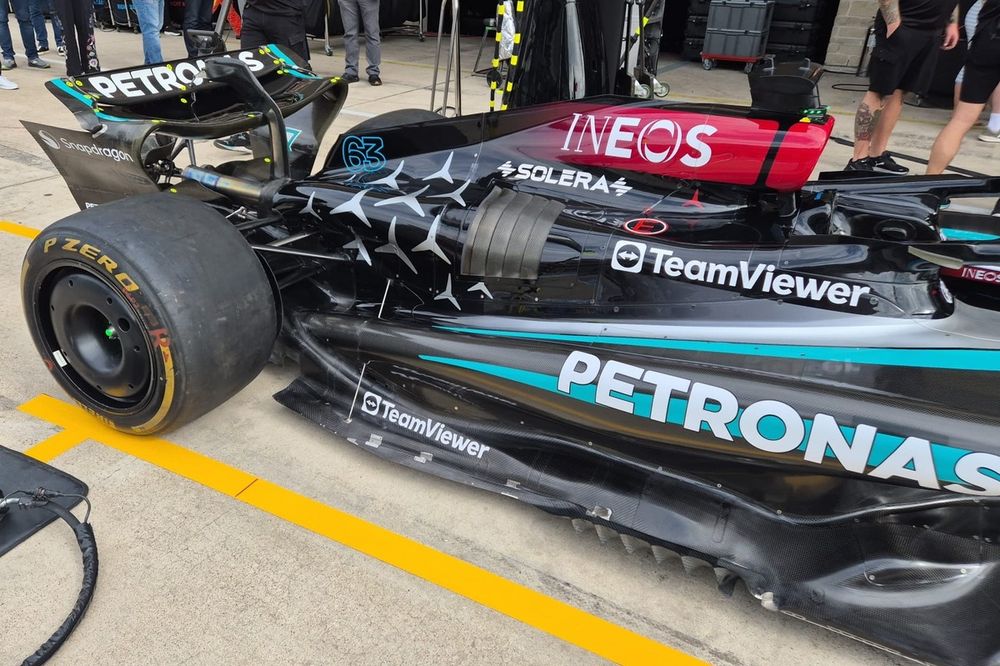
Mercedes F1 W15 detail
Photo by: Giorgio Piola
Mercedes introduced a significant update package for the W15 at the United States Grand Prix, which included a new front wing, reprofiled suspension fairings, the addition of another vane on their edge wing, new floor fence geometry, additional cooling exits around the rear suspension and revised sidepod bodywork, which resulted in the lower section of the inlet being removed and the overbite-style solution preferred.
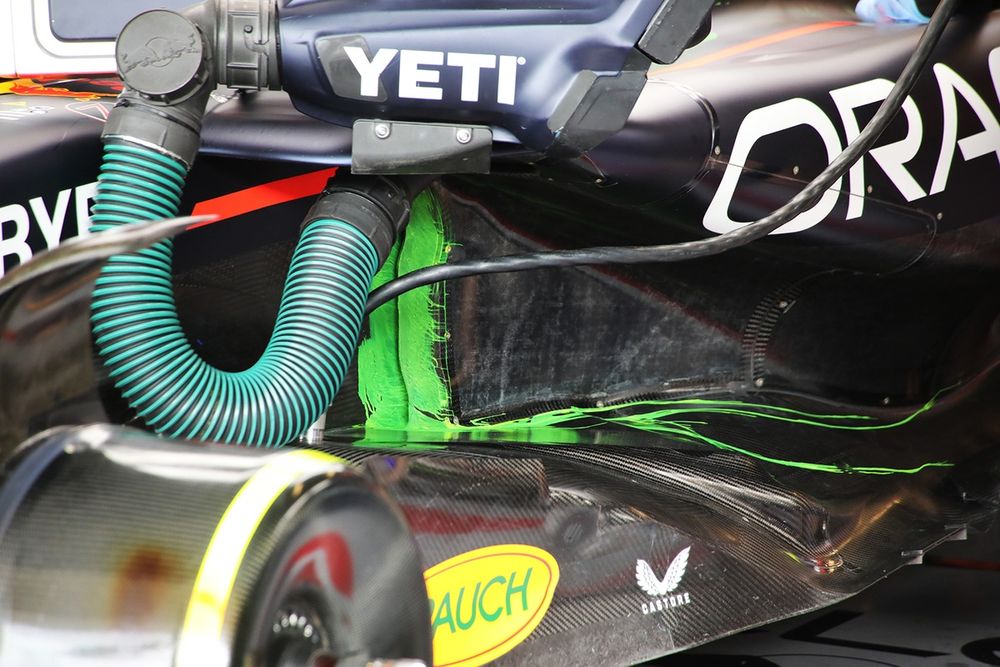
Red Bull Racing RB20 detail
Photo by: Giorgio Piola
Flo-viz paint on the Red Bull RB20’s vertical sidepod inlet gives a visual representation of how the airflow moves across the surfaces, allowing the team to quickly assess if it’s performing as anticipated.
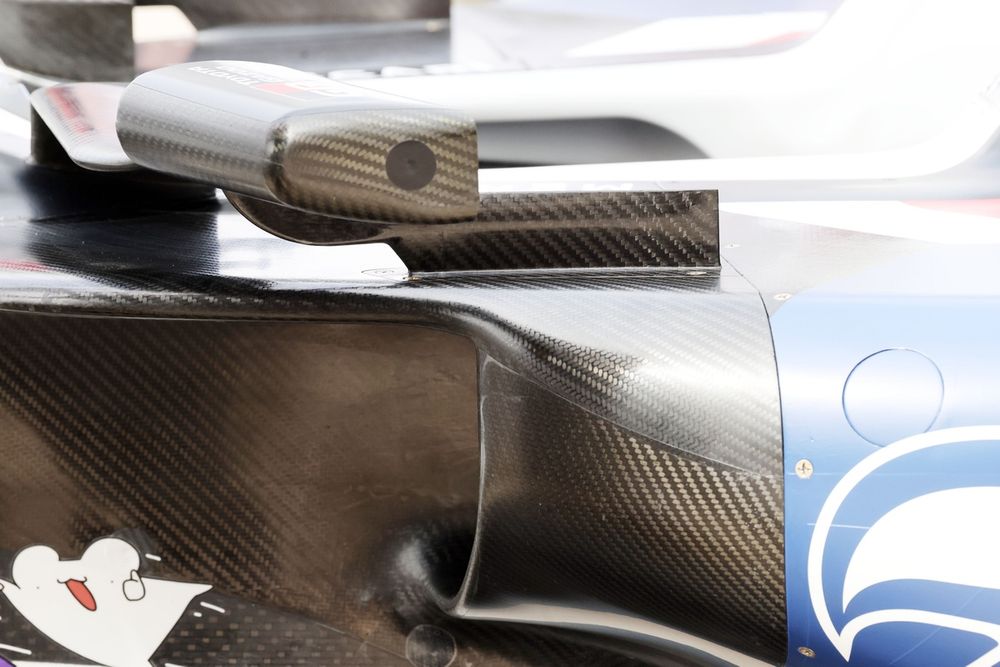
Haas VF-24 technical detail
Photo by: Andreas Beil
Haas updated its sidepod inlet arrangement at the United States Grand Prix, making the shift to the overbite solution that many of their rivals had already been using in 2024. This also helped to alter the size of the sidepod’s undercut, which allowed a revised flow regime to meet the updated floor that was also part of their update package.
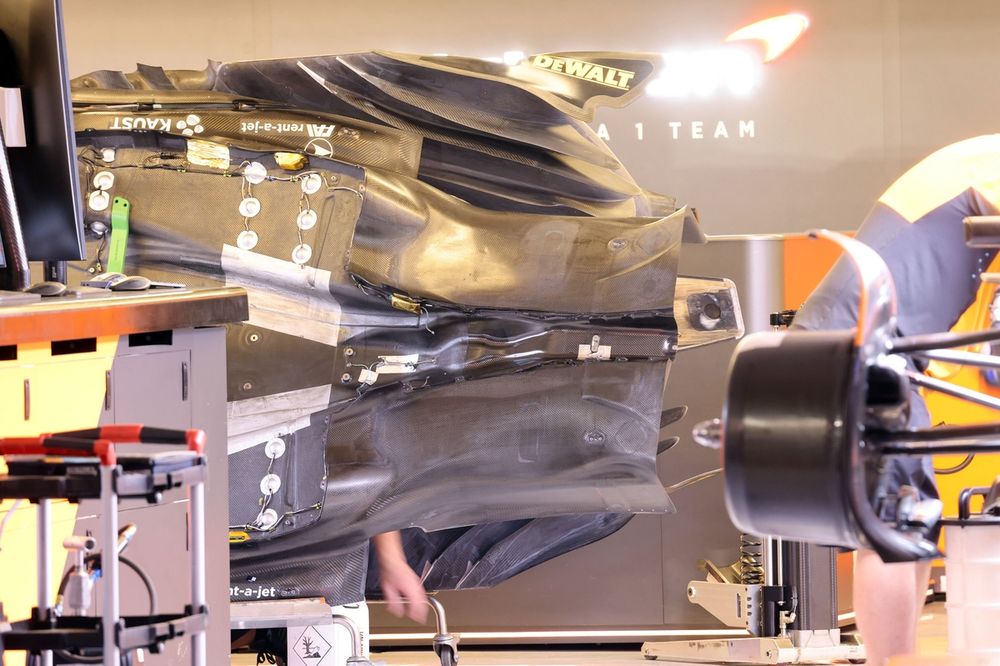
McLaren MCL38 floor
Photo by: Andreas Beil
Two MCL38 floors mounted on top of one another in the McLaren garage afford us an obscured view of the floor strakes from beneath, while the floor in the foreground shows us how large the wedge-shaped central section in the roof of the diffuser is.
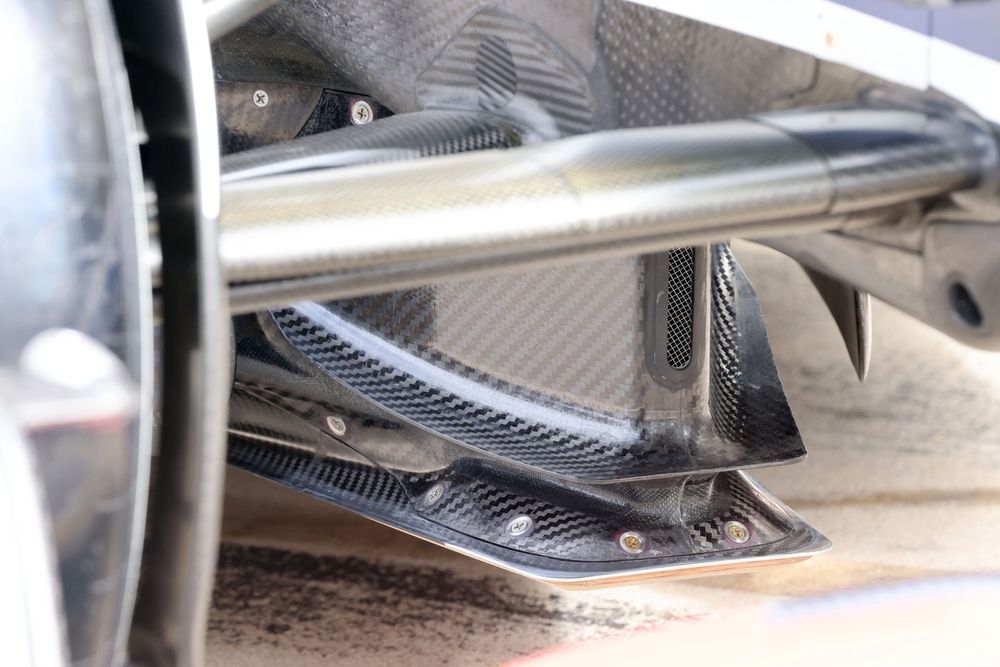
Haas VF-24 front bib detail
Photo by: Andreas Beil
A close-up of the bib and bib winglet used on the Haas VF-24.
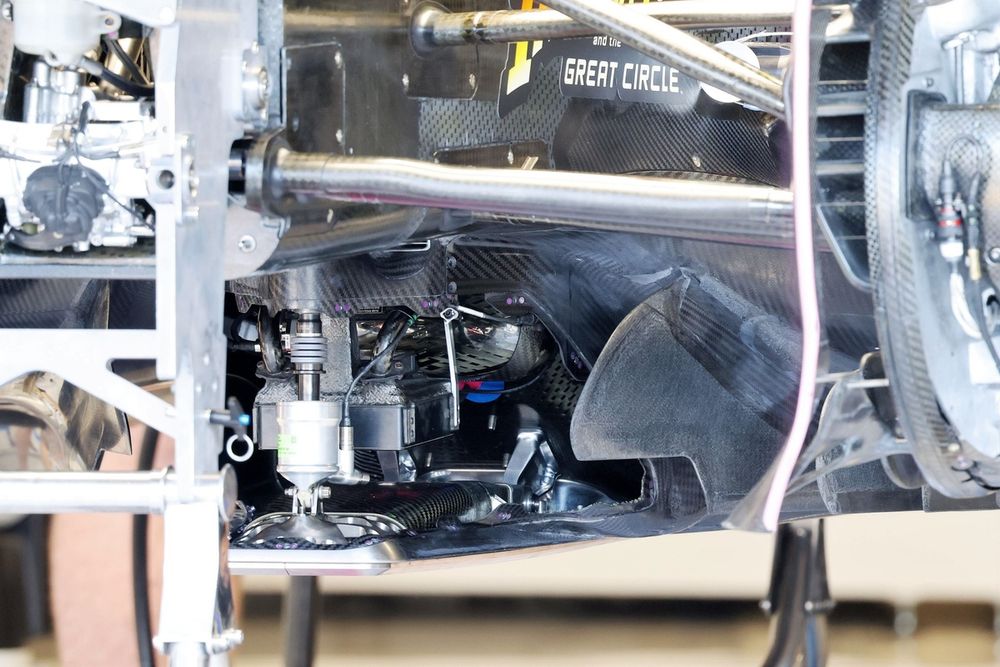
Alpine A524 front bib detail
Photo by: Andreas Beil
A look at the bib region on the Alpine A524 with the bodywork off reveals the spring mechanism being used.
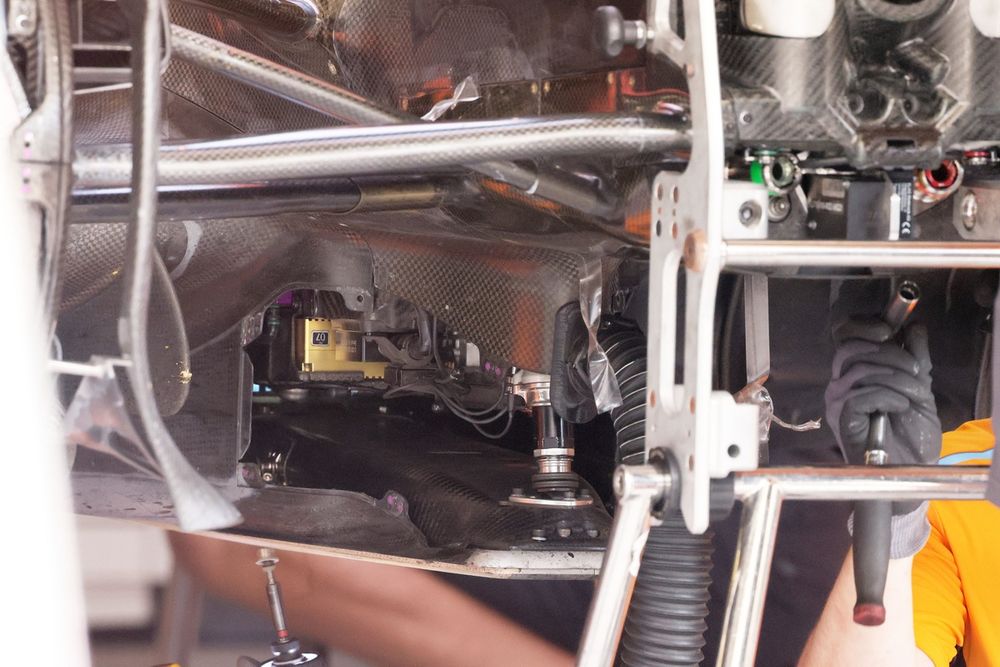
McLaren MCL38 front bib detail
Photo by: Andreas Beil
Similarly, we’re able to see the spring mechanism on the McLaren MCL38 that’s housed between the bib and chassis.
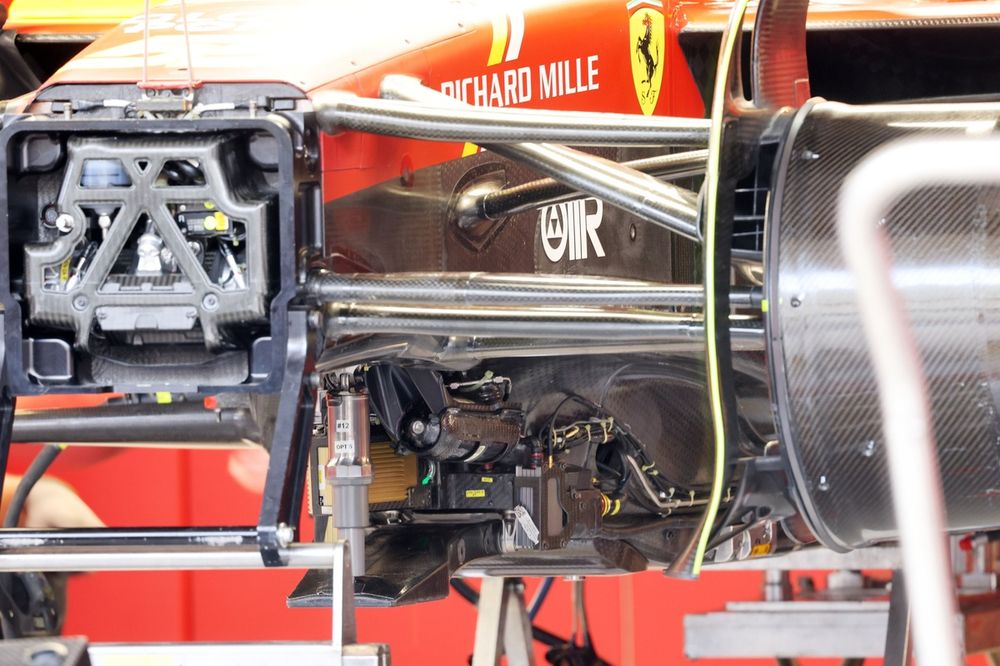
Ferrari SF-24 technical detail
Photo by: Andreas Beil
The same region on the Ferrari SF-24 shows how different all of the teams approach the design of their bib, the spring mechanism and how many of the other ancillary components they pack into that portion of the car.
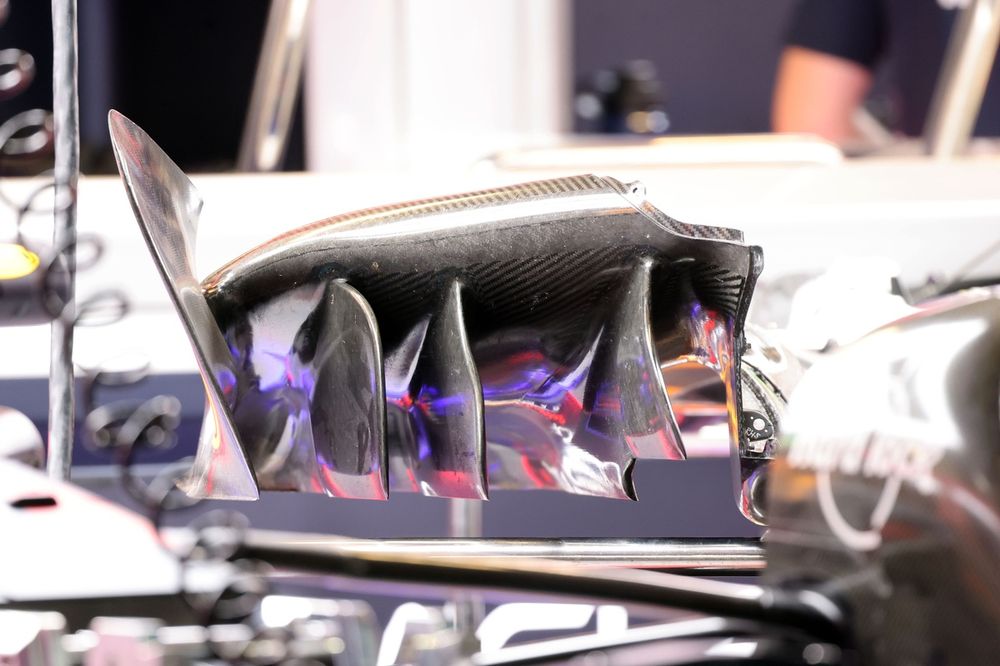
Red Bull Racing RB20 technical detail
Photo by: Andreas Beil
The leading edge and floor fence detail on the Red Bull RB20, with the spacing and different contours of each fence used to help control the passage of the airflow rearward.
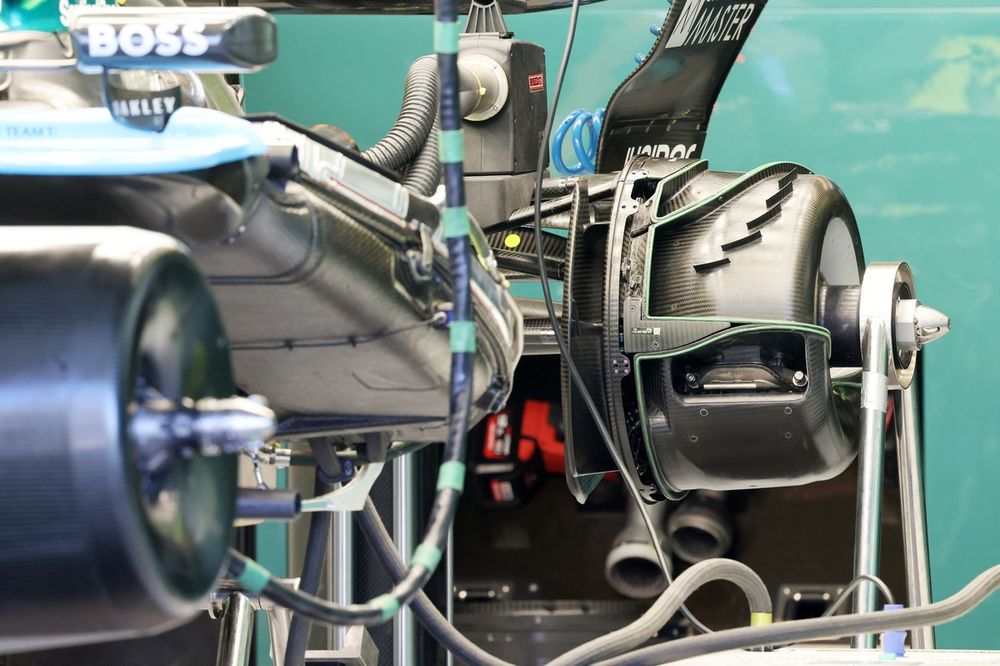
Aston Martin AMR24 technical detail
Photo by: Andreas Beil
This angle of the edge wing shows how cranked the element is in the forward section on the Mercedes W15, with the internal fins used to help control how the airflow moves around its surface.

Aston Martin AMR24 technical detail
Photo by: Andreas Beil
The interior nest of Aston Martin’s rear brake duct has fins on the surface of the crossover channel in order to help direct the airflow as it passes through the chamber.
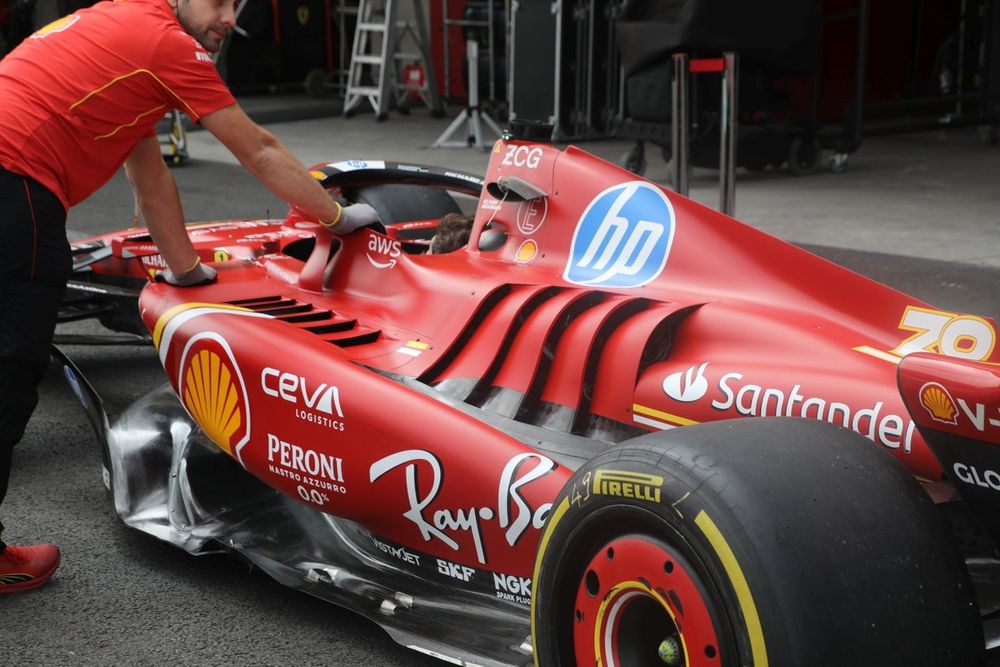
Ferrari SF-24 technical detail
Photo by: Giorgio Piola
Ferrari introduced its maximum cooling option for the Mexican Grand Prix, which included a louvre panel on the upper surface of the sidepod and a set of elongated louvres in the engine cover panel.
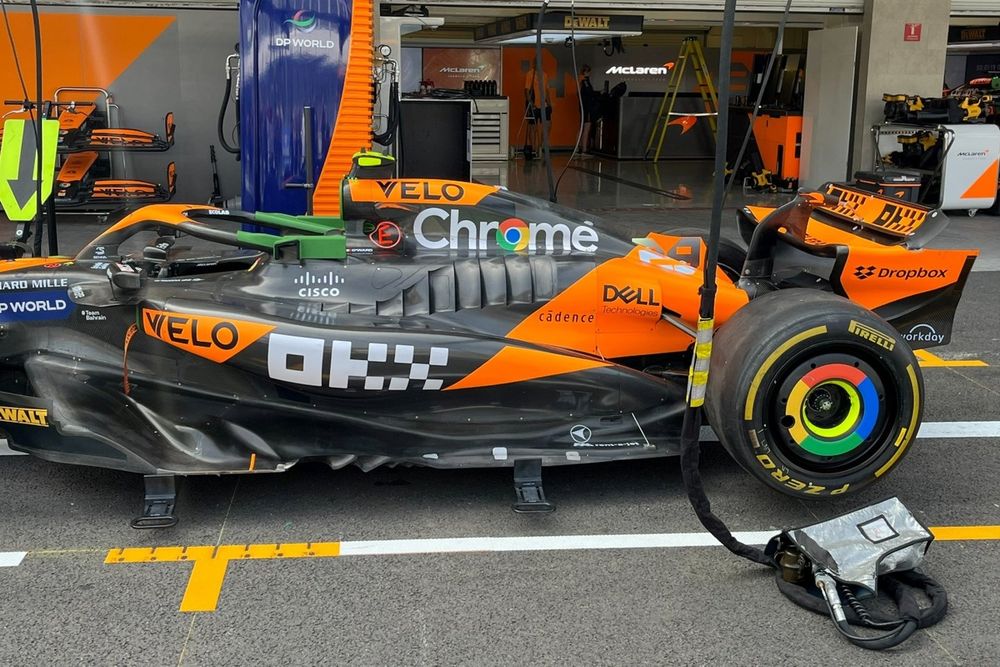
McLaren MCL38 technical detail
Photo by: Alex Kalinauckas
McLaren also expanded the cooling on its car in Mexico, with the louvres straddling both the sidepod and engine cover.
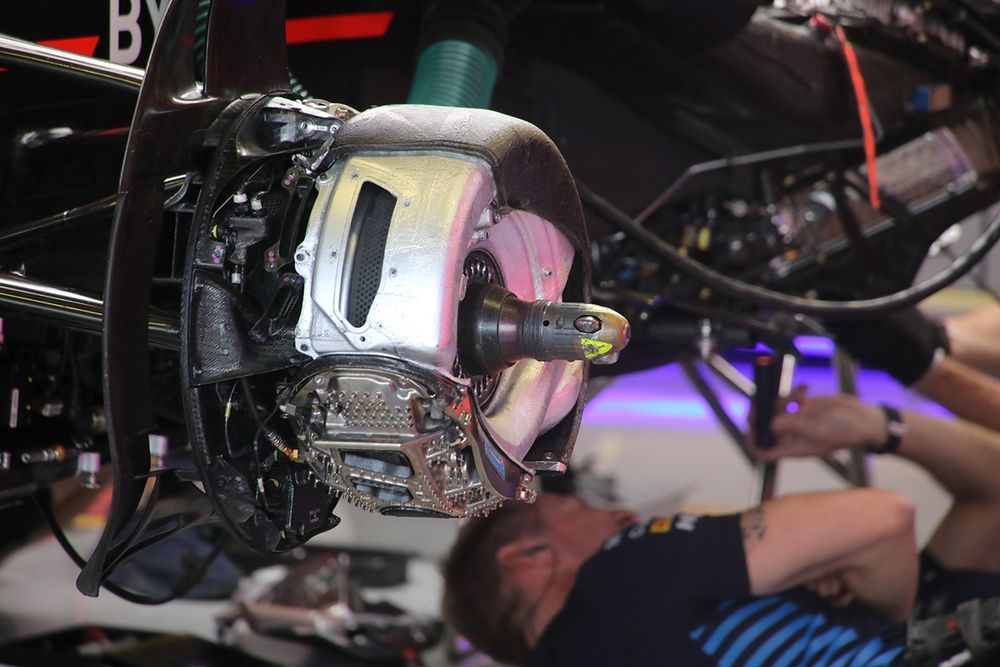
Red Bull Racing RB20 detail
Photo by: Giorgio Piola
A look at some of the detail beneath the outer covers that make up the front brake duct on the Red Bull RB20, which includes brake disc fairing which has a high-temperature coating to help manage the heat being generated, while an aperture can be found on the front to allow heat to move between the various nests.
Also, note the pin-like cooling fins used on the outer surface of the brake calliper to both reduce weight and manage temperature.
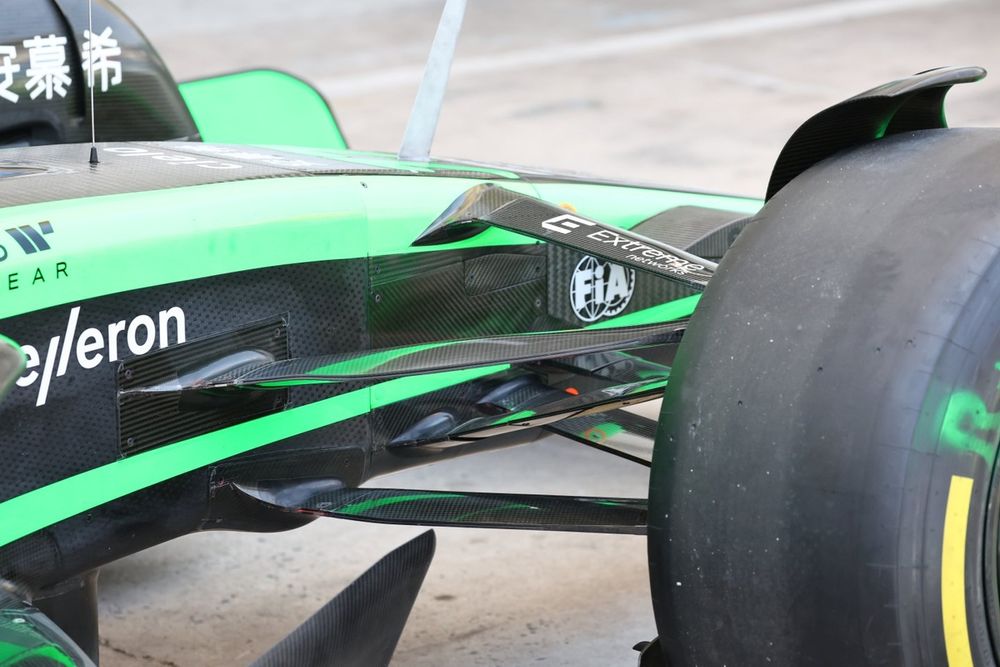
Stake F1 Team KICK Sauber C44 technical detail
Photo by: Giorgio Piola
Sauber introduced a number of new components at the United States Grand Prix, including revised front suspension fairings, in order to take advantage of the changes made with its front wing.
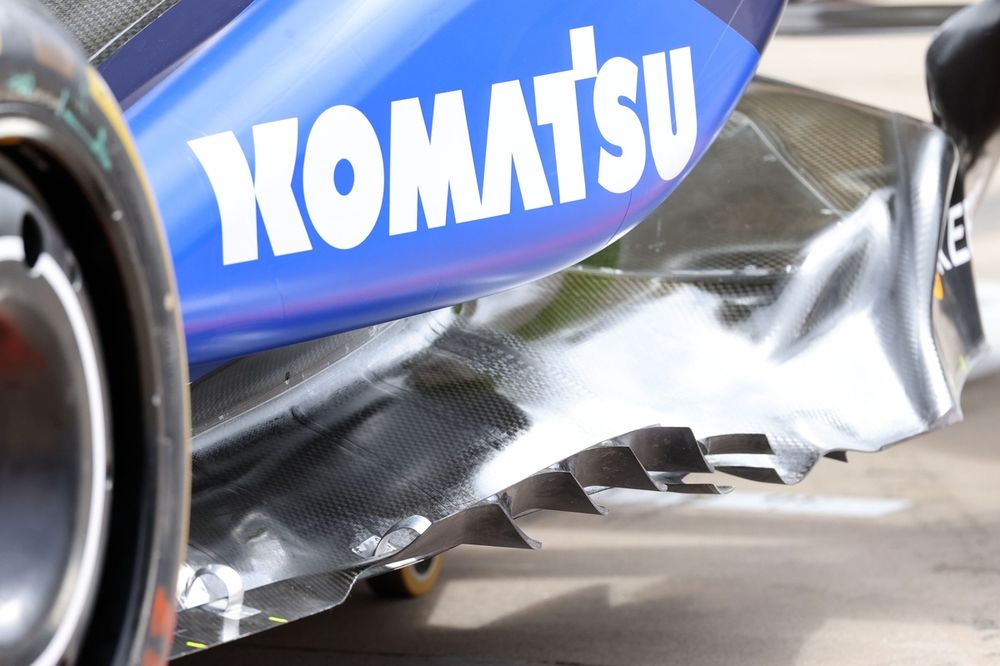
Williams FW46 floor detail
Photo by: Andreas Beil
The C-shaped notch and upwardly edged profile of the floor’s edge on the Williams FW46 permits the edge wing to stack above it, complimenting the two forwardmost winglets of the element and enabling the whole surface to sit higher and cranked more than might otherwise be possible.
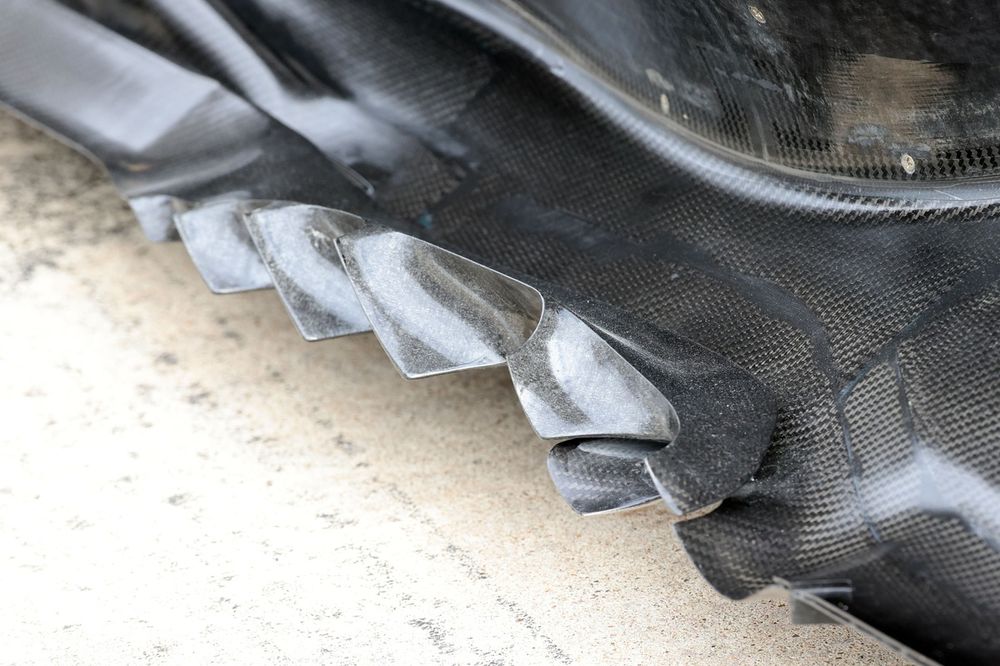
Red Bull RB20 floor detail
Photo by: Andreas Beil
For comparison purposes here’s the solution used by Red Bull for some time now which also employs the stacked floor and edge wing arrangement.
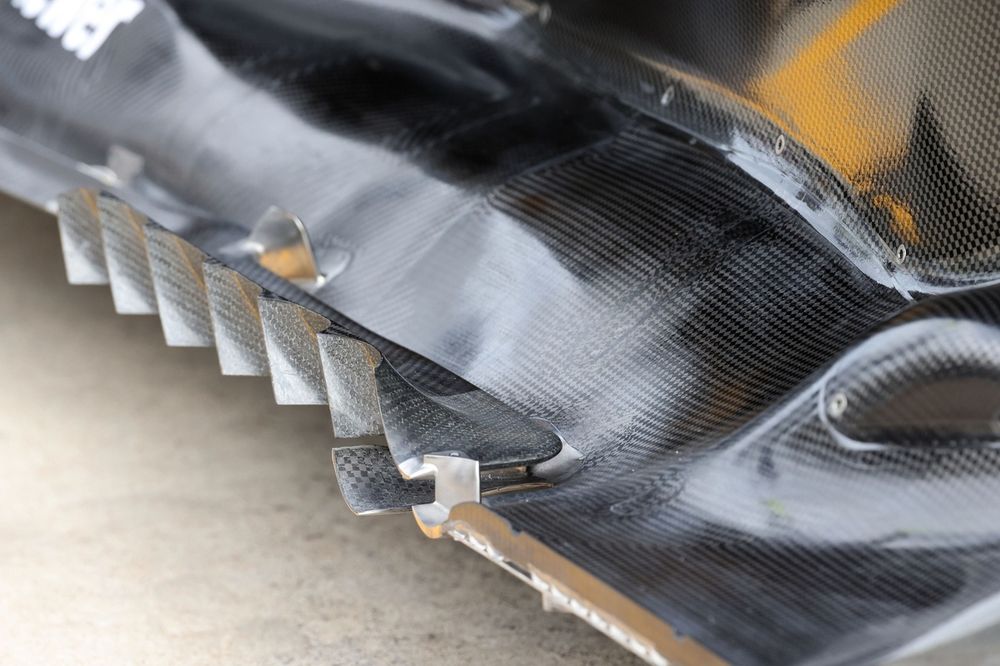
Mercedes F1 W15 floor detail
Photo by: Andreas Beil
Mercedes also introduced a similar feature for the W15 as part of their update package at the United States Grand Prix, albeit they employed a shorter notch in the floor, which means that the second element of its edge wing takes full advantage of floor segment below.
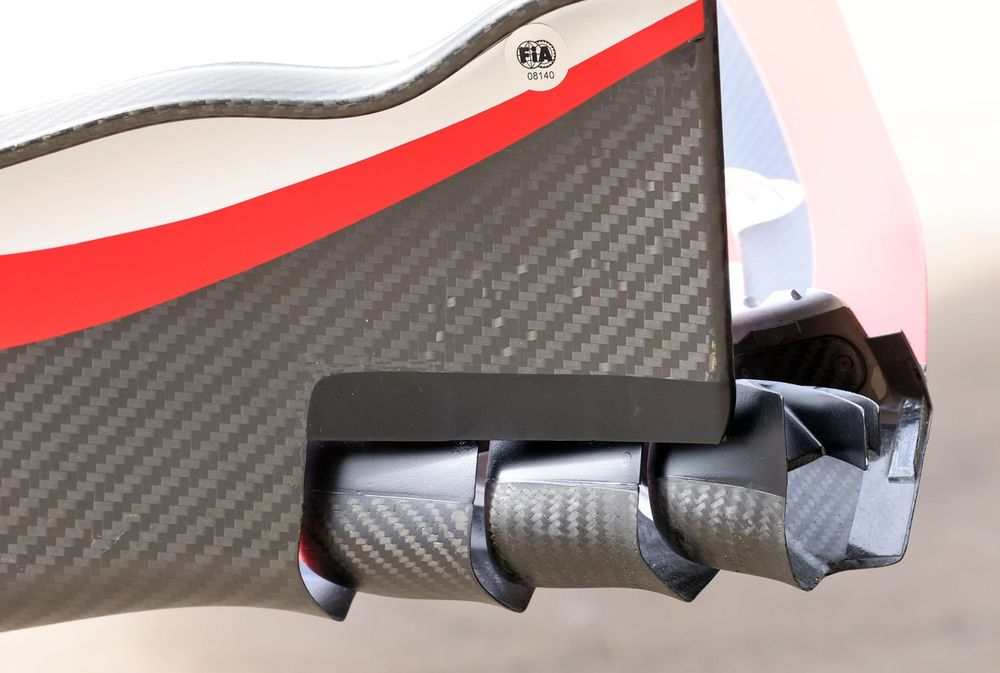
Haas VF-24 detail
Photo by: Andreas Beil
A close-up of the rear section of the front wing on the Haas VF-24, shows how the three rearmost elements are pushed away from the endplate, angled outwards and their trailing edge angled down. This, along with the multi-element winglet array mounted on the rearmost element all assist in generating outwash.
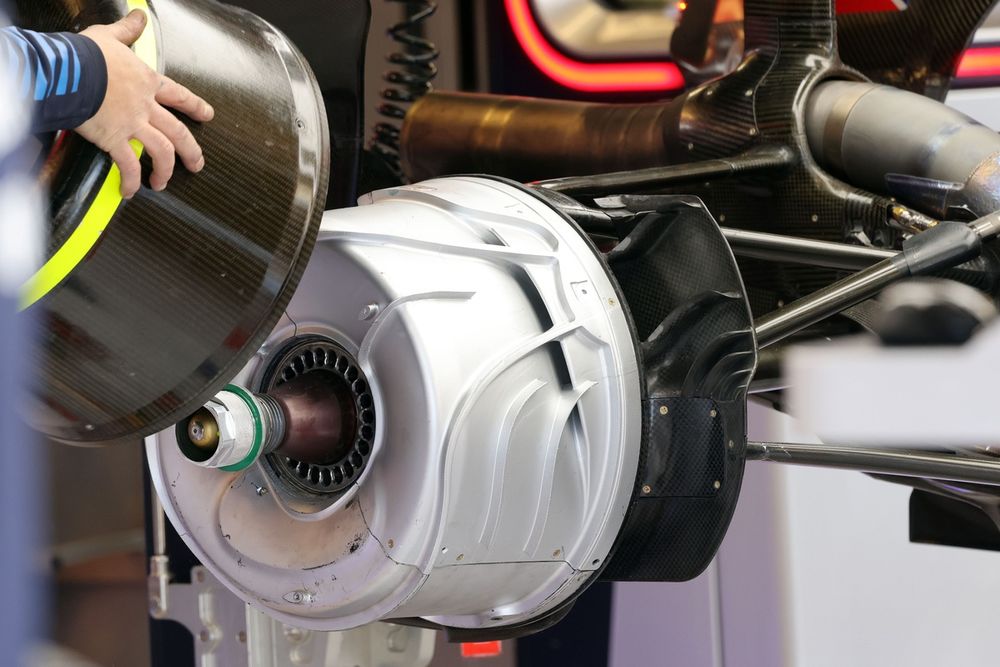
Red Bull Racing RB20 brake drum detail
Photo by: Andreas Beil
The secondary nest inside the rear brake duct on the Red Bull RB20 not only has a coating to act as a thermal barrier but there are numerous baffles employed to direct the airflow in the space between the two nested drums.
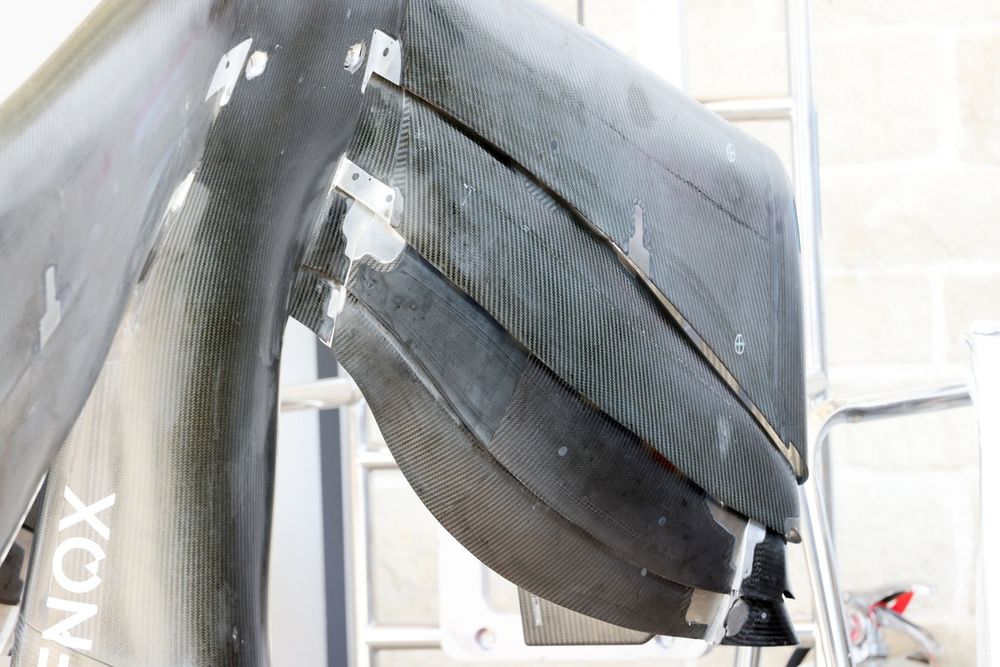
Alpine A524 front wing detail
Photo by: Andreas Beil
A rare glimpse at the underside of the front wing, which is the Alpine A524 in this instance shows how the metal brackets support the wing elements.
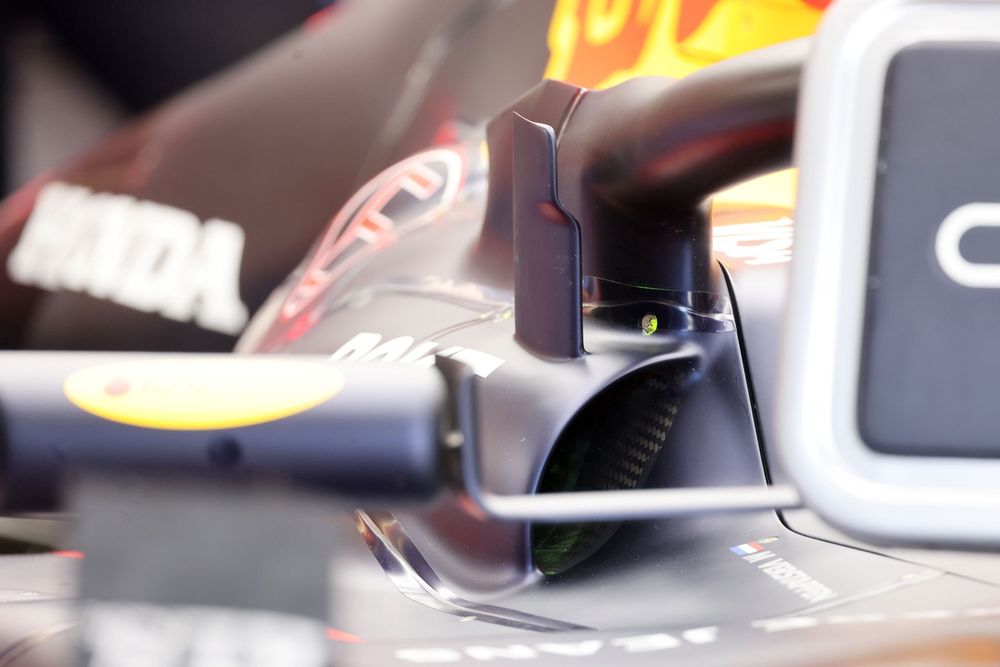
Red Bull Racing RB20 cooling detail
Photo by: Andreas Beil
A close-up of the halo inlet on the Red Bull RB20 which also has a stepped flow diverter mounted atop it to assist in redirecting the airflow around the rear leg of the safety structure.
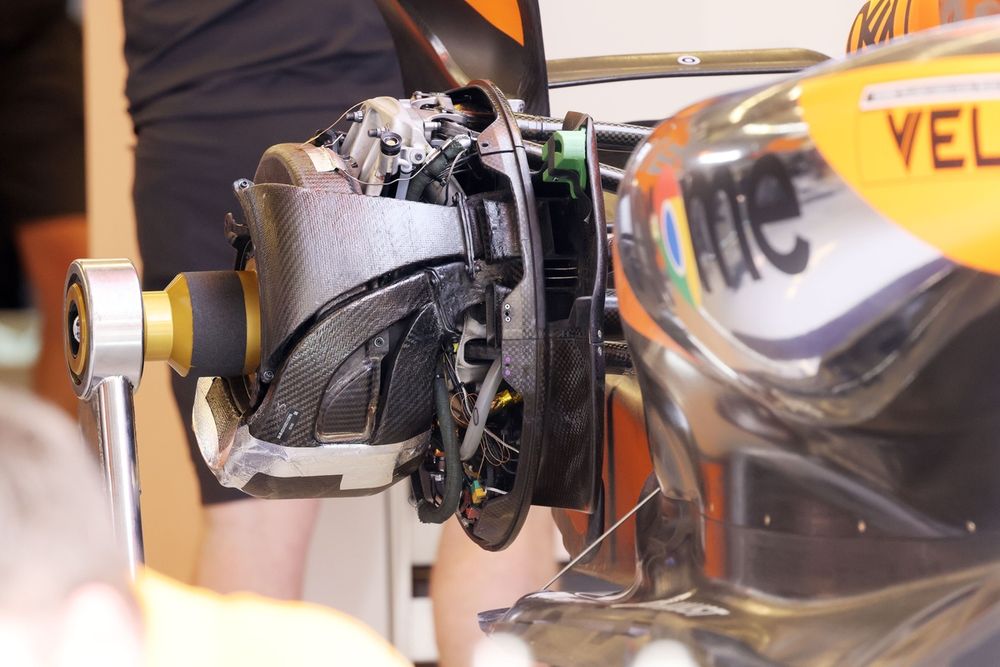
McLaren MCL38 rear brake detail
Photo by: Andreas Beil
The removal of the outer brake drums on the rear assembly of the McLaren MCL38 reveals the narrow brake disc fairing, crossover duct and double-entry calliper fairing solutions used to cool the various components that make up the rear brake assembly.
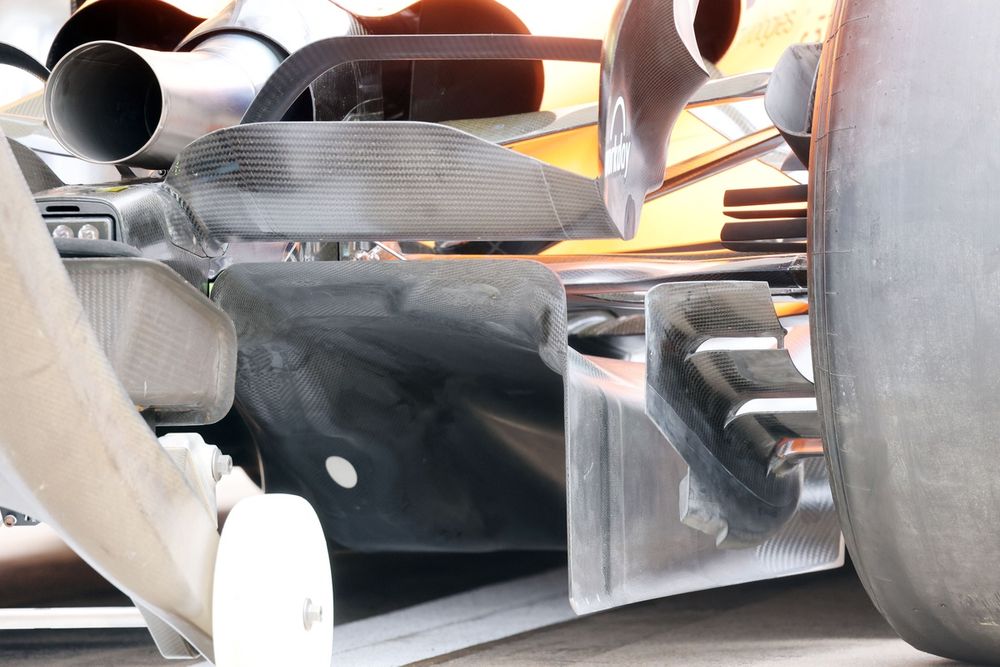
McLaren MCL38 diffuser detail
Photo by: Andreas Beil
A close-up of the rear end of the McLaren MCL38 shows the various contours employed on the ceiling of the diffuser and its corner, while it’s interesting to note the thickness of the lower portion of the brake duct winglet, which is also stepped and has the rear section cut away.
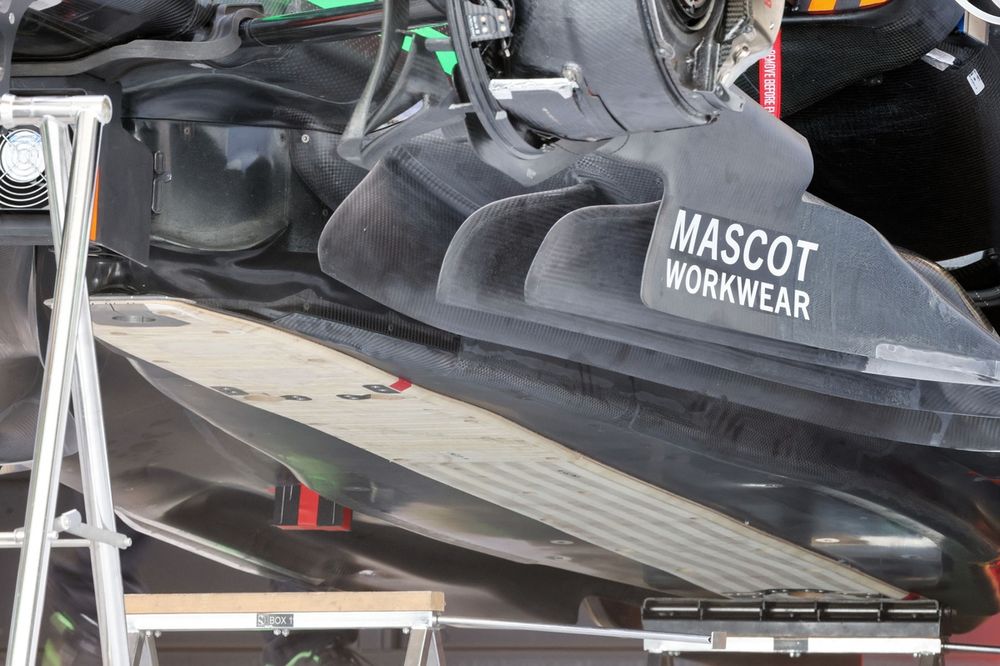
Stake F1 Team KICK Sauber C44 wooden plank detail
Photo by: Andreas Beil
Looking under the floor of the Sauber C44 we’re reminded of how long the floor fences reach back, as they’re routed to the outside front corner of the floor, while it’s also clear to see the contouring within the tunnel section.
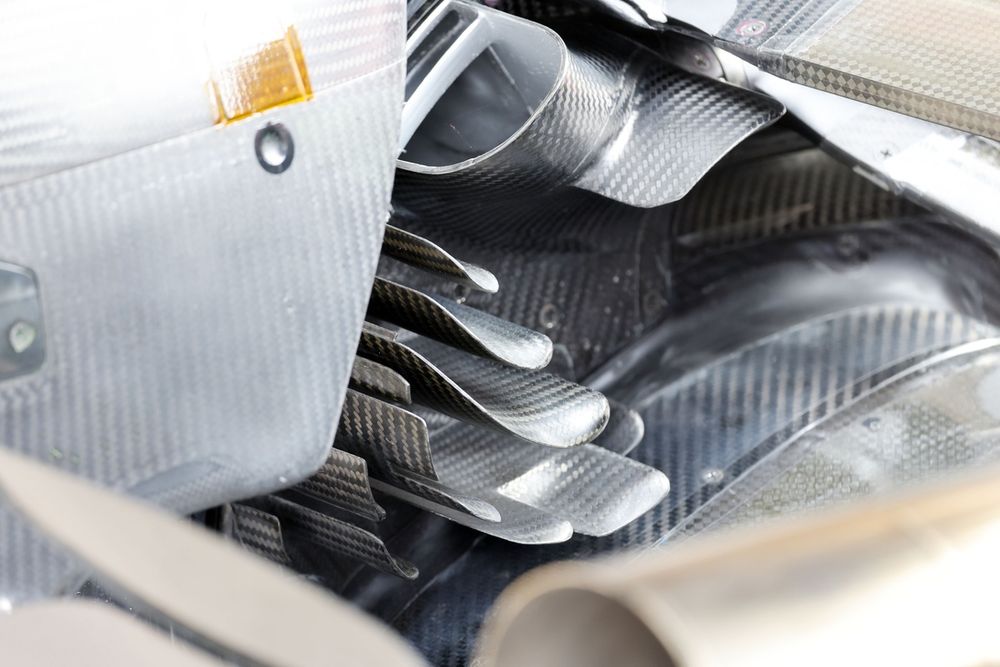
Ferrari SF-24 technical detail
Photo by: Andreas Beil
An excellent view of the rear brake duct winglet stack on the Ferrari SF-24 shows how intricately designed this area is and just how many winglets can be stacked into a small space.
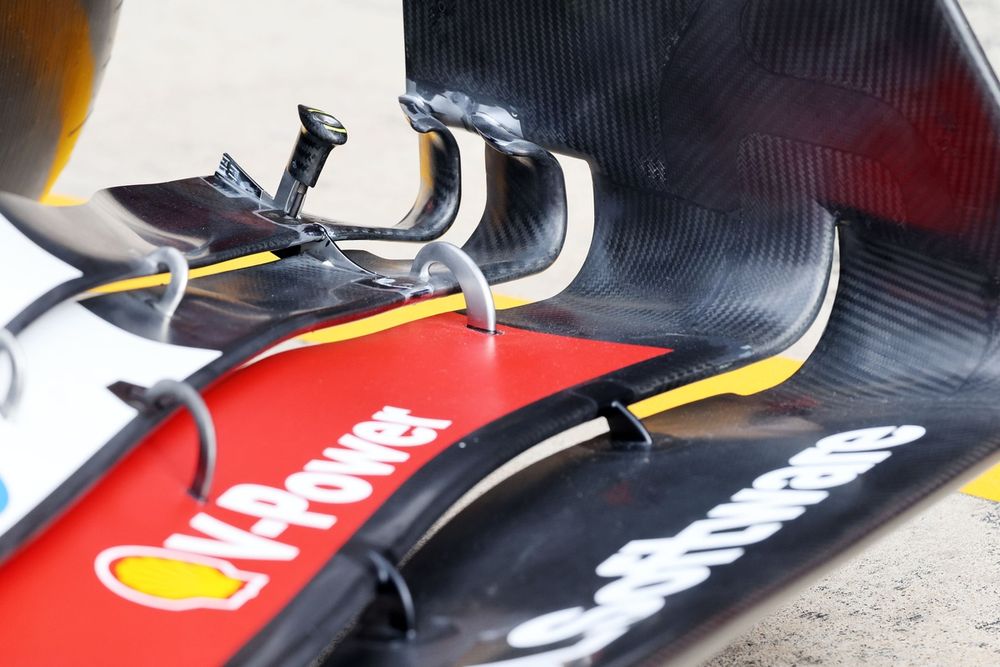
Ferrari SF-24 front wing detail
Photo by: Andreas Beil
The outboard corner of Ferrari’s front wing has the two rearmost elements keyed toward outwash generation, as not only are they a semi-detached arrangement, they’ve been contorted in order to alter the airflow’s passage around them.
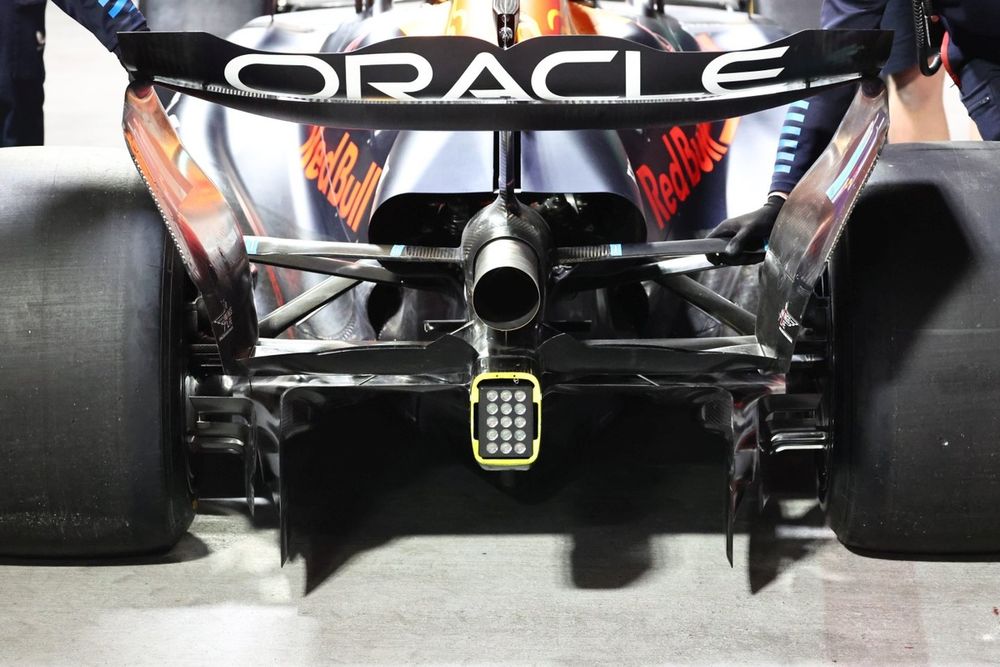
Red Bull Racing RB20 rear wing detail
Photo by: Giorgio Piola
Red Bull opted against designing and manufacturing a true low-downforce rear wing assembly for 2024, with the team forced to be creative when it came to trimming the trailing edge of the upper flap, in order to reduce drag for the Las Vegas street circuit. You’ll note that an equally well-trimmed, single-element beam wing was also employed.
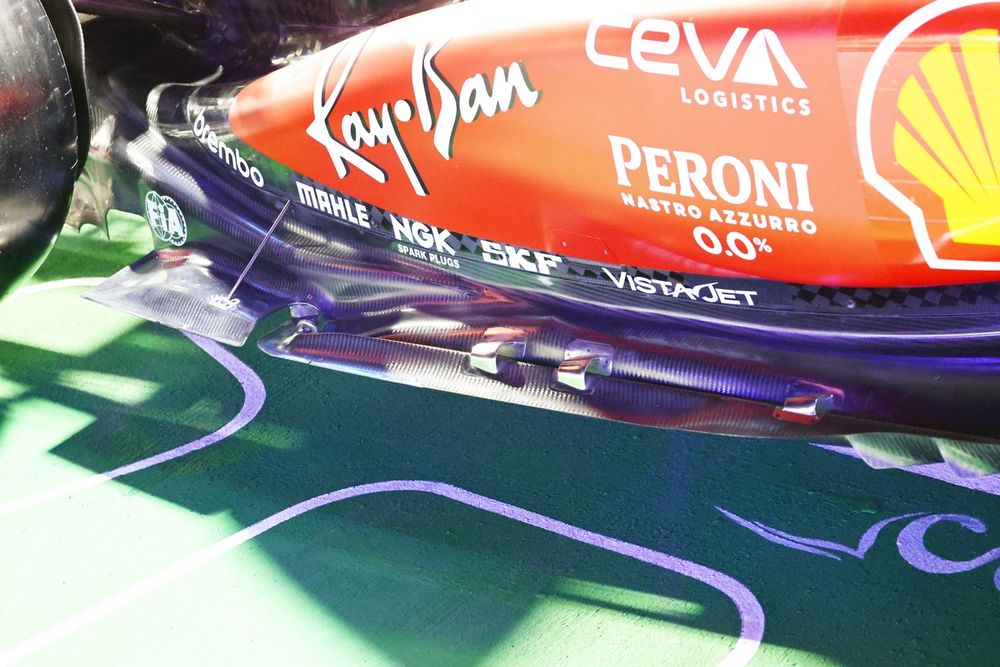
Ferrari SF-24 floor detail
Photo by: Giorgio Piola
Ferrari introduced an experimental floor at the Las Vegas Grand Prix as it sought answers on some design aspects that might be applicable moving into 2025. Charles Leclerc would later go on to race the item in Qatar, which enabled them to do further testing of both floor specifications at the post-season test in Abu Dhabi.
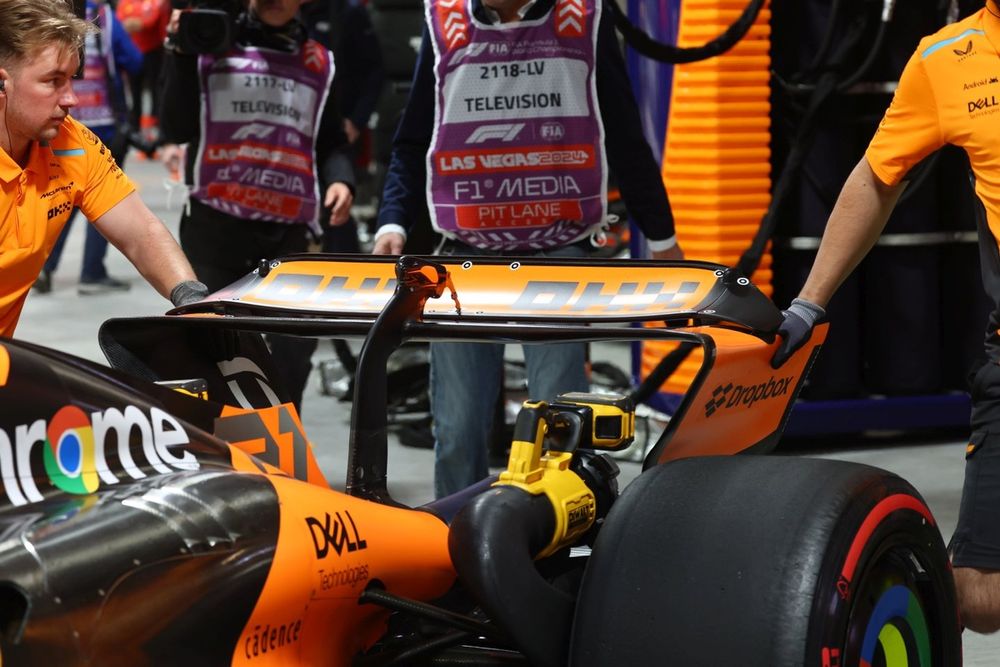
McLaren MCL38 rear wing detail
Photo by: Giorgio Piola
McLaren’s lowest-downforce rear wing offering of the season was utilised at the Las Vegas Grand Prix and featured elements that take up very little of the space allowed within the given box region.
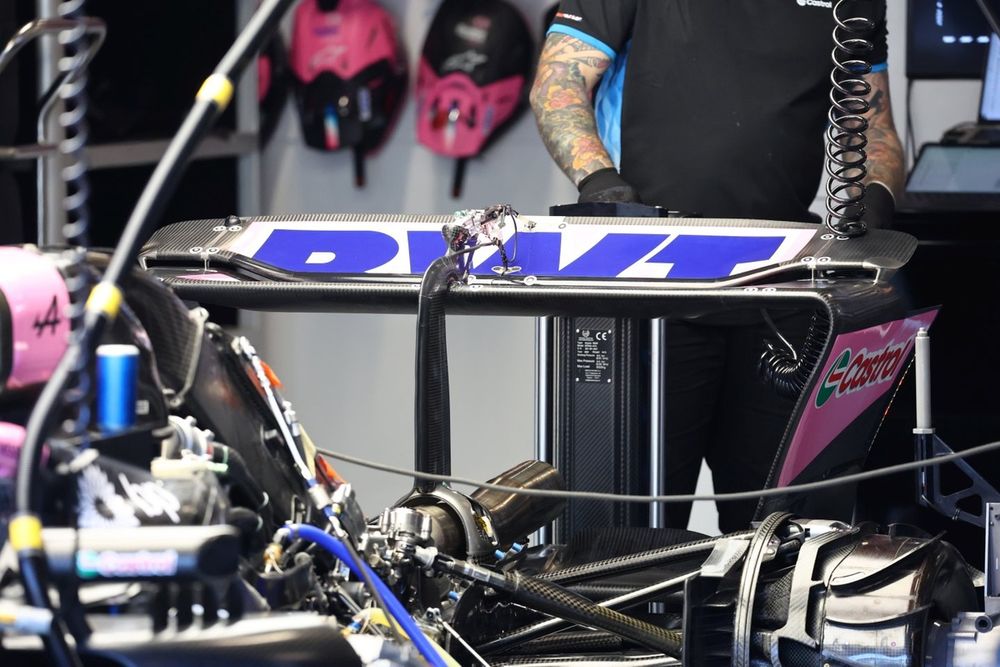
Alpine A524 technical detail
Photo by: Giorgio Piola
Alpine had a similarly small rear wing assembly for Las Vegas which can be seen here as the car is prepared for action. Note the exposed details of the DRS actuator too, with the pod bodywork removed, while the outer drum being displaced from the rear brake duct also shows the internal baffles used to alter the passage of flow around the assembly.
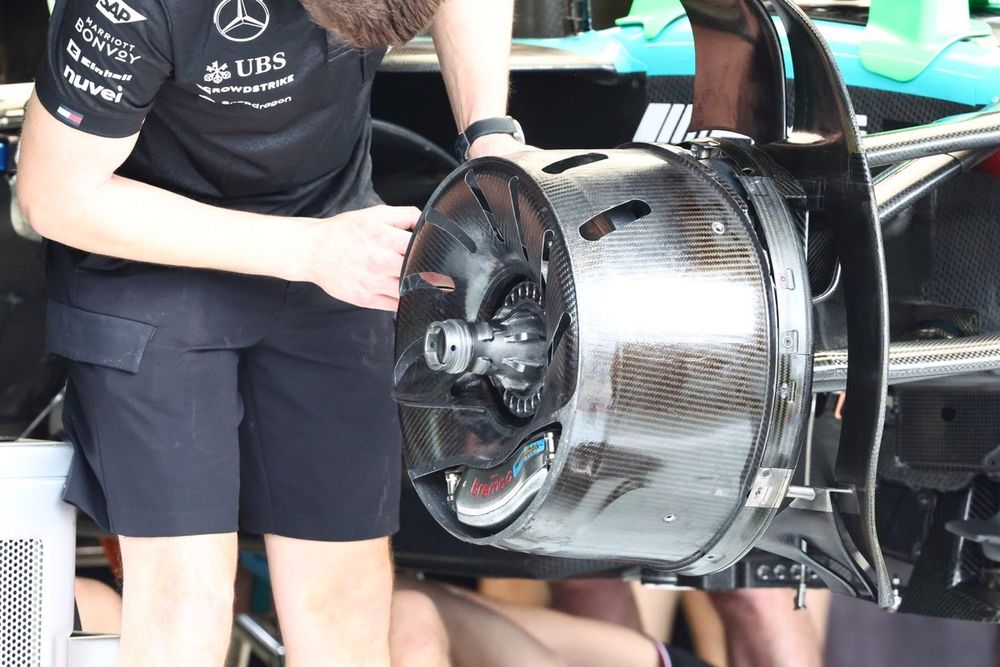
Mercedes F1 W15 front brake detail
Photo by: Giorgio Piola
The inner basket on the Mercedes W15’s brake drum featured several apertures that allowed heat to move between the two components.
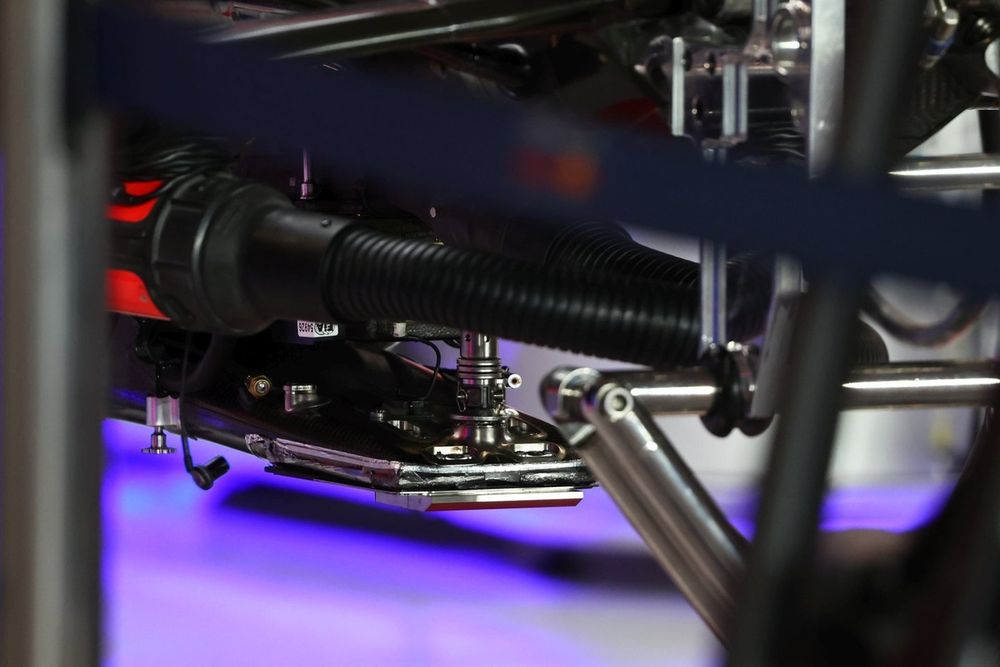
Red Bull Racing RB20 T-Tray detail
Photo by: Giorgio Piola
A look at the Red Bull RB20’s keel region without the bodywork in place reveals the spring element that bridges the gap between the chassis and T-tray.
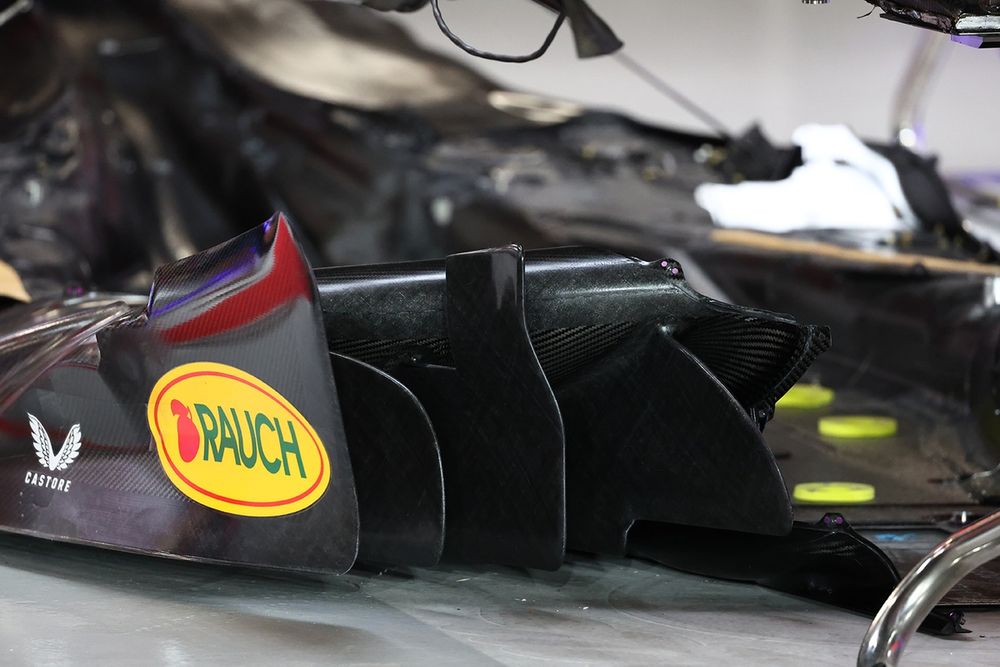
Red Bull Racing RB20 detail
Photo by: Giorgio Piola
Red Bull made changes to the layout of its floor fences at the Las Vegas Grand Prix, with the second inboard fence raised above the floor’s leading edge. It’s a solution we’ve seen from several of their rivals with this generation of cars, with Mercedes notably having a similar solution for 2024 already.
The taller fence will shed a vortex from the upper surface to help with flow conditions downstream.
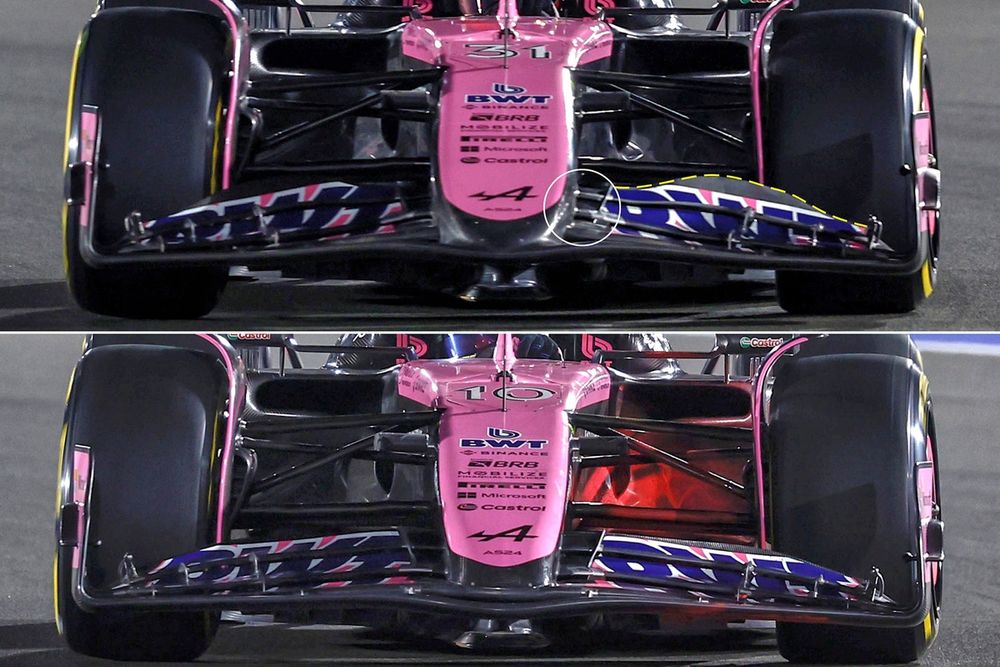
Alpine A524 Front Wing comparison (highlights)
Photo by: Uncredited
Alpine introduced a new front wing and nose assembly at the Qatar Grand Prix, as the team looked to get a headstart on understanding how those changes would impact them going into 2025.
The nose is shorter than its predecessor, with a much squarer profile as it sits on the leading edge of the second element, rather than the mainplane. The shape of the central section of the mainplane and the flaps thereafter have also been modified, with the proportion of the wing dedicated to load and wake adjustment altered as a consequence.
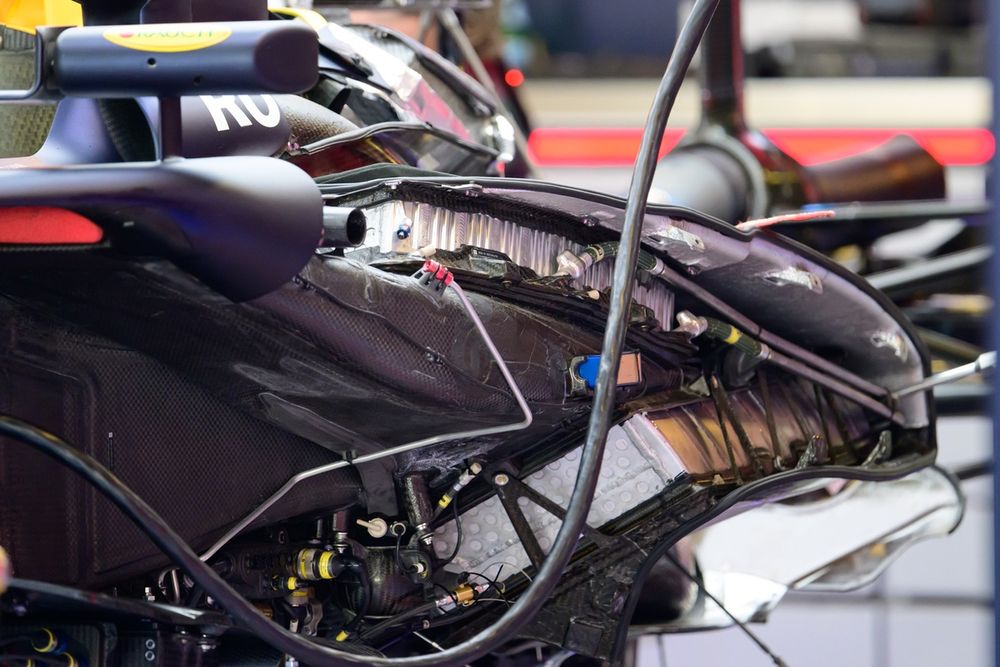
Red Bull Racing RB20, engine, detail shot
Photo by: Erik Junius
A peek under the covers of the Red Bull RB20 reveals the V-shaped and inclined layout of the radiator and coolers within the sidepods.
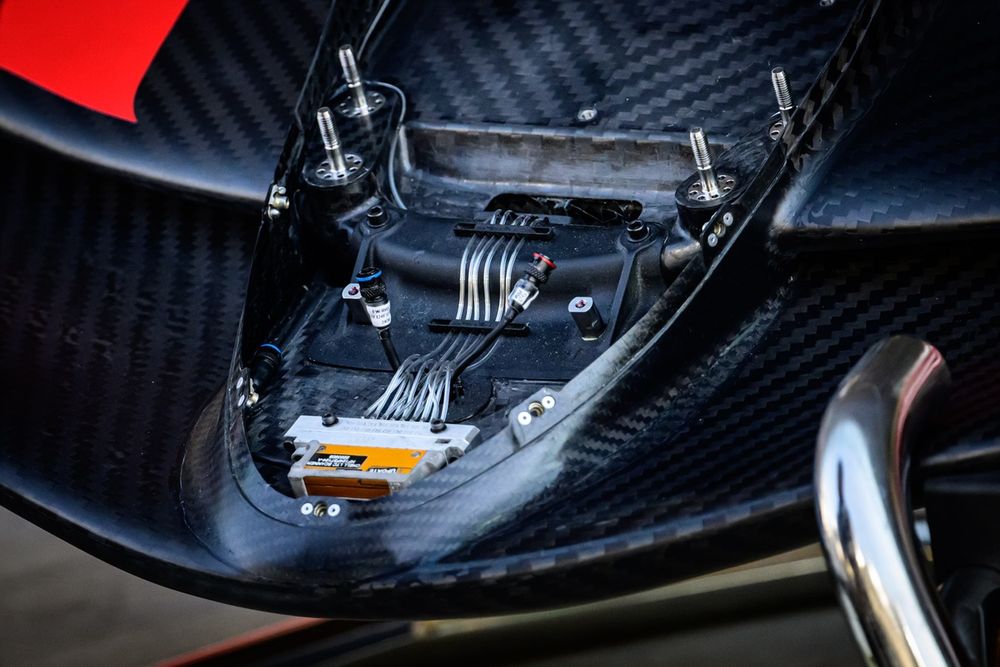
Haas VF-24, front wing detail
Photo by: Erik Junius
The Haas VF-24 with the nose tip section removed reveals the location of the pressure tap scanner, while the tubes are fed out to various points on the underside of the front wing. Also note the four studs which are the mounting points used to house ballast in the nose.
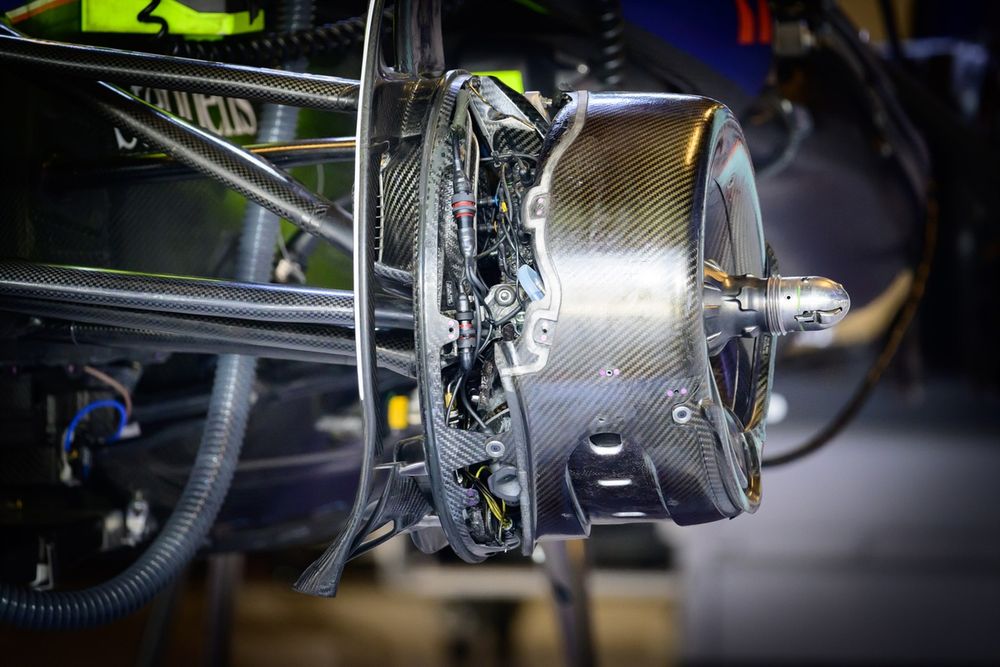
Williams FW46, front wheel brake detail
Photo by: Erik Junius
A look at the internal brake disc fairing on the Williams FW46, which envelopes the disc and wraps around and over the top of the calliper, leaving a window for heat rejection at the bottom of the assembly.
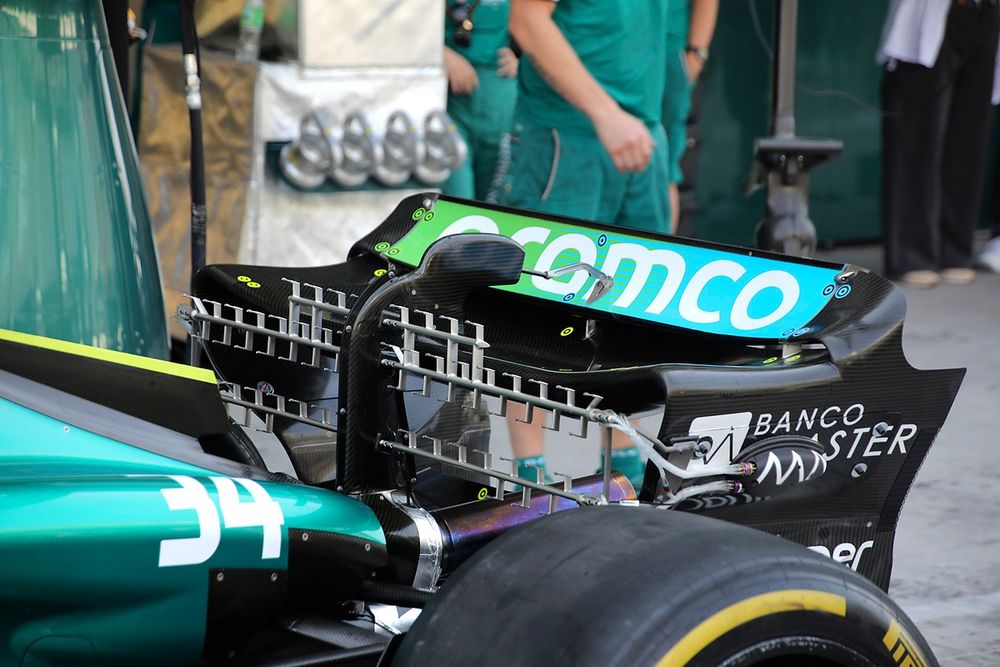
Aston Martin AMR24 rear wing detail
Photo by: Giorgio Piola
Aston Martin fitted a large kiel probe rake to the rear of the AMR24 in Free Practice for the Abu Dhabi Grand Prix, as it looked to capture data regarding the airflow’s behaviour as it reached the back of the car. Notably, the kiel probes are angled upward which gives an indication as to the airflow’s anticipated trajectory.
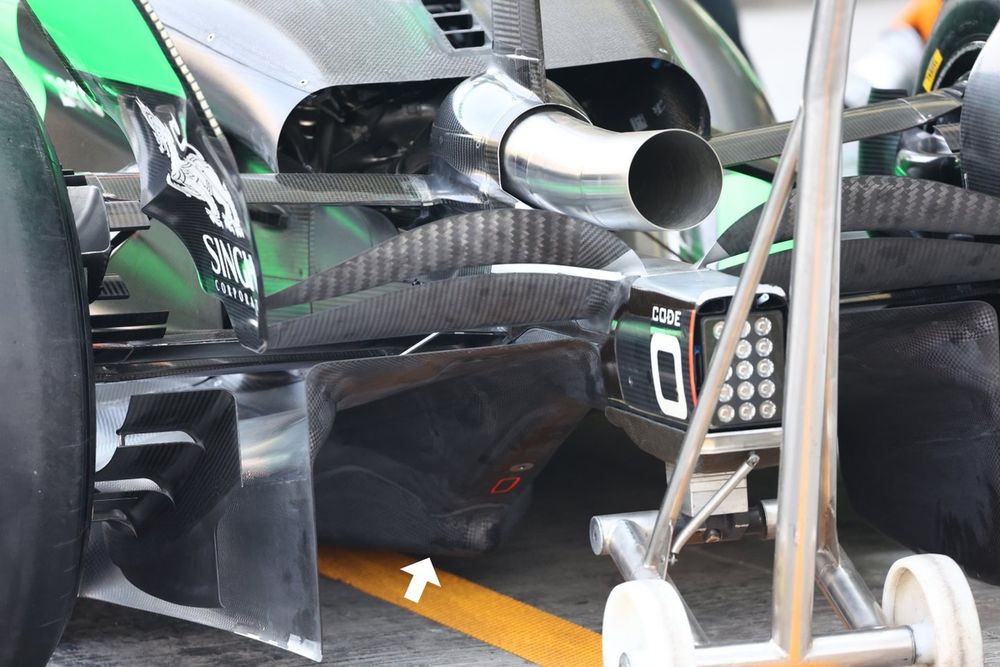
KICK Sauber C44 diffuser detail
Photo by: Giorgio Piola
A trend that emerged during 2024 is for designers to alter the shape of the lower boat tail section inside the diffuser, in order to alter the available volume and improve flow behaviour over a range of conditions.
Here it can be seen how Sauber has changed this section on the C44 with a section bonded to the original floor in Abu Dhabi.
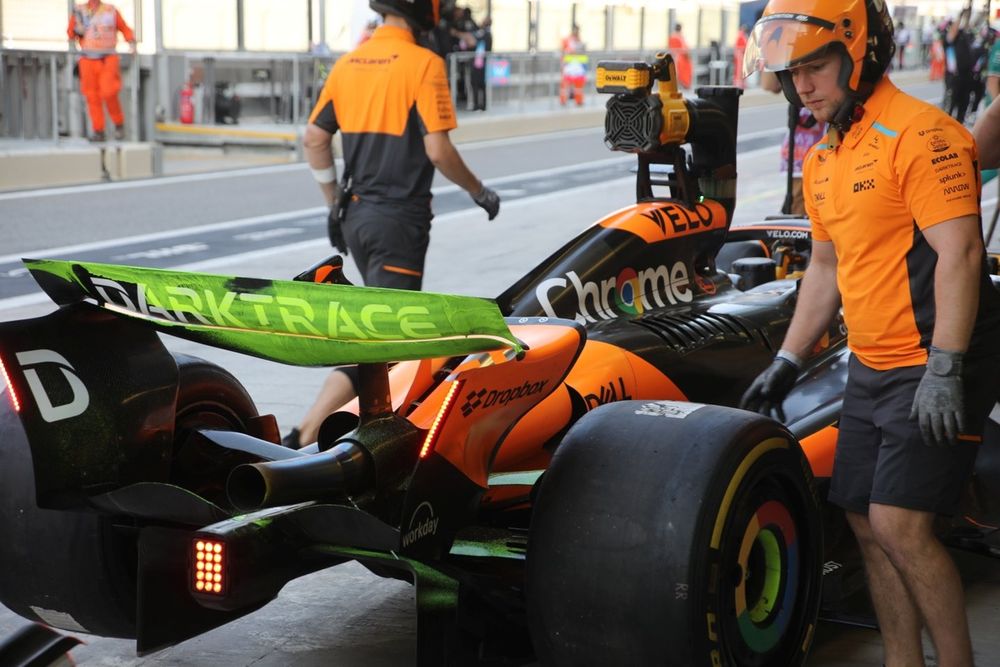
McLaren MCL38 rear wing detail
Photo by: Giorgio Piola
One of seven rear wings introduced by McLaren during the season, as the team looked to trim their car for the various circuit characteristics they encountered.
This rear wing assembly was first introduced in Brazil but can be seen here with flo-viz paint applied at the Abu Dhabi Grand Prix, as the team looks to establish whether it’s performing as expected when compared with the simulation data.
In this article
Matt Somerfield
Formula 1
Be the first to know and subscribe for real-time news email updates on these topics
Subscribe to news alerts
Read the full article here

